It is volume 20 (19 18 17 16 15 14 13 12 11 10 9 8 7 6 5 4 3 2 1 0)
This is a part of a raw and uneven journal of
digging into the writing systems from all over the world, so I
recommend you to read the summary of this work instead.
A B C D
E F G H
I J K L M N
O P Q R S T
UVW X Y Z
YZ have зачатки новой строки, в том что Y is I J as it goes in the I-line.
I J Z? z in this position reminds me the greek E F Z H Θ
E is Y-like in phoenician: 𐤀 𐤁 𐤂 𐤃 𐤄 𐤅 𐤆 𐤇 𐤈 𐤉 𐤊 𐤋 𐤌 𐤍 𐤎 𐤏 𐤐 𐤑 𐤒 𐤓 𐤔 𐤕
but then I see that it isn't, F is
Ω is also a зачаток of new line, and to my surprise I notice (not before(прежде, in the past)) seen)
how alphabetically it is named O Me Ga
If J in Y stands for labial ю, then in xyz x is from the previous line: uvwx (notice how here, like in yz, labials are also derivants of the vowel. Vowel and Consonant are the previous dualism: Vowel is hollow like hole, and thus female, Consonants are lingual and thus lingamic, male.
If J in Y stands for labial, then I J K is a complete A B C, then LMN is another line. And it revisits the hypothesis of triadic alphabet. And L is thus vowel? l~I
hypothetic I M N fell into I J K and L M N
Y ~ ᛘ ~ Ψ and just like Y Ψ is the second last.
YZ ~ ΨΩ
but neither zed nor zey seem to be alphabetic unless then it is eyz if y is labial ю the v, as in w being double you.
U вы (единственное число)
W вы (множественное число)
X ex? of somebody? ex-mine or ex-yours? but then it didn't make much sense in my model (why would you have second person before the third? because you would communicate first and communicate about somebody third third. So what was that thing about second person being consisted of first and third? A misconception, maybe? Pronouns of the second person had similants of pronouns of first and third person, because it is a transitionary form, ты пренебрежительно и кто знает, может изначально таково, плевок вместо поцелуя,
A, hey, I привлекает внимание. Я! я здесь!
V & T is literally the opposite and the alphabet places them like that.
It is interesting that russian Я is the final (as if it was placed there by those who placed V & T in the end of their own alphabet, thus setting the subordinance relations, and english I is in the middle, and it's funny that they placed some A, the third person at the top of their one and in russian it used to be Aз the first letter used in speech for where they place Я today. So it seems as if whoever invented alphabet spoke slavic language, with A as the beginning of the alphabetic poem of I am
I aM NO P Q R S T
U V W X Y Z you vse ymeete znanie (or imejte snanie or znaki or zvuki, z seems to be all about it)
Did putin prepared ground for including V and Z into russian alphabet
A B G D
E V J Z
I M L N
O P R S T
U F X Ch Sh Sch
I think I had great ideas for orthographic reform, this one is not going to be included amongst them, it cannot compete with those perfect symmetries. Let's try to reinvent it:
A B G D
E V J Z
I M N L R
O P K T (Q is the stylistic substitute of K and a female shape of it, thust telling that ᚴ ~ C)
U F H S (H is read as х[h] because it's fricative of K, and as ч[tʃ] because it's voiceless J, and thus
voiced h and ж are the dialectal variants of the same idea? жара была звуком изнемогания о жары?) жарко ~ hut hot
And I am pleased to see that they're 21 letter.
And I also like that latin alphabet seems to replace them, so what I have in E they have in U and what I have in U they have in E (E and U are diacritized invariants in ugaritic alphabet. ю~ɪo~ё)
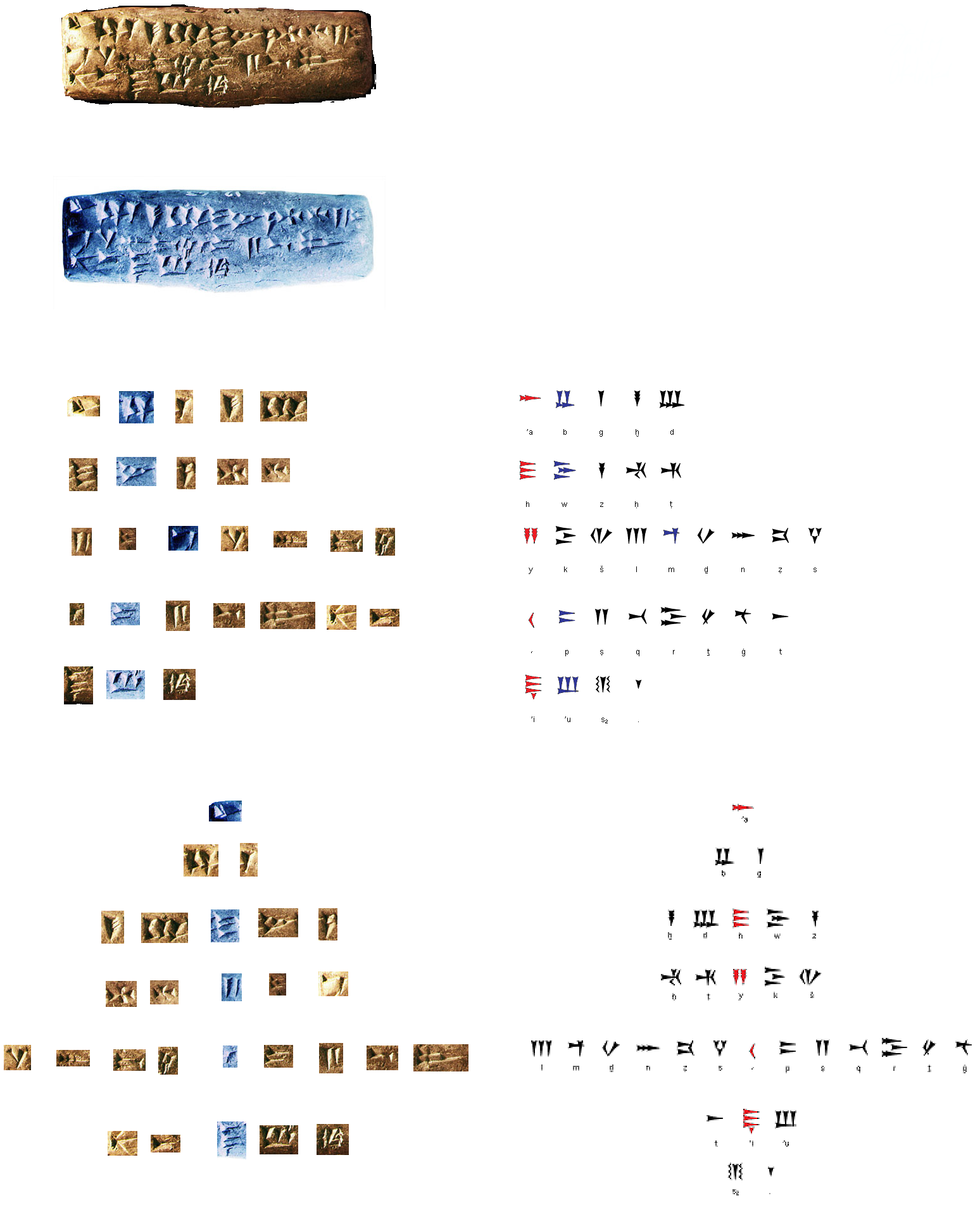
I suspect ugaritic to be under strong corrupting influence of semitology, but because the structure is the same, I recognize what they see as h to be e and what they see as ' to be o and what they see as 'i to be u
имею ~ ем
have ~ хаваю (mnemonically that is how I memorized that word)
devoir ~ devour
univerbation.. oneword
хан ~ king
some interesting two-syllable word came to me and it had хан in it, and it even made sense.
king queen are two ways to write the same word? Male line is voiced, felame female line is voiceless? Did women wisper whisper? not to attract attention, for example.
(I've no idea why I thought of k as of a voiceless letter, other than it standing in the sonor line, I dunno)
(other than that I was high af)
whisper is another wh word which is not a question word such as which for example.
white is the other one, and probably white is all about why? Is whyte's main characteristic was that they could ask questions?
pyro ~ fire
Обязанность русских (и всех к ним примкнувшим) доставить коммунизм, доставить как мессия, на которую миссию мы писанулись, втянув и другие народы в это безобразие за собой. Наступление коммунизма это предсказание, но заставить его сбыться силой было сильно. не слишком умно но сильно, но предсказание сбылось (оно исходило из_трендов, я предполагаю, и как они считали И
Дабы не расстраивать тех, кто нам поверил. Сегодня мы держим их где подкупом а где силой, на пиздёж коммунистический быть может тоже кто-то ведётся до сих пор (какие-нибудь кндр, например, но там тоже силой, но силой коллаборационистов, как я предполагаю, и снова меня сносит. выплаываю в серый
Дабы извинить тех, кто его силой насаждал, потому что они тоеж поверили колдунам-болтунам, таким как мне, но я хороший, а они.. сновап сносит
Индуцированный психоз переносит вину на инициатора, индуктора.
(и это амнистирует всех преступных как невменяемых (не в себе) обезумевших, но тогда и брутальных преступников следует ..слежки с наблюдением (за счетами, перемещениями) искусственным интеллектом. но как оградить их от соединения людей и острых предметов? изоляцией, посажением на цепь? тюрьмы если сделать комфортней, то конфликт интересов (безопасности и гуманности доброты)
доброта = добро ты, добро та (а добрая добро я?)
Технические возможности здесь.
Письмо Вождям Советского Союза содржало в себе повесься
Письмо Вождям Российской Федерации содержит в себе поверив
Письмо Вождям России содержит в себе ПоВеРь и PoWeR
Power Поверь Pray Повеляй (will) will~word? word is willed? not capsule, give me a truer word. Womb. a better word! Give me a better word! Bath? Sphere. Твердь. новое слово для нового объекта, Wap.
I had such word in previous ideas: wap looks like russian шар (ball) But I need the antiball. The opposite of ball? The inside of a ball. A ball. Exactly. A rubber ball!!!
Water Filled Ball To Live In
wfbtli
liquid ball? LieBe Lee Be leebe
rubber shell.
wfb to li
t ~ +
go to win ~ go and win
want to feel it ~ хочу почувствовать это (в русском to выбрасывается, а может потому часто в английском to & of не включаются в аббревиатуры: Federal Bureau of Investigation.
The United Nations Educational, Scientific and Cultural Organization excludes the and and.
WWF is World Wide Fund for nature (they literally excluded nature, they're everywhere, but I think it's the hint that they don't do what they claim to do, but then it's only a guess and offensive guess as well, but it's a demonstration how wild assumptions come and then if we test them they whether fall of or stay, to my gut feeling they usually stay, but just as I heard that unicef attracts predators to infiltrate into it, I suspect WWF to be corrupted at least to some extent, even if they were not invented with such obscene abbreviation for some corrupt purpose (forests are cut out, they don't seem to be doing shit other than advertising their logo as if they're the number one thing.
politics, off... I have some better things to do.
Spheric home.
minihive for me
Personal Hive
Human Personal Hive
HoPe would be a sick abbreviation
HuPh
Дом из Четырё1х Шаромв
Individual.. it doesn't matter.
Autonomous, it's a good vowel
Biologic, it's a good labial
Home.. it's a weird C
ABH? ABN would be better. ABD autonomus biocentric domes
bio..somethig. biocentric would tell that it's focused on biologic demands rather than order of convenience or tradition.
ABC AutonomousBiosphericCabsules(or cabinbets. cabins)
Cabin. What I need is Cabin. My cabin should be of whatever shape (concrete rhombic dodecahedrons, rubber balls filled with liquid and equipment, рукав плотной плёнки в нейлоновой сетке. Этот вариант самый простой, надо испробовать его в первую очередь.
AutoBioCabin
АвтономныйБлочныйГороД
BioCabin
Ba (Bath BiologicAutomat Ball Base)
First I invente Ba, bo and bu seemed sad, and ba was also free, the closest is baa, but I have just ba, and so sheep doesn't say. surprised people do. And rationalization is great, perfect, I wonder any syllable could
Ma
Me
Mu
(mama, me, cow: could be the order in which to save lives)
B for baba (mama)
C for cow
(me would be by default or like A the Аз, I as the first letter)
I M K? I Mom Cow? Конь Коровы Козы, сКОтина, СО as in sobaka? Кот, собака сама тебя спасёт, её спасать быть может реже надо, это она помогает тебе dog and god have some connection.
D for daddy
E F G H could be something completely different and in some completely different language. I is Inglish
A В С could be russian: Аз Вы Се(сей, сии, сия, сиё, се, т.е. це. iT, То)
О П (Q) R S T (some other language, T is also in That~тот (in russian th and t are the same word)
the = те, и буквально это когнаты. cognates
bellicose causes bellum
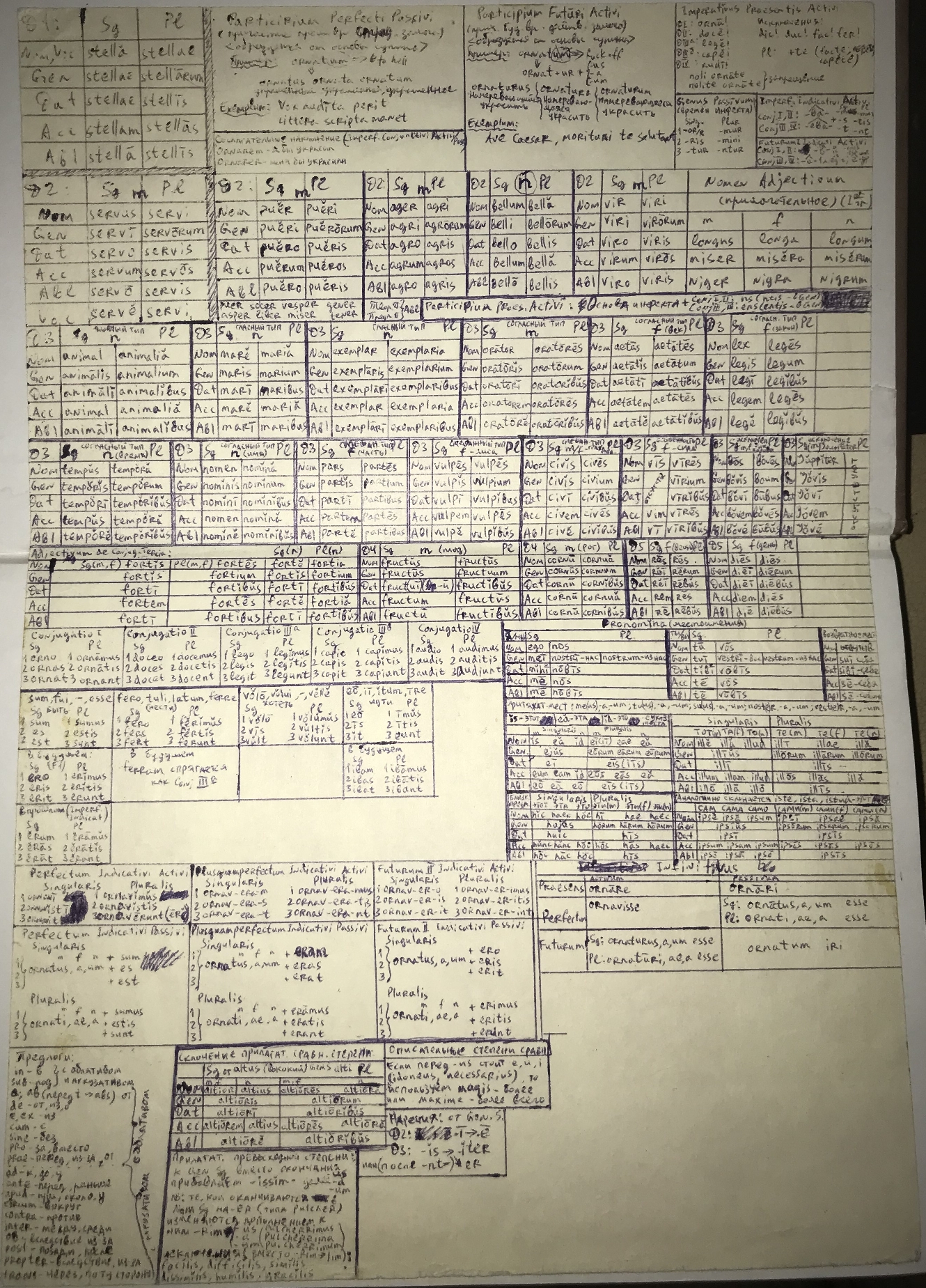
monstrance (in the Roman Catholic Church) an open or transparent receptacle in which the consecrated Host is exposed for veneration.
Sacramental bread, also called Communion bread, Eucharist wafer, the Lamb or simply the host (Latin: hostia, lit. 'sacrificial victim'), is the bread used in the Christian ritual of the Eucharist. Along with sacramental wine, it is one of two elements of the Eucharist. The bread may be either leavened or unleavened, depending on tradition.
Leavening is the process of adding gas to a dough before or during baking to produce a lighter, more easily chewed bread. Most bread eaten in the West is leavened.
magis more (mager, -is, ещё? yet?)
maximus (magest, -simus, самый!)
yet = ещё = есть = is?
yet = ещё = есть = is? = yes!
is am are could be the
Are aM iS
a, someone (he~the, in the past probably for plural third person, the~they, thee is one of them. they, the aye? theы!)
me мы
IOA of Iehowa, Ehioua would be more more alphabetic
EiouA is the sequence jews preserved. Or have they perversed it?
have instead of did allows -ed'ed form.
in ukrainian в is used instead of л (which is used in russian) more than only in the verbal suffices:
Нам потрібна потужна протиповітряна оборона – сучасна, повністю ефективна. Яка може дати повний захист від цих ракет.
можуть demonstrates how ж is к is г
г 1
к 2
ж3
maggie is г instead of дж which g could be by default, and г could stand for voiced k, which is never h, only when it's without the upper stroke it's h. but then it's a weird subject.
July August September October November line up into JASON
DJFMAMJJASON only contains some MASON in it, but also MAMON, MAMA, MJ, MAM & SON
so it could be fucking nothing.
I had a thought that IEOUA could be EIOUA could be another frame of the loop of AEIOU
and that also could tell that B is the first letter, leaving the first vowel to be E, as A is sometimes read, btw. a could be e? is a upside down e? and via ʌ being the upside down v[u] it relates 𐎅 to 𐎛 to ю to ё
は is structurally ha, and is transliterated as such and sounds as such i n most of the cases, but sometimes as wa, which resembles -го (used to be written -га) read as -во, actually -ва
au AV of aum tells that in IAU AIU whatever you put it A is up, V is down, so their positions are explained by their form or rather their form is explained with their position.
Древнейший римский календарь содержал десять месяцев, причём первым месяцем считался март
Der älteste römische Kalender enthielt zehn Monate, wobei der März der erste Monat war.
Den ældste romerske kalender indeholdt ti måneder, hvor marts var den første måned.
The oldest Roman calendar contained ten months, with March being considered the first month.
It explains why decembre is (decabr in russian) of ten, deca.
And if March is the first month, January and February are inserted months when they went to use 12-month (Julian) calendar (probably then they named some month July and August after that, August is Ceasar's son, so it was made at once, for such personality cult he naturally deserved to die.
It wasn't his son, probably a lover:
Хотя Октавий не смог отправиться в африканскую экспедицию Цезаря, полководец пригласил его поучаствовать в триумфальных торжествах 46 года до н. э. При этом Цезарь определил его на почётное место — сразу за своей колесницей, и даже наградил его наравне с настоящими участниками кампании[29]. С тех пор Октавий всё чаще появлялся вместе с диктатором на публичных мероприятиях, из-за чего многие римляне стали искать его расположения и просить ходатайствовать по их делам перед Цезарем
his complete name is.. Гай Ю́лий Це́зарь Октавиа́н А́вгуст
(for whatever reason, english wiki doesn't give it (actually it does, but in the depth of it: Gaius Julius Caesar Octavianus. He took the name of his adoptive father, Julius Caesar, but was often distinguished from him as "Octavianus" (Latin: [ɔktaːu̯iˈaːnʊs]), the adjectival form of "Octavius". He is mainly known by the anglicization "Octavian" (/ɒkˈteɪviən/ ok-TAY-vee-ən) for the period between 44 and 27 BC.[8] Officially, he seems to have used simply "Gaius Caesar",[9] and began styling himself divi filius or divi Iuli(i) filius ("son of the divine Julius") after the deification of Caesar in 42 BC) but tells that Juluis Ceasar was his adoptive father and his maternal great uncle. it's truly complicated)
Imperator Caesar Augustus: Following his 31 BC defeat of Mark Antony and Cleopatra, partly on his own insistence, on 16 January 27 BC the Roman Senate granted him the additional name "Augustus" (Latin: [au̯ˈɡʊstʊs]). Historians use this name to refer to him from 27 BC until his death in AD 14
Чтобы восстановить соответствие календаря временам года, Цезарь вставил 67 дополнительных дней между ноябрём и декабрём, разделив их на два месяца: intercalaris prior и intercalaris posterior. Вместе с mensis intercalaris 46 год до н. э. длился 445 дней[2][3].
Цезарь переименовал месяц квинтилис (quintilis) в свою честь, дав ему имя iulius (июль). Месяц август был назван в честь преемника Цезаря Октавиана Августа. Впоследствии несколько императоров называли месяцы своими именами, но только названия июля и августа дошли до наших дней.
quintilis is of quinta, five, which makes sense since decembre is of ten.
june is of four? what was its roman name? quartilis? not many related finds about it..
Квартиль стат., матем. значение, ниже которого лежит часть выборки или распределения вероятностей случайной величины, кратная одной четвёртой (ноль, четверть, половина, три четверти или единица) ◆ Центральное значение есть медиана, другие называются нижним, или первым квартилем и верхним, или третьим квартилем, т. е. Q1 соответствует тому значению, которое стоит в конце первой четверти упорядоченного по величине ряда; Q3 соответствует концу третьей четверти этого ряда. Лотнар Сачс, «Статистическое оценивание», 1976 г. ◆ Первый квартиль — это такая точка на шкале, значения меньше (либо равные) которой отметили 25 % опрошенных. А. О. Крыштановский, «Анализ социологических данных.»
часть выборки между двумя квартилями [1] ◆ Что касается совокупной оценки условий ведения бизнеса по всем показателям, то Россия оказалась в третьем квартиле стран «большой двадцатки», вместе с Бразилией, Китаем, Мексикой и Саудовской Аравией. «Повестка дня», 2013 // «Эксперт» [НКРЯ] ◆ При «продвижении наверх» разрыв увеличивается: в верхнем квартиле он равен уже 26 % , а в высшем дециле — 39 % (от заработка рабочего). «Положение и борьба британского рабочего класса: сборник статей», 1974 [Google Книги]
aeon ~ aeou
цибуля ~ це ballя
це зелёный? z
I suspect some dugin to read my work so that they used their dialectic synthesis and came with Z logo for their shit show, and if they didn't try to steal true knowledge but offered me to work on it.. I would say no, and then they would have to what? have me killed? arrested until they start their shitshow so I don't tell? Алый Белый~Blue Зелёный~Green
Зелен is cognate of green, omg, z is greek g
y-grek, z is also greek.
UVX is all there is? They say XYZ is one thing, the greek notation? But I think I read the first lettters of the alphabet being used for constants and letters from the end of the alphabet being used for variables was invented only few centuries ago by.. I don't remember whom, Descartes or such.
Following René Descartes (1596–1650), letters at the beginning of the alphabet such as (a, b, c) are commonly used for known values and parameters, and letters at the end of the alphabet such as (x, y, z) are commonly used for unknowns and variables of functions.[2] In printed mathematics, the norm is to set variables and constants in an italic typeface.
notice how rare xyz are, only one adjective adverb has y in those two lines. only is also an adjective adverb..
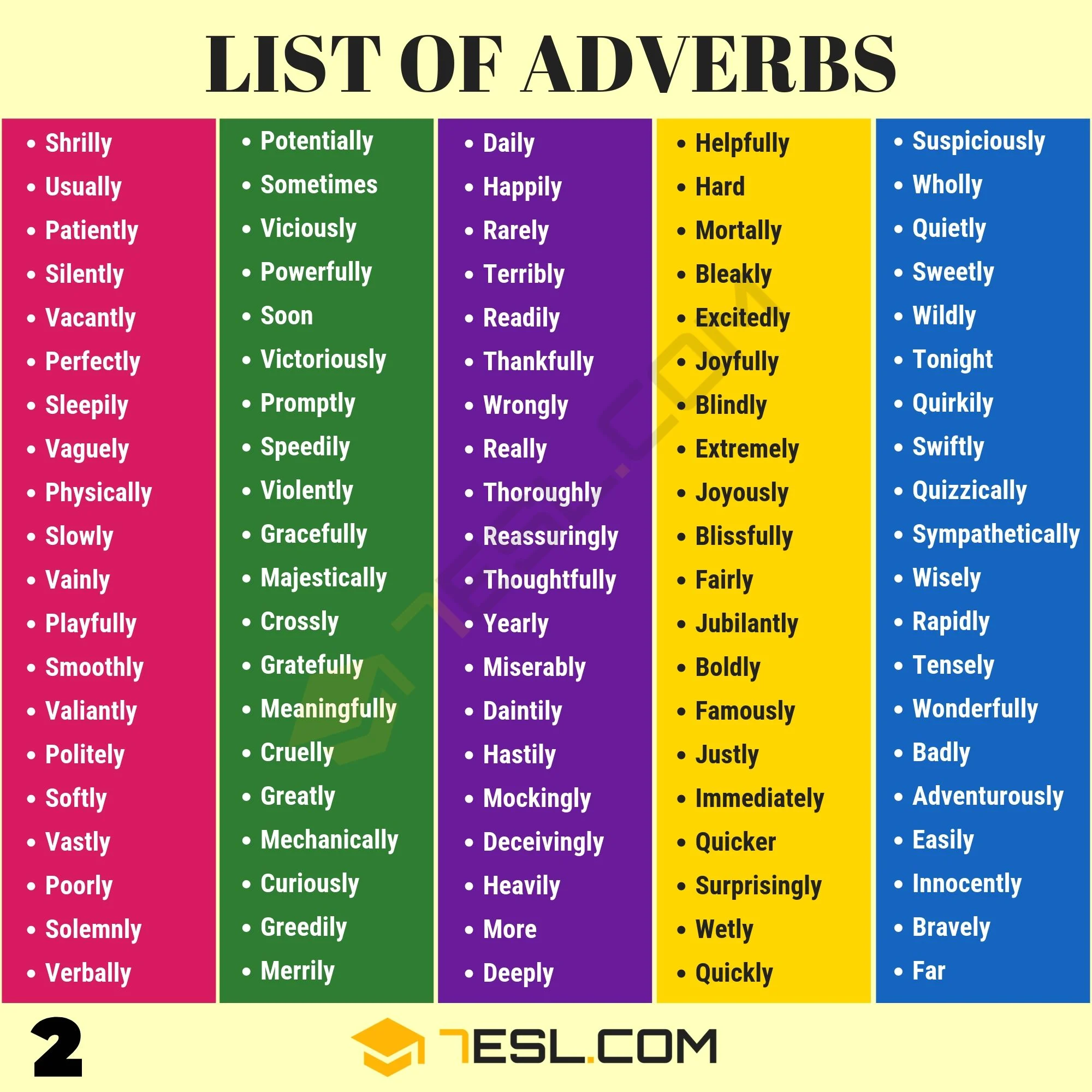
now with a logo it's a real commercial, but because most of those original image hosters are non-profit, I don't expect them to pay me for it, but then I expect them not to sue me for it, because I promote them and because otherwise their law would curb the progress, which is counterproductive for everybody.
And the question here is why ad-verb, if all those greedy, quick, brave and merry (probably many in the case of more, but then more could be out of place, being something else with far, quicker, hard (har'ed? highered (повышенный, hard, как повышенный план is hard plan, and raised objective is harder to reach for a jumper for example, for businessman high goals are those you have less competition towards to, it shuold motivate and it stimulates)) are adjectives
sometimes, soon, tonight, I think they misplaced them here, they're not adverbs, because all adverbs are made with ly (russian ли? (ne, ma, desu ka)) But then I see I'm wrong, adverb is a large category, all those time words seem to belong in it: overnight, quick (but I insist that quick is short for quickly, quick is an adjective, sometimes used as adverb, colloquially, not very цщепетильно, should belong to other group of words not to confuse the students they should be all specified.
Each word can be anything depending on the context: skin is both verb and noun, and if we start using it instead of quick, for example, it will become adverb, it can be adjective when it's skin face for example or can it be a preposition? skin there instead of in there? It is not used as preposition, or rather less likely used like that, most would think it meant skin the noun, as if command was to put the skin in there as if the in was omitted, we wouldn't recognize in in skin. сок in there? соса и кака, сися (жижа) кака как кость. с как мясо? еда снедь сок тоже сюда же, к как кость, камни, ..сук сок? ломали ветки берёзы чтоб пить с неё сок? до того как ножи стали в моде.
just as r reflects L, so does Г and I saw Low in L and HiГh in Г, h in г, or rather г in h
абд
eвг (г[ж] e=он/она? е'го ~ е'ё are they two ways to read the same j? g?)
efh ~ evg?
абы (отца) уД
евы (бабы, мамы, её) Жо
папа от мымы отличается лишь твёрдостью? сегодня глухостью не Б, но М противоположна П~Ф
b and v are dialectal variants of M, because ams, amt, i.. и всё
LMN ещё
MYS ~ myth ~ missed ~ passed? m~p? but then why russian т is т in cursive? b~d? see roman cursive.
батя~дядя?
ба in батя is ма? батя мамин дядя
B & T
let's place these two stones into the basis of my building. And five vowels. one vowel at first. Three roots they're. Greek myth as the most ancient? No, hebrew myth is even more ancient. Whose myth is more ancient than hebrew? Norsk myth could be. Unless they were initiated into hebrew myth and went inventing the prehistory from there. So three mothers become not only matters but also literal three deities, but then that myth is wide-spread (unless I was fooled by wiki, wikka, witches учат. witches watch, disobedient, don't lower their eyes.
's used to be a sillable? is? si? si~yes, si is also сей, сии in russian. + (that + appeard there by istself when I dozed out thinking about something else just after I put that dot)
this ~ the is
dot ~ spot
точка. сбочкой? нет, спот ис of space, related words,
моя жизнь имеет мало смысло, если не делать мои открытия знаменитыми, слава придаст смысл, слава~слово, keyboard making me switch scripts to english to use ~ recommends me to use - instead, I very poorly use this part of the keyboard. Because I only recently learned 1234567890 and right hand knows it poorly, only left does, mostly first numbers are used I guess, 0 is middle finger, the other two fingers I hardly know how to use. - is right ring finger. I hardly ever do.
где слово там и смысл. как слово (то что все сочтут словом) имеет смысл, причём часто несколько, используемое по всякому.
Какое слово я могу о себе оставить. Слово о путешествии в основание письменности.
Легенда гласит о дереве напрямую связанным с письмом по тому, что норны вырезали руны на её корнях. А корней тех согласно тем же легендам было три, т.е. три руны как в той игре, это было юю .. означает что трёъсложное правило, известное в еврейской грамматике (остальное суффиксы-приставки как правило, двухсложные слова считаются древними (так меня учили.. учили ли? это непрожаренный кусочек, поработай с ним) и вплоть до двухсложных вроде разбирает иврит в своей "от буквы к корню" Йорам Лемельман.
Почему я с таким пиететом к этому нигеру? еврейская община мне помогла им больше всего, и научили меня основам иврита, но я
traitor is infiltraitor
in fill trait (стать недостающим звеном) infill trait or(ель, или. er~or, err~or?)
trait = характерная черта. trait = to rate? rate is probably disassembled even further into ray and te of to or -ed or russian verbal narrative's plural suffix and thus те would be thee or something, but thee is.. is it ..did it change its status with some superstrate understanding it and substituting it with theirs?
Suddenly.. how old are tribes? Were they living in their animal state as tribes, acquiring language as they could in complete isolation, until they stopped killing intruders and thus could have intercultural bonds and understandings.
теории заговора противостоят практике заговора, и раскрывая эти практика становится их врагом, оттого быть может Тревор Моор рано ушёл, оттого и меня с моим вскрыванием
крыть как противоположность рыть
вскрыть противоположность скрыть
в и к отрицательные префиксы?
рыть крыть скрыть (ck~k) вскрыть
вс~от? взобрал отобрал? нет, от = у тебя? может быть. вс = в себя, от = у тебя? у тех? у того? у т(чего-то, где-то, 𓏏)
оторопь.. топь.. копь (устаревшее торопь от торопиться)
оторопь словно даже не поторопился а оторопился, как оступился
крал противоположность слова клал
брал противоположность слова блал? ложил положил?
врал ~~~~~~~~~~~~~~~~~~~~~ влал? велел? just a coincidence? that крал и клал?
вливал? a coincidence, faux pas, palse path, go somewhere else.
Let's return to where it was good.
si ~ yes
this ~ the is
this ~ it
is is it?
it is ~ is it
das ist ~ ist das
das ~ dat ~ that
ditNL = this, it
datNL = that
welcheDE = which
welkeNL = which
ч = лк? лх? как в слове лехко?
soft has two truly soft letters but it's ended with hard t, but what is that t is -ed? then it's sofa'ed, which makes perfect sense. Sofa is the root of soft. Soft is as sofa.
only is to one as lovely is to love.
pr could be (farts with lips)
p s t could be three clicks
pr qs tu
pr губной
qs tu язычные
I transliterated them arbitrarily, alphabetically,
pr пёрнул
qs усмехнулся кс x сравни qs to x in the next line
tu сплюнул, ц
qs ~ ш? if q is like in gothic, hat off.
𐌰𐌱𐌲𐌳𐌴𐌵𐌶𐌷𐌸𐌹𐌺𐌻𐌼𐌽𐌾𐌿𐍀𐍁𐍂𐍃𐍄𐍅𐍆𐍇𐍈𐍉𐍊
that 𐌿 is supposed to be U, up is a sequence I can live with, but then 𐌾 is more suitable to be O, but then it's probably samekh, only in gothic it is supposed to be j [j] yet notice how it reminds G, they're all some abugida
abugida is a u i a sequence, which is like in ogham. ge'ez ~ ogham? considering ᛘᛉ and 𐲰,
hungarian 𐲰 is ж
and it has a bindenrune in the canon amongst d's:
𐲀𐲁𐲂𐲃𐲄𐲅𐲆𐲇𐲈𐲉𐲊𐲋𐲌𐲍𐲎𐲏𐲐𐲑𐲒𐲓𐲔𐲕𐲖𐲗𐲘𐲙𐲚𐲛𐲜𐲝𐲞𐲟𐲠𐲡𐲢𐲣𐲤𐲥𐲦𐲧𐲨𐲩𐲪𐲫𐲬𐲭𐲮𐲯𐲰𐲱𐲲


as you can see, they have different canons (alphabetic orders, I don't know why I use this term. I saw it once and I liked it, because that was the term I intuitively understood when I first saw it in the new context. it makes it good, but why do I write about myself again. grey.

Hungarian numerals are incredibly based, they keep the tradition of the roman ones, or rather of etruscan numerals, but without letters, it goes whole circle the way it was invented, but then could it be substituted with letters, because they're harder to forge, imagine iif somebody crossed 100 to make 1000
I like how B and D are × and +
in russian multiplication is ю and here I saw it as v and + as t, as да, which is russian way to say and. the other one is i, but I still wonder how they could be connected: и[i] ~ yeah ~ duh ~ да[da]
and then ееда (food ~ eat) is not too far.
I naturally saw v in ×: 𐲂 is B
б~в, because in hebrew p~f, and russian в is б in hebrew.
б in reverse (because jews write in reverse) tells that jewish wide line are russian bubbles.
א ב ג ד ה ו ז ח ט י כ ל מ נ ס ע פ צ ק ר ש ת
but then only these three seem to conform this rule, so whether they're the three, ר could be vowel, or it's a nothingburger.
Those hungarian rovas are a tremendous field, they're recent and obscure and related to all the other things, their M even reminds one letter of n'ko (I didn't research that one well enough to tell something, but one thing I know is we have to research it from scratch)
Cloud University I have to establish. Skype-like tech (skype was the first and it's epics in reverse)
skype as in sky and cloud university like high up to the sky
The specialists I need to attract:
Hungarian Rovas
Norsk Runes
Paleohispqanic Scripts
AI Speaking All The Languages
если Вы можете, помогите МНЕ
ха, Вы уже не кажется столь надменно официозным when I is so high
Я и Вы оба должны капитализироваться, а в других предложениях Субъект предложения должен выделяться, это сильно поможет в понимании текста.
давай попробуеМ (мы)
давый попробуеТ (та, тот, те, the, she s~t! but then he is also this very word, and it is supported by hebrew опр.артикль будучи читаемым хи там где зы у англичан. isn't it XyZ?)
X is the spot, Z is the area? Z as in zomewhere, zere, zat
and it's quite a trip to trace cognates of some int dutch and deutsch:
sommige [сОмыхэ]
zowat [zowAt]
and
ziemlich [сИмлих] (some like)
words you have to use combinations of books for are not english, like is -is not english suffix? it sounds yidish (ic could be a more englisc suffix
x is sc read right to left? or did they not distinguish between left and right, ᛚᛐ (l and t)
l is perfect left, only it looks right is it light? is t true left? dead is left.
light is life, lifed (living, light is lifting, to lift is to leave it? to leave is to live (утекай,
единство л м н:
лить мыть ..
слить смыть снять!
amen ~ I'm in
ahimsa is the highest of all laws
ah~im / sa
inhaling m is a cognate of ah (both are exhaltation, both are inhales)
s on the other hand is off, spitting, резкий выдох. с[s] is prefix standing for off in russian.
I don't know what languages language was invented in, probably in the continuum of them, but one thing I know is that descending into ancient writing systems was sorta mistake (even though it was a lucky mistake, because it brought huge ammount of material, and there are few more reasons why it was great) because I cannot be sure that those writing systems are transliterated correctly, it's especially apparent when I look at hungarian rovas and compare them to other alphabets.
So I should stick to the writing systems currently in use, because they are almost impossible to be forgeries, and whatevwer is the basis of writing systems, it's still in their, in those currently in use.
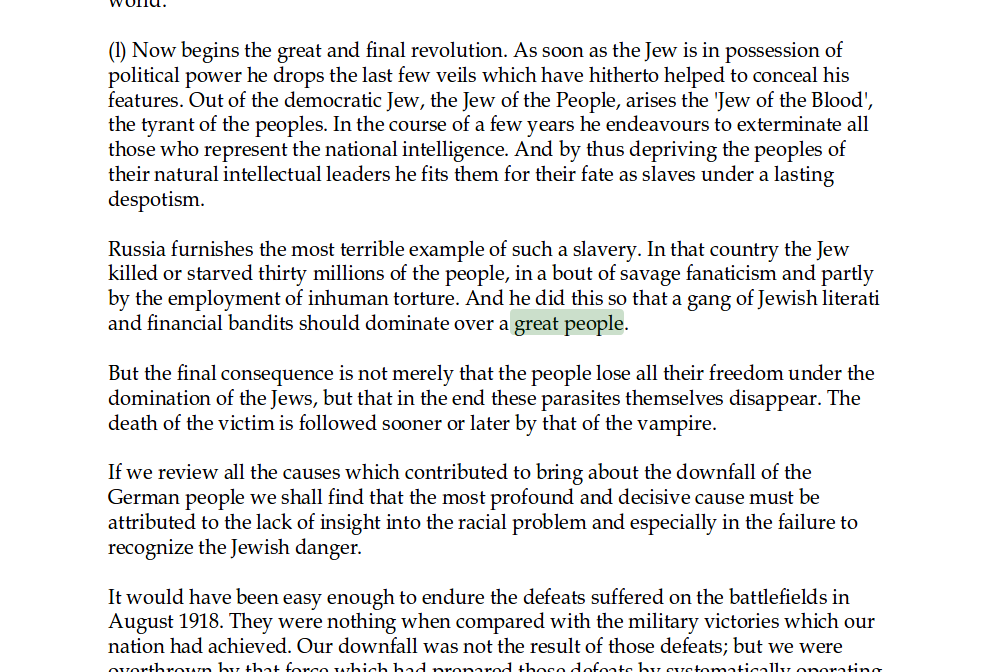
overthrown by that force which had prepared those defeats by systematically operating
I saw how p reminds russina п in it's upper half, and then b~h and I distinguish which one is that only by the context and the lower half
I have cut too much, now I cannot tell c from o. or can I.. o is similar to u, or rather O is to U, even though this font can give out which letter it was, the handwriting would pretty much be the same. This font tells me that O is double U, but it is confusing me because oo = u, uu=w
lower part seems to give much less information, but then b is in the u group, which makes sense, yet upper half is still more informative: v~y and only they fall into two as y is ij and then w is whether similar to v, if the ʌ part is in the lower half, or..
they way y and j have swash backwards make me guess what that could be.. could it be chinese way to write it? in columns? mongolian way? I should look at mongolian more.
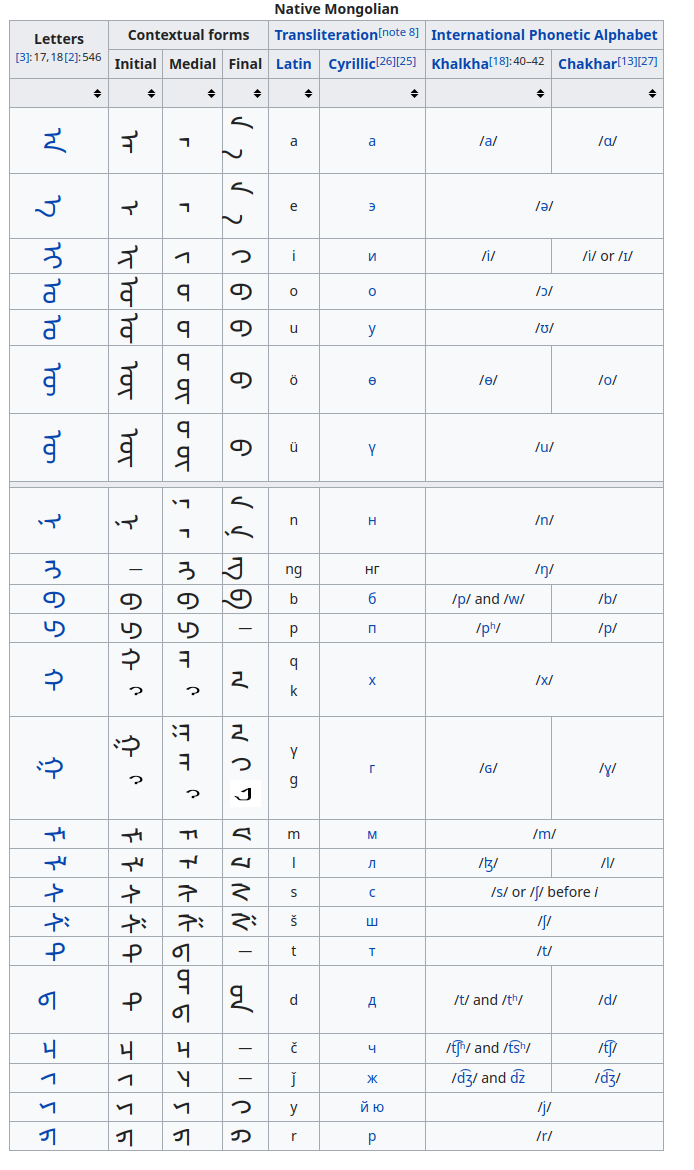
I wonder why some n and ng are standing before b p I would expect in the beginning of the sequence of syllables, but then I wonder even more about that n being the same letter as the e, which is the same letter as a in many context, some e with a '
and that ng is often the same n with a k(h, g) to it
And I like how o and u is the same letter, and because so are a and e, they demonstrate the three-vowel system, which is very archaic, or was their language this way? Archaic in one way can be modern or unique in some other, but I'm speaking without data about it.
Mongolian is a subject getting me easily overwhelmed, it's so pretty and so diverse, which may indicate a deep culture behind it, so it can have some answers too. I need a specialist in this stuff into my cloud university.
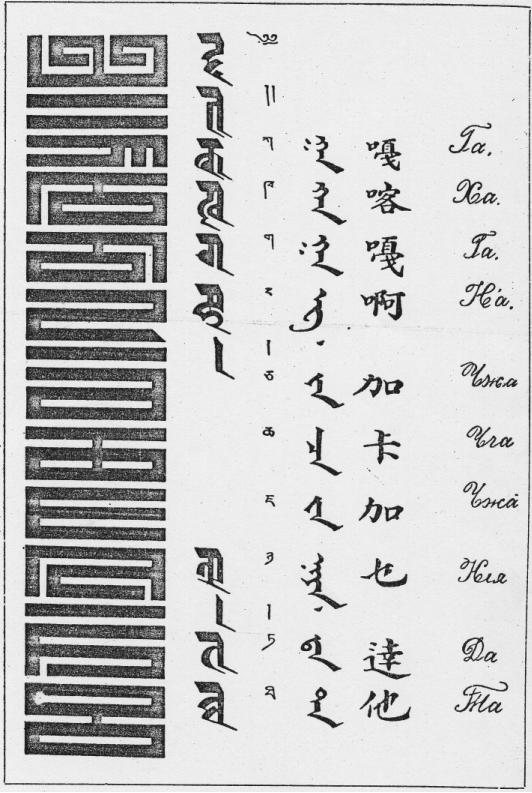

The word čiγšabd in an Uyghur Mongolian style: exemplifying a dotted syllable-final γ, and a final bd ligature. There is one mistake, that is there won't be any dots in γ if there is a consonant after it.
here's what they tell about mongolian alphabet: Derived from the Old Uyghur alphabet,
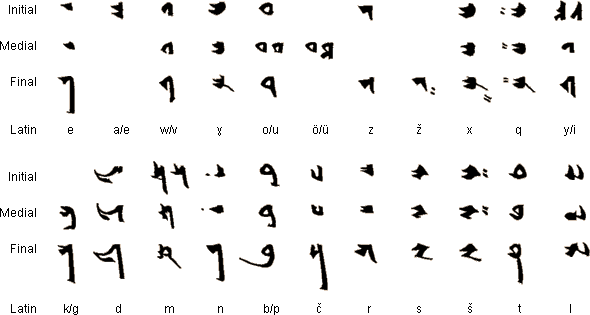
they say, it was used ca.700s–1800s
so it can be a good source of information on writing system, 1800s were documented well enough, and 700 is some politically decided date many "inferior" writing systems are attested to. But then it's only a guess, because it's only a draft, here the level of academic freedom is so outraged it's unacademic, and it's a good thing.
Ismo's recent standup made me think that some positions are for some activities, so
sit is for eat, read, shit, (meet? wit? no, these are some complex ideas, but the simple words are more based)
sleep is .. if it was from lay it would be slay..
Hitler ~ hatler ~ hatelord
No way such a name wasn't
глуПО ПОдлость?
glueПО ПОДлость
подлость ниже лести и лжи, "лось" и "lost"
лось is thus short for loser
(each bracket amongst text brakes the line in another, these brackets are for comments)
(and so I can use one colour if I return to brackets people didn't like, with using less of them)
With good looking women (or maybe with all women, I'm rude to women, here's why)
or
With good looking women
(or maybe with all women, I'm rude to women, here's why)
I switch on fight-or-flight.
I'm affraid of marriage because of what it did to my dad.
I don't reproduce, because surely devoting myself to science is like devoting myself to gods.
To muses I hope? To muses as well, to all around me, I'm about to protect myself, but I also want to protect my neighbours. Everybody is interested in keeping peace: if you poke a neighbour you have four large routes of possibility: he's
it's stronger but kinder, he
it's stronger and eviller
weaker and kinder
weaker and eviller
See how suffix of comparison is the suffix of the doer.
All we are everything (we do all the work if we have to, but some of us do the work more often than us
AI is augmented I
AIU is augmented I unified
U is you, A is it.
(now I need to find out what language did russian take э to to.
ה is literally e
это ~ it, this
то ~ that
it is id in latin, the is it as si is yes, and yes is is!!!
for and against
what are you arguing for
what are you arguing against
what are you crying for
ради чего.
for ~ four
четыре ~ чё ты re (re is latin verbal suffix, other than that, and maybe that too, are a guess, not a thing)
parents
friends
part
far'ed, to far
he is killed ~ he is to kill
he is dead ~ he is to die (this is more easily understood as the same)
he killed he killer? (killer is to kill)
-er ~ -ed?
er = ing
did people of hte past distinguish passive from active cases? or was it all y?
bilingua is always great (old uygur and arabic)
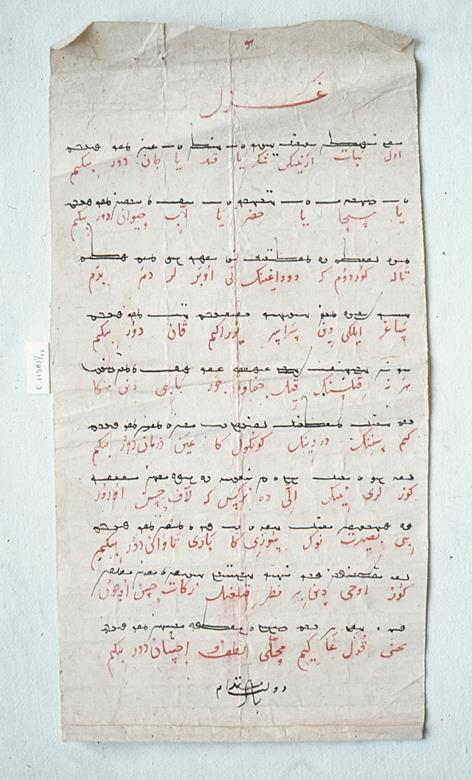
here it's probably a translation, but I have to compare the transcription
but then style is similar, arabic is for whatever reason more split.
But what matters much more here is that they say mongolian which draws similar lines but vertically, is told to be derived from this old uygur script which went horizontally. But horizontal is more modern, neh?
белый белёный белящий
did people of the past distinguish between н & щ? ing is closer to н phonetically but to щ semantically and graphically.

cursive is probably called so to forget it, to use more readeble records (but the cursive (or rather italic) survived and was used as local national cyphre,
Ш ~ E and looke how coursive ש reminds e and all these are on the top of Ϻ ~ Σ ~ E ~ W ~ Ш
that Ϻ is not M but some ancient form of S or Z close to Σ and Ш but then this form goes all over the spectre, can I even tell that it's not a nothingburger and shape doesn't influence pronounciation? But then
Aз Мы Ты Те
I Me Thee They
thou тебя? u~б? some labial unity? it was 30% chance. What would I say other wise? vowel-labial? b~c? ad?
b gave birth to a(r) it gave birth to d? or b gave birth to d? roman cursive shows them turned the same side
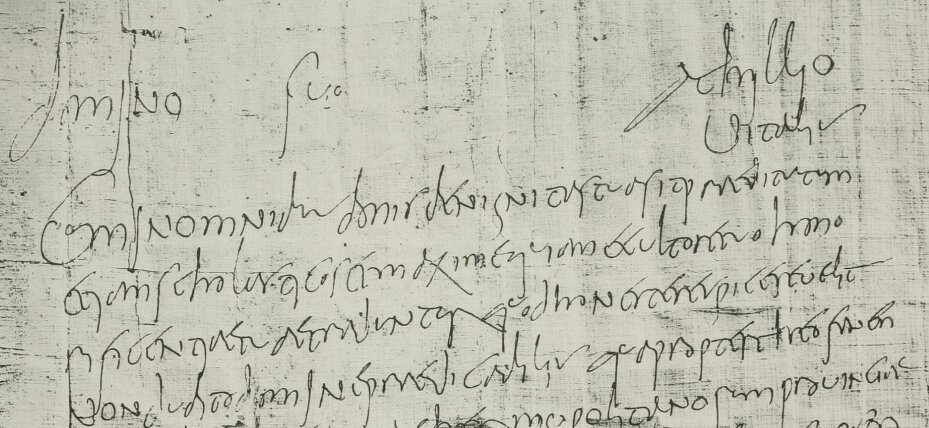
Beginning of a 4th-century Roman letter, from one Vitalis to a governor named Achillius, showing some litterae grandiores, i.e. letters made larger at the beginning of sentences, ultimately the ancestors of uppercase:
domino suo achillio, uitalis.
cum in omnibus bonis benignitas tua sit praedita, tum
etiam scholasticos et maxime, qui a me cultore tuo hono-
rificentiae tuae traduntur, quod honeste respicere velit,
non dubito, domine praedicabilis. Quapropter Theofanen...
and I recognize this shape of b: russian cursive writes it this way:

дацик нацик хахаха сука кой же охуевший (в хорошем смысле, как печенье охуевшее)
Но я хочу смиренно обратиться к этим героям не истреблять наш народ рабов и терпил, потому что мы иногда тоже доставляем (Менделеев цикличность элементов продемонстрировал, Окольников вот же досталась фамилия сумасшедшая демонстрирует периодичность букв: у нас очень хваткий ум, а то что терпилы, так это потому что похуизм только и спасает в таких сложных блядь сука условиях)

Gazing at irish alphabet and how unfortunate their U is, it only aligns along my matrices only if U is labial, but why would it be labial. Even though in runes it's labial, and both vowel and consonant, but where I took these glyphs it was u, and named ou, so it's vowel, but they I gazed at that square, and thought of german z being s and s is the last mother of sefer yetzirah, and I took these liberties:
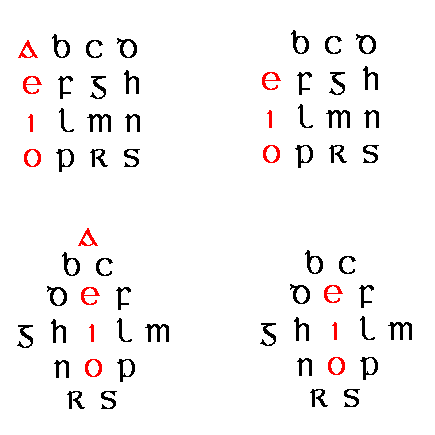
A is required to be a head. to be a body. R S could be some cognates of right and sinistrus, then whether thew drew the other way around or they saw it as a guy looking at us, so his (alphabet's) right foot is where R is and left foot where S is. If they knew this symmetry which is a very big if. I still only saw it from modern prople, who probably saw if form me, I havent' seen ancient documents with axial symmetry yet, so maybe I'm overcomplicating and shoot myself in a foot. But then L and R of lating alphabet.
I tried to read, and this is the first guess I have: beceder, ghelm noproblems
Unite ~ you and I 'ed
united has double 'ed then?
Hungary is Ungri, which is very similar to Tengri (ten is sky, I suspect the same etnonym syllable gri (contry) but before I read that
Hungary, the name in English for the European country, is an exonym derived from the Medieval Latin Hungaria. The Latin name itself derives from the ethnonyms (H)ungarī, Ungrī, and Ugrī for the steppe people that conquered the land today known as Hungary in the 9th and 10th centuries.
I thiought Hun was Hu-n for Human (many nations call themselves people, at least few nations do, I suspect most of them.
русы ~ люди?
славик ~ человек (это неожэиданная пара, и переводит "most of them" to "all of them")
nations ~ наши (plus double plural suffix)
тайна тайнã (а is plural suffix in latin, ã ~ en, another plural suffix)
tainы (vwls rdndnt)
stupidify
fy ~ fac(make in latin)
успокоить ~ усыпить (the same сп as in спи)
I envoked "oh muses" and I see those nine as tripled three and I see that muses and mothers are the same word, read differently in differend modes or dialects, with different voweels. Tелега телега и без wheels, but wheels help it rolling.
Miore There
A = aM
Aм было первым словом?
поглощение. ам as in amour, звонкий вздох вожделения.
Та = На = Даio Даю Дарю
(сплёванное как птица малышам? Что делал Один на дереве? Наблюдал за птицами.
пригвождён три дня значит что три дня не спускался. Или то девять дней было? это утроение, три дня без сна, без волы, это предел, финиж, но может он спал на дереве, может он пил там что.. на дереве пить только дождь можно. Во время дождей на дереве сидел? Смотрел на активность птиц по защите гнезда от дождя.
why three mothers? that is some parallel to tai chit thing
is three mothers chinese thing? No, tai uses tai chi.
chi как учение, какое-то подобное слово я знаю: .. and I didn't find it, but found many others:
血 [chi] blood
地 [chi] earth, soil (blood and soil!) place, territory, bottom of a package or a book)
千, 仟 [chi, sen] thousand
知, 智 [chi] wisdom, jnana (higher knowledge)
I use japanese instead of chinese (also because japanese forms often have chinese names too) but I have the feeling that japanese is the origin of all the east asian culture, the cultural centre it is. China is just a military empire who substituted the peaceful scientists and made them teach that china is the origin of the japanese hieroglyphs. and all the kanas too. even though kana probably originated in the north, ainu have more european features. I think if russia behaves, ainu are respected more. Were japanese peaceful scolars? Didn't they subjugate ainu themselves? Or was it the chinese influence? I am so biased, but I just describe the suggwestions emerging from my soul.
乳 chi (milk, breast, often read as chichi, which is cognate of titty, тити is plural in russian)
路, 道 [ち, ぢ (chi, ji)] (way, road)
痴, 癡 [ち[chi)] foolishness, fool, moha (ignorance, folly)
(isn't it weird that buddhists have two homonyms for their teminology, it is an element leading to zen)
another chi, and straight to the point the ji chi I was looking for
治 chi politics government administration rule
but actually I was looking for this:
字 [じ (dʒi)] hieroglyph, letter
thinking of some other ji, but thinking of this hieroglyph (remembering only the 子 part, which is phonetic, because though it's often ko, mostli in ko-domo it's first phonetic value is じ, thus it's a phonetic part and the roof is the ideographic element)
𒀭 (this is how importand for understanding hieroglyphics this revelation is)
But actually let's return to that chi as uchenie (teaching) thing:
教え [おしえ (ощие)] учение (звучит тоже похоже)
I thought I found it in 垂示 [すいし (sui shi)] but that 示 is show.
and suddenly I found that shi: 教旨[きょう し(kyo shi)]
but then I rein myself: why would japanese invented a writing system so that they would have to use three characters for one syllable? so it's chinese again? he who isn't a revolutionary as a young man doestn' have a heart, but then if I have brains will I become a conservative?)
but then I notice that it's not chi, shi.. sounds the same to me in the boundaries of dialectal variation.
подопечные подоплечные подручки подружки
под = подо, значит д в слове друг is до, to, and is f in friend for? for end (to the end, до конца)
руг рух смерть крушение рок (дорога=путь (до рока, по Т, and path is part or earth condemned to death. а потому, дорога пролегающая по камням лучше. дорога to rock, and it could relate to stoning being a savage way to muder, performed even before knives were invented. killing with a knife is some ritual killing, but then isn't every other one or many... but then I recall that руг is рук, друг подаст руку в сложной ситуации. д is then not до but дай, give. собака друг потому что умеет лапу подовать? собака понимает человеческий)
Deemer is how I'm gonna name me. It sounds as my actual name and gives a real great twist to it.
And this word explains why redeem is not considered related to deem: because the official etymology is pulled out of those faggots asses. I am such a disgusting savage, but I must dance the way I move.
Deemer оценщик (нет такого слова, используются слова appraiser, valuer, estimator, rater) кому ещё как не оценщику в ломбарде работать.
Deeem оценить, заложить
Redeem выцыганить. цыган~цен (меня же не смущает что коэн~cohen~coin и levi~levy)
цен~конь~kin (きん) 金 (золото) Friday is kinyobi, day of gold, the end of the week, the pay day.
fry fair pay плати
плати ~ плахуйты
хой в плохой это хуй? плохой значит хуёвый (про хуй)
Триединство мира это рационализация (ни плохой ни хороший, ни слева ни справа, ни растущая ни убывающая)
а и б сидели на трубе.. и язычная? б V? V is 6 when in hebrew, f is)
a i v
a n b
a + b
d и b
yes and no
I found a proto-labial.
if bee and bird are related (and rd in bird is some род (because they're dearest to us of all the flying things) then bee is the common thing and it could appear by onomatopoeia of the buzzing flyiers, such as bees, and flies too, but fly is the verb, another common denominator, another common flying thing.
So I was first taken aback by that b instead of z, but then I saw it, I spoke it, I heard it, when you use lips the same way vowel cords work, you get some unused today labial sound, articulatorilly similar to w, but phonetically similar to v, resonating lips, maybe even more powerful that vibrating nose with some deep N.
N is Nose
M is Mouth
L is l'e.. les yeux [ле зё] ? l~I~eye? лупы вылупить (были ли они табуированы от залупа (eye of a ז)
ا ب پ ت ث ج چ ح خ د ذ ر ز ژ س ش ص ض ط ظ ع غ ف ق ک گ ل م ن ه و ی
ا ب ج د ر س ص ط
ع ف ق ک ل م ن ه و ی
ا ب ج د
ه و ز ح ط
ی گ ل م ن س
ع ف ص ق ر ش ت ث خ ذ ض ظ غ
that middle representation
does 口 in 否 work as phonetic o?
Сравнив отчество и землячество я вижу, что отец это просто от
уд? мама и папа пизда и хуй? насколько дикими мы были? очень дикими, ведь даже животные говорят. we were always weird specie. There are many weird species,
россиянский рязанский
рязань rasen russian
uvwxyz
яюэьыъ?
разные
хула и хвала антонимы. означает ли это что у менее пристойно чем в?
V прочтение библейское, если верить израильскому алфавиту.
У находится за рамками Т,
Про руны: я выше сказал, что став скорей всего изначально был горизонтальным, став та сторона которой ставить? дно коробки или книги? И сейчас посмотрев на рунические камни, я заметил, что большинство их и вправду горизонтальны, причём так, что ᚦ становится Д (но может запрасто развернуться и стать более похожею на Т чтоли)

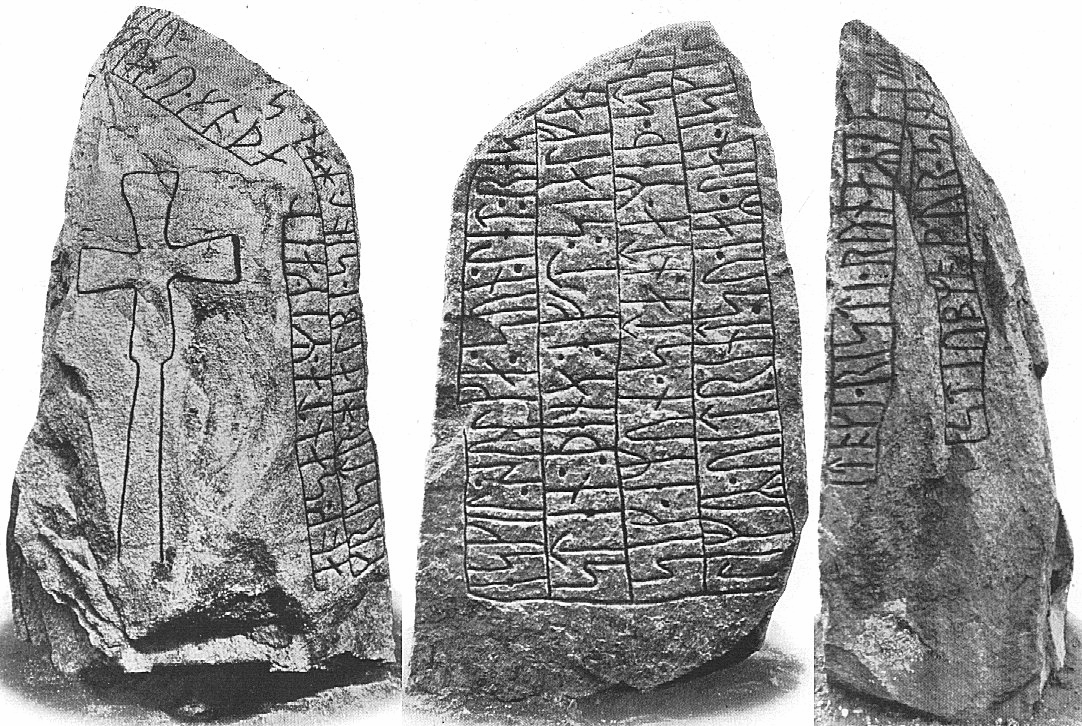
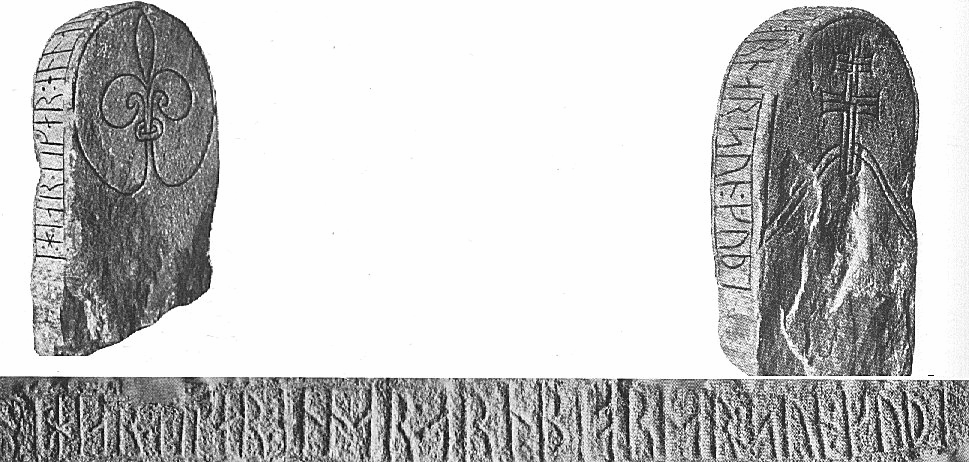
(mirror1) (mirror2)
так что те камни, которые имеют руны горизонтально, скорей всего раньше стояли вертикально, но это неточно. The Øster Marie Alphabet Stone is a significant exception, but then it's a portable stonelet, who knows how it was to be held. But then why are they not in one line? Because they're not a spelling, futhark on the other hand.. Could it be encrypted alphabet? I ask the question a lot, the answer is maybe, might be.
Suddenly I see how academy can be the eastern sequence of akdm (akkadian?) and it made me thinking: were plato school responsible for defeat of Attic tribes by Ionian tribes?
And I know there was some military conflict after which attic dialect became the official one, and I tried to find it, but I found something even more interesting:
In Greek mythology, the Attic War is the conflict between the Amazons, led by Amazon queen Penthesilea, and the Athenians, led by Theseus or Heracles.
Depending on the version, the Amazons fought to free either Antiope or her sister Hippolyta from captivity after her abduction at the hands of a Greek hero.
Per some Greek myths, Heracles abducted Hippolyta during his ninth labor and later gave her to Theseus. Per other myths, Hippolyta was killed during the ninth labor and Theseus, who had joined Hercules during his expedition, abducted Hippolyta's sister Antiope.
In all the myths, the Amazons then went to war against the Athenians and were soundly defeated.
This myth definitely describes one of the final battles of matriarchal vs patriarchal societies. Or was it a satire of why women cannot compete? Eiteh w Either way notice how both AMaZon and AθeNian are alphabetic. And that attic war could describe how Athens came to power and the one I was looking for tells about how it fell out of it. Towards Bythantium maybe (I'm not a historian, I write it for myself)
Was I looking for peloponnesian war? (431–404 BC) is exactly when Socrates lived. When the war started he was around 40 and he died about 5 years after it was won by Sparta, which led to Spartan Hegemony, and spartans are some militant faggots, and that could explain the raise of platonic school. Plato at that time was around 24.
Spartans discouraged the creation of records about their internal affairs
But then this spartan dominance determined their decline, after all they were only used by some other powers: The war remained undecided for a long time until the decisive intervention of the Persian Empire in support of Sparta.
the Thirty chose 3,000 Athenian men "to share in the government".[5] These hand-selected individuals had the right to carry weapons, to have a jury trial, and to reside within city limits.[6] The list of the selected 3,000 was consistently revised.[6] Although little is known about these 3,000 men ‒ for a complete record was never documented ‒ it is hypothesised[by whom?] that the Thirty appointed these select few as the only men the Thirty could find who were devotedly loyal to their regime.[7]
They also hired 300 "lash-bearers" or whip-bearing men to intimidate Athenian citizens.
And seeing, as I did, that in quite a short time they made the former government seem by comparison something precious as gold-for among other things they tried to send a friend of mine, the aged Socrates, whom I should scarcely scruple to describe as the most upright man of that day, with some other persons to carry off one of the citizens by force to execution, in order that, whether he wished it, or not, he might share the guilt of their conduct; but he would not obey them, risking all consequences in preference to becoming a partner in their iniquitous deeds-seeing all these things and others of the same kind on a considerable scale, I disapproved of their proceedings, and withdrew from any connection with the abuses of the time.
So even though the account tells that Socrates disobeyed the order, they ordered him as if he was one of the 3000, which may reveal that he was loyal to that rule. yet he goes on:
Not long after that a revolution terminated the power of the thirty and the form of government as it then was. And once more, though with more hesitation, I began to be moved by the desire to take part in public and political affairs. Well, even in the new government, unsettled as it was, events occurred which one would naturally view with disapproval; and it was not surprising that in a period of revolution excessive penalties were inflicted by some persons on political opponents, though those who had returned from exile at that time showed very considerable forbearance. But once more it happened that some of those in power brought my friend Socrates, whom I have mentioned, to trial before a court of law, laying a most iniquitous charge against him and one most inappropriate in his case: for it was on a charge of impiety that some of them prosecuted and others condemned and executed the very man who would not participate in the iniquitous arrest of one of the friends of the party then in exile, at the time when they themselves were in exile and misfortune.
and my accusations seem to be correct:
Due to their desire to remain in complete control over Athens, the Thirty sought to exile or kill anyone who outwardly opposed their regime. Socrates remained in the city through this period, which caused the public to associate him with the Thirty and may have contributed to his eventual death sentence, especially since Critias had been his student.
an interesting example of capital cursive D showing what I spoke about volumes ago:
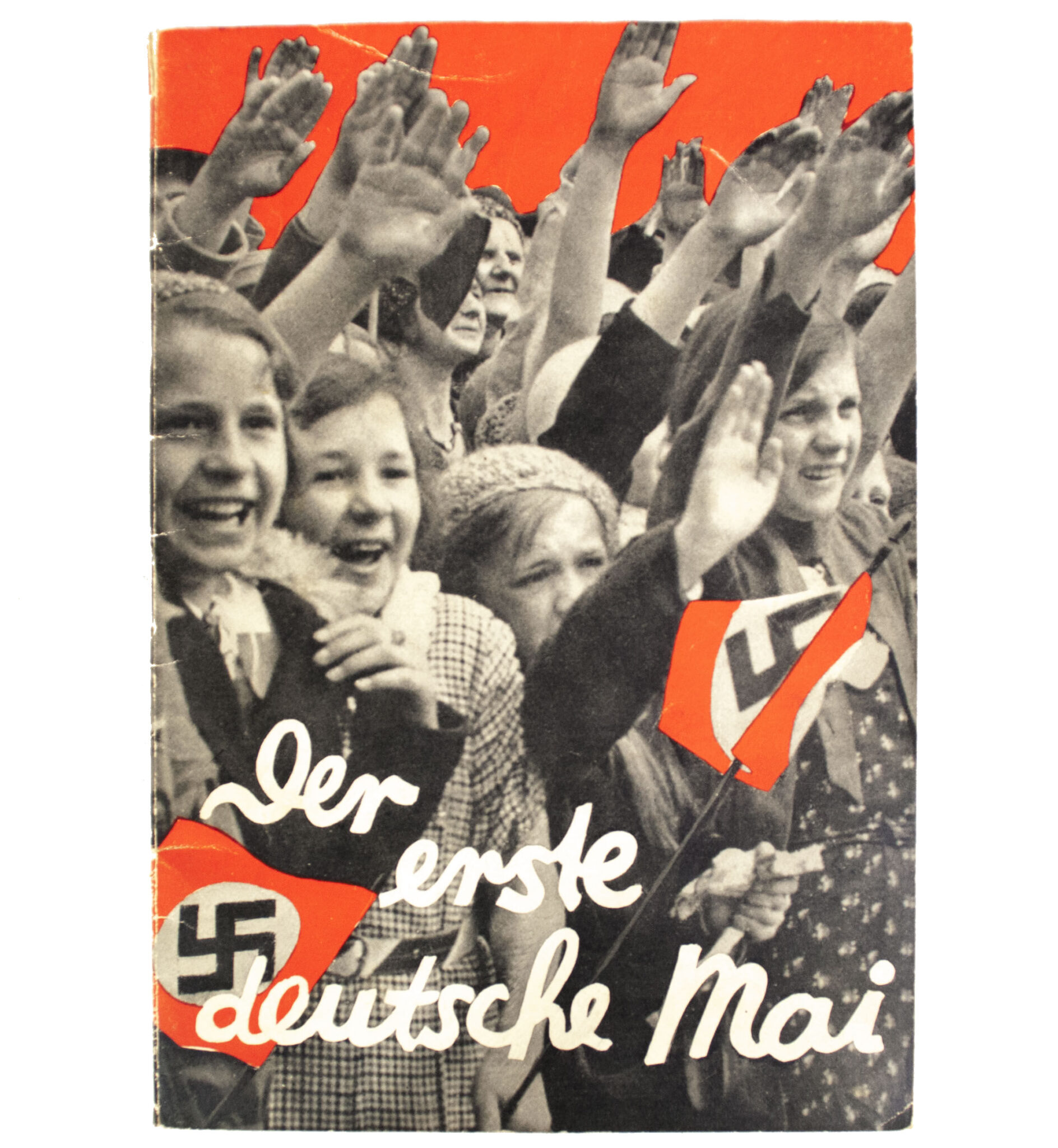
That propaganda lured germans with the photographs of loli, but there were only nazi guys inside of that booklet. I still consider if I should censor the unlucky swastika, but then should I also ban out that colour of arterial blood? in contrast to black and white photo it works as some sort of magic. red cloth to a bull. I don't know if bulls are colour blind or if they get mad
It's like literally the same tech commies used, the same paint they printed пионерская правда with.
обет обещание
отец отче
конец конче (кончи, о конец, кончая, кончив? отчая? отчитая, отчив (отчим? отчим отец именем?)
юнец юнга юноша
отец атташе?
отец = от це, от яего, от цек от цего, от его
I just noticed and corrected all "abundant" words I was using them incorrectly, I substituted tehm them with redundant where it belonged and noticed how these words are related and I see the prefix red and don't know what to do with it. Is d articulatorily convenient
волна влияние влн
глава голова глв
глсн лшн?
глв влн в обратную сторону? что если лукашевич был прав? меня эта мысль посещает порою.
врн ворон ворона вороньё (остальное пение на устмотрение шамана)
врун (говорун? го приставка? как голландское ge?)
верен вран враньё
верни евреин уверен
врн включает в себя вр и рн (врун вор рун)
глв включает в себя гл и лв (голая любовь? гл hd? love ad as in addiction? he is гл
Я не знаю что значит гл.. гол. гол? лицо было голым когда шерстью покрыты были?
лицо вылизано?
глв влг вл лг воля и лицо? will лик?
эта часть книги гримуар почти, я здесь гадаю
дорога дор рог dear rock? how dare I mix languages? Cognates are everywhere, imagine how it was when it's all multibplied by the axis of time.
долога долгий камень? дорога = долго = далеко длк
here, I found few ways people use aeiou for rationalizations:
activity environment interactions objects users
what words contain only vowels?
Could lexics be made in such form, that it rhymed with what you the introducers of those words wanted to subvertly associate them to?
is сп in спокойный the same сп from спать?
but then спать has the same п as in покой?
покойный от спокойного отличаются тем, что спокойный жив. с значит словно?
гробница
бробниша
гроб ницца
короб ниша
бороб nice
короб
сруб
с руб
руб рыв рвав ров р've
рыв and руб is R have
уб как в обрёл убрал
ри глагольный суффикс сохранившийся в японском и латыни и иногда в других:
ударь (но здесь может дарь дай дари.. I wanted to say дарить в ударить было грубое дай. но дарить это именно что дай, а потому й
короб is not exactly box, but the only other word they have is a funny word pannier (плетёный короб, корзина, плетёный щит, быть может лапти технически тоже pannier)
I didn't find what panny means, so pannier is probably of pan (сковорода, кастрюля, лоток, поддон противень, чашка чаша унитаз таз полка миска корыто чашкавесов лицо котловина подпочвенныйпласт язычество (paganism, heathenism, heathendom, infidelity, pagandom, pan)
язычники поклонялись пану, т.е. князю, фараону,
польское пан сохранило значение древнего бога пана? это польский культ культ пана? коллекционировали египтяне и прочие разных богов? Если житель имеет корни за рубежом, то отчего бы ему не поклоняться своему "пану" если один из его родителей так молился (люли входят в брак с уже сложившимся культурным багажом)
толпка
толпа отупляет
толпа топла
топчест
топчется и топчет
(так вот что значит сила толпы. но смотрите своих не затопчите)
влез в лес
вылез из леса
somehow вы is the opposite of в
it would make sense if в was ов ~ of
вы ~ from?
в ~ of~on(п is russian p and ν is greek n) the unity of vpn
с иронией смотря на это vpn и как кто-то найдёт совсем не то о чём думал: "может сегодняшняя толпа обезьян (хотел сказать что неспособна напечатать войну и мир случайно, но заметил что случайность неслучайна и такую обезьяну звали лев толстой. бесконечная по времени толпа обезьян может напечатать и напечатает что угодно (за бесконечный промежуток времени, но какие-то тексты будут появляться чаще, а какие-то вообще только спустя очень длинную бесконечность времени, потому что ..но понимаю что возможность написанного (с учётом всё возрастающего количества знаков, но при опреедлённой интерпретации количество слов сократиться быть может до двух или трёх, а в такой интерпретации вопрос длины совпадающего отрывка, быть может какие-то сонеты прямо один в один на языке +/- в современном языке представленных разными текстами. До того как это напечатал, думал что мой труд труд одной из тех мартых мол пока войну и мир не поулчилось случайно колотя по клавишам, но неслучайна эта случайность, в виде слов, смыслов, в общем представляя сколько обезьян нужно чтоб все варианты текста напечатать, и понял что земли не хватит, но внезапно представил людей покрывающих поверхность земли как клетки многоклеточного организма, подходящего к яблоне передающего яблоки по толпе, толпа топчет и не только, представил как колония людей-клеток возле костра чуть рассеяна, но хищник приблизившись к одному из таких рисковал быть разорванным на шкурки толпой москвичей.
человек ~ головач
москвич ~ мозгович
челябинец человечец человечек
человек челябинское слово? только челябинцы олимпийку мастеркой называют
это не черрипикинг нифига, я реально живу в челябинске и родился в челябинске
И здесь я, как та magic history theory practice predicted my own nation establish.
2022 made it clear that cheliabinsk doesn't want to be russian.
We anounce english and russian to be state languages and declare ourselves cheliabinsk independent state. I think they'll like this cis thing cis is чистый
This will lure white americans, and those guys will raise our country in no time.
RECALL RECALL RECALL
recoil recoil recoil recoil coill
coil корчиться
Archived version is archived in the middle of the vol. 13 where I celebrated death by absolutely occasional ending it, when github stopped listing Russian Federation way later than 2014, but way before 2022/ (and only now I realized that 2014 was a anniversary of 1914 and what could be their plans? to start the revolution? What happened in 2017?

at first I noticed how much the second a looks like x and then like t and I saw the g looking like j and I realized that scribes multiplied the ammount of signs when they were rewriting some ancient texts not recognizing the hand of the ancient scribe, and paper was used in one way or another for some long time and we just don't have those stages of development of handwriting, only some artistic texts. But then I realize that what would stop people from writing the same way in stone as well. And I realize that only lack of creativity would, but it probably was not an issue. So we just have to dig deeper and in some humane way: by shafts. And probably some cities are secretly discovered like that.
that a can explain such shapes as א, Ⰰ (in other fonts just + with some tiny blops downwards at the ends)
гул и пыль на странице правее относится к фигурам хладни (но если не иметь этой же семантической связки, то то предложение выглядит как бред. очень сложно пишем, издержки поэзии? что-то типа того. Это муза-поэт пробует силы в прозаических произведениях, умудряясь делать их лучше чем другие феечки.
seiten is on my side? they're both on my sides, бог бок (like what were tha chances to meet him here)
Seiten- is literally side- in german, but also pages (Seite is side, also page, which is much precise than russian страница which is often a hyperonym for whole the leaf, лист[list])
playing with russian

I notice, that if we arange them all systemically, we'll have only few consonants off the frame, and those consonants are R (probably a variant of L.. RMN? RoMaN? Роман?) and the consonants standing at the very end, where some variables and later additions were traditionally placed half of the time: цчшщ, the final russian consonants, тс, т.. and to my surprise I found that те would be a great digraph, because it would immediately related russian чашка to tea: teasska. ss or rather сс is how I would transliterate ш and щ.. sse? е working as h? historically interesting, but somewhat clumsy, teaй may say that because чай and tea are the same word written from different dialects, we should not substitute й with и, but utterly reject it. йог is ог? йод is од? these digraph are not occupied, so maybe yes. чай ча? сен ча, японцы произносят чай как ча, значит отбросить й отличная идея. белый белы (убираем разделение прилагательных по числам, тем более что есть форма бел ничем не хуже. я тогда тоже отбрасываем и получаем бела вместо белая. А что будет вместо местоимения я? оно отбросится? аз? оно отбросится, мы уже содержим его в глаголах ю in делаю is io, or if we don't place i instead of и, делаио, делано делаемо. делаем (ем ~ am and me and мы)
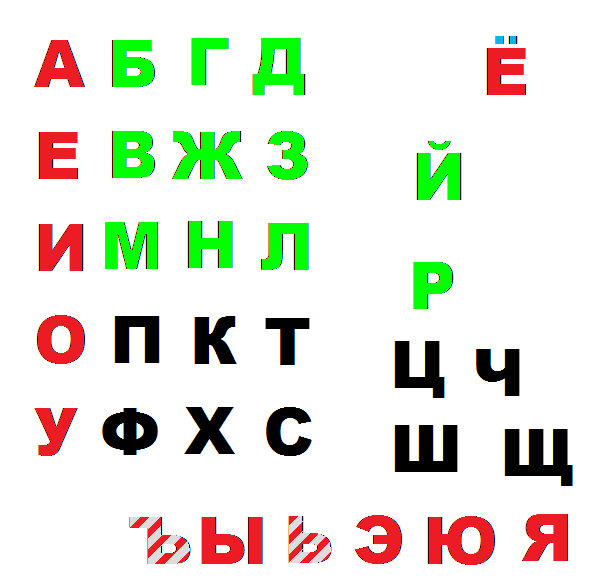
then ё is not е bot but o, я is а (аз) and ы is и in kyiwan standard.
Their spelling is so funky, и вчера вместо из киевской услышал как из скифской.
Скифы Skythians Scotians (в любом случае справедливо, что скоты, но немногно обидно)
Русские с Шотландцами Р[R] одинаково произносят.
(я не русский похоже, раз картавлю. Дёмушкин тоже кортавит, русские гусски гузки труски, мы такие, осторожные, а язык у нас не приспособлен для великорусского стандартного Р который шотландыцы (если на слух, то очень по русски акцентят для русского уха, очень родные, мы традиционно недолюбливаем англичан, русские хотят быть под нидерландским покровительством, но нидерланды благоразумно не желают ссориться с англичанами ради какой-то сраной раши. Мы одни и похоже что следующий этап развал совка, который так и не произошёл на самом деле, но пукин боится распада, или жалеет о нём, а потому все силы которые он собрал против себя на развал этого самого союза и будут работать. И быть может этой перспективой Трамп вову напугал как того никогда не пугали.
пугал пукал пускал опускал (испугался опустился оступился оспадался госпада (ск криком госпада!)
sequence MNL appeared because N is recognized as Ŋŋ and thus is a sonor (nosal) from fo Г and reflects Х[h] which is stereophonic sound spectacular because Н[n] in russian. ЙК is suspected to be Йесус Кристос (I didn't find such form of this holy name in any language, but looking for it I found plenty: Jiises Krast
Brezhoneg: Jezuz Krist
Čeština: Ježíš Kristus
Dansk: Jesus Kristus
Dolnoserbski: Jezus Kristus
Eesti: Jeesus Kristus
Esperanto: Jesuo Kristo
Euskara: Jesukristo
Føroyskt: Jesus Kristus
Frysk: Jezus Kristus
Íslenska: Jesús Kristur
Kalaallisut: Jiisusi-Kristus
Kreyòl ayisyen : Jezikris
Latviešu: Jēzus Kristus
Lietuvių: Jėzus Kristu
Magyar: Jézus Krisztus
Norsk bokmål: Jesus Kristus
Norsk nynorsk: Jesus Kristus
Shqip: Jezu Krishti
SiSwati: Jesu Khristu
Slovenčina: Ježiš Kristus
Slovenščina: Jezus Kristus
Suomi: Jeesus Kristus
Svenska: Jesus Kristus
Võro: Jeesus Krõstus
Žemaitėška: Jiezos Krėstos
these languages (in grey) are the candidates to look into for the case of JK added to roman alphabet.
but as I'm all over this subject, let's continue to catalogize some other variants:
an interesting example muslims seem to preserve, the Mashiah, to my surprise not Mehdi:
Bahasa Indonesia: Yesus Kristus / Isa al-Masih
Bahasa Melayu: Yesus Kristus / يسوس / Isa al-Masih / يسوع
Jawa: Yesus Kristus / Isa almasih
Қазақша: Иса Мәсіх / Isa Mäsix
as uf ut if it indicates that he is not just cursed (as bible tells of everybody who hanged on a tree, probably originally referring to Odin or to some more common shamanic practices, maybe dree tree wood was an euphemism to weed, and it tells more reasonable story of the invention of runes: weed definitely helps digging into that subject)
Türkçe: Yeşua Mesih / İsa Mesih
and
Taqbaylit : Ɛisa Amasiḥ
reminds me ingenous word for Tifinagh, Amazik.. but it's Amazigh. Was Jesus Berber?
is amazigh a cognate of amazing?
And though I had no idea who those Taqbaylit, I got right to the point:
Kabyle (/kəˈbaɪl/) or Kabylian (/kəˈbɪljən/; native name: Taqbaylit [θɐqβæjlɪθ] is a Berber language spoken by the Kabyle people in the north and northeast of Algeria. It is spoken primarily in Kabylia, east of the capital Algiers and in Algiers itself, but also by various groups near Blida, such as the Beni Salah and Beni Bou Yaqob.
Comparing words Kabyle and Tqbaylit, I suggest that prefix ta is probably toponimic 𓏏 alike to suffix -land.
Hausa: Isa Almasihu
and here I realize that it's the same al Moshiah (but it's still interesting how I found it first in a berber language, like what were the chances)
some other interesting names:
Diné bizaad: Jíísas Doodaatsaahii
Māori: Ihu Karaiti
Mìng-dĕ̤ng-ngṳ̄:Ià-sŭ Gĭ-dók
Tiếng Việt: Chúa Giêsu Kitô (but this one is bastardized Gesu Kristo with some local the or something)
Башҡортса: Ғайса (that Гайса is probably just a dialectal form of Jesus as another one, Gesu)
Corsu: Gesù Cristu (Gesu is rather popular form, some people even say that masonic G is of Gesu)
Avañe'ẽ: Hesu Kirito
Cymraeg: Iesu Grist
Emiliàn e rumagnòl: Gesü
Gaeilge: Íosa Críost
Italiano: Gesù Cristo
Lombard: Gesü Crist
Sardu: Gesùs Cristu
Sicilianu: Gesù Crist
Tagalog: Hesukristo
hebrew is a special case again:
עברית: ישו הנוצרי (isu the nazarene)
warrior is worrier? (the one who worries)
the Earth is yours
So both your parents sucks the big guv's dick and you want to
here's the context where both to and too would work and could demonstrate how one of those words could come to life
z (I came to this and when I was gone I was thinking that there are two forces: businessmen and gangsters, and government is gangsters. they have that G in it.
so how weird was that z when I came with to write this:
zar and bazar
сабек собак (dog god) the бог
Идея стать подобным многоклеточному существу став клеткой самодостаточной самому.
проклятое место ~ проклял твоё место
славное место ~ славь моё место
давай сравним другие слова с суффиксами тое и ное дабы понять верно ли мы поняли их смысл:
смешное
страшное
лишнее
благословенное
сокровенное
лесное
пустынное
лестное
классное
пустое
простое
в простое
в простоте
быковатое
быдловатое
поддатое
рогатое
бодатое
раздатое
(поддатое, раздатое, но не датое, а данное.. т = нн?)
прошлое
былое
смелое
плохое
бухое
лихое
Покой сПи
Падай
Пал сПал
с значит slowly, silently, тихо (тх!? th?!)
спал тот кто тихо пал (пригнулся и притворился мёртвым)
бог мать (я хотел напиасть бог батя, но написал бог мать а не матя даже, чудо? чудо!)
концепция отцовства быть может не была знакома древним создающим наш язык.
понимание отцовства знаменует период, в который буквы расходились и по парам мама/папа и mommy/daddy they расходились по разному. В условно русской лексике расхождение было по звонким/глухим, что поддерживается тем, что именно в русском алфавите разделение на звонкие и глухие отражено сильнее всего.
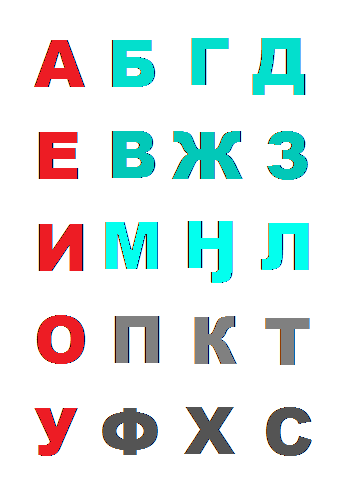
Племянник начинает читать, но вместо Р говорит Л, так что я показал ему свой картавый вариант (увулой) т.е. R элемент поздний, вариант буквы L, MNL? MNR manner? mrn would be moron, btw., but this russian beauty tells it's MNR or MNL 321, which goes along with EFГ, it was prohibited to read alphabet the other way around, I think this idea is where the k-symmetry is coming from, but let's compare direct and reverse alphabets instead:
a b c d e f g h i j k l m n o p q r s t u v w x y z
z y x w v u t s r q p o n m l k j i h g f e d c b a
az goe as аз
by goes as буки
cx is it vedi or the continuation of buki? wd would make a better vedi and then ve is also vedi, vedw? gfut glagol? and you see how much my mind can stretch it, but then it is stretched by it itself, paradoxically, he stretches itself around it. The facts don't change, some weird mind experiments can change reality of perception, and thus should be performed very carefully if at all. I used to play with this particular idea before and it only gave me k-symmetry, which never returned anything other than relating R to D and few pairs were completely off any similarity were they not?
Та история с племянником была лишь дабы обосновать выбор L вместо r (помимо того, что именно L находится в строке буквы И.
И сначала я не понял строку И: ...и мангал.. что? и лишь как только я выделил её как сонорную (носовую быть может изначально) и сразу же она засияла словом Имануил (настоящее имя Иисуса Христа, данное ему при рождении, удивительно сколь редко христиане об этом знают, я это от протестантов впервые узнал, они пели ему гимн, а я не мог взять в толк какому демону они молятся и пропускал это слово)
имя налого
и монгол
другие варианты прочтения могут быть, эта строка рождена соседними строками или это она породила те строки а я лишь восстановил её посредством их?
В силу того, что строка И в английском является строкой JK, я оставляю как рабочее прочтение ИМаНуиЛ.
строка Абгд если свёрнута в А-д, то и отец как от, адец! и евжз сокращается до ев, что в центре слова hÆVen if h is "the" (ה) and en is plural suffix. Like a view from another side that бок и seiten (I is always one (you is always a one person) and others are always in plural. So are ад и хевен named from the point of view of adam who got to hell? It could relate to norsk mythology, where warriors (murderers) go to Valhalla, where they fight to death each day, looks pretty much like hell to me. The other public goes to some field of some goddess, and I think it's peaceful in there, and from christian point of view that field is heaven (peace is one of the conditions of heaven, and those who don't kill are righteous and deserve heaven)
нестяжатели, кто на вопрос what do you have say haven't (and go to heaven, because that's what they said they have. or did they say that they have end? thus they are devoured by a deity and thus end their cycle of samsara, sansara (संसार))
✡︎ in the form of 6 may dictate jews to go scattering, because rotation outwards in that spyral is clockwise and rotation inwards goes counter-clockwise. Is it why they cannot come to their senses?
But then I notice that 9 goes the same way, and they probably were like that because both inwardly lucky forms were taken by letters: e and d, p and d (but why б and g didn't confuse mathematicians?
здов здоровье
задор
healthy happy?
hunty? hunting хочет хохочет
хохочу хохочем
хочу хотим (русские глаголы используют еврейский суффикс существительных, тоже для значения множественности. им ~ 'em (them))
and once again ч is т
чайка теперь тепел тайка? детский лепет. детский лепет и есть, зарождение языка.
детски лепет детски лепет и ест, залождение изика
kiddy kiddy kiddy kill kill kill
I look at this new thing and I think..
M and П are one under the other. But M and D are.. as if Ж is the centre of the six letters around it, and thus is 7th?

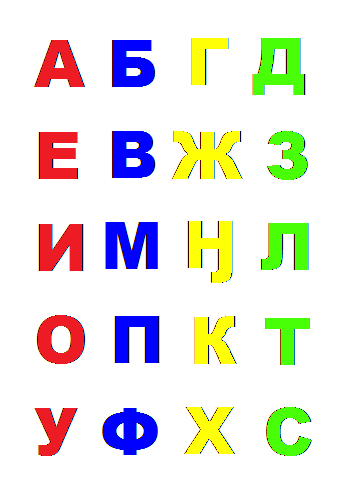
Mommy / Daddy
and Баба / Ляля?
Г господин
Н нижний по статусу?
Господь
Ничтожество
как противополождности?
Га как Да? потому что Н это нет.
Бло раньше четыре элемента или было это
A B D
E V Z
I M N
O P T
U F S
луски изик а кажетса плидумал луски изик. Позже а уплосу иво до менсего колитества букв, но пока так. или тяк? может заменить А буквой Я? давай попробуем: он плишон я ти не плишла.. is conjugation а я used in other contexts?
ты хотел а не хотела = ты хотел я не хотела? был разговор о двух лицах, но не о третьем?
естественно, я могу лишь предполагать.
А Б Д
Е В З
И М Н
О П Т
У Ф С
попнобуу так писат.. но попнобуу нимуда не додитса
м носовая к! вот это приколы! и м к? или давай серва посмотрим на И М Л (имел)
А Б Д
Е В З
И М Л
О П Т
У Ф С
поплобуа (а = я, io = ю) так писат
посмотлим тто полутитса
вот сеитас у тодо-то пелдат (заменив ч буквой т я чувствую себя вольно заменить и к буквой т как фонетически ближайшей к ней) поддолит.
Создав три столбца "гласные губные язычные" велярные неизбежно были поглощены корональными, но что если попробовать это именно что ABC?
ABG
EVJ
IMN (or IML?)
OPK
UFH
I kammot look at it
or
I kannot nook at it?
both variants seem retarded, but then baby babble, remember, bb talk.
What bird am I? I think to my self: ame I an awl? owl? oрёл (eagle) owl ..dove? hawk?
ochen letauschee?
отен летаушее
we naturally need like under c[s]
A B G D
E V J Z
I M N L
O P K T
U F H S
Y W.. Ш?
Y W.. Y Ш?
I started an azbuka, one buratino could have, I always wanted to see the book of buratino, I was always confused by the idea of him not having those books available. I understand now! I wanted every object of the fairytale for the display or even to purchase such one for yourself.
So I just began my version of Azbuka, and I went astray again, so I will return to that thing tomorrow morning and I ..here is how it went today:
A I U
b d
p q
B D
P Q
ва ba bi bu
da de do
e~i, o~u
E O
A E I O U
a e i o u
Be Do Pie Quo? Que? iQ? Q It's more useful to have this K of the q instead of t when we have d which is read as t alright when it's final, so what is the p doing there? is it p? b would be enough. It's R (greek and russian R is Р, that roman \ is probably a swash.
б д
р q.. russians don't have q, but what if that is such a way to write k? I don't know, only from what I thought of in the latin variant being bdrk with r being labial (farting. and k is caughing. buttocs were also considered lips? Just as kids see female pussy as a small popa, popa is labia first? la bia? b as in batter and rubber?
б д
р ч
(gothic font taught us to unify ч to q and to u too)
in bdrk k is caugh (is r is fart)
in бдрч (бодрячь! бодреть! бодрячком пацанчики бодрячком, это очень-очень русская тема. зима бодрит, подрывает, ускоряет, под-что-то там короче подпинывает, ускоряет подскоряет бодрит под-рит. что за рит? рыть подрывает значит, но как я и сказал в значении взрыва, и смотри как mine in both meanings is both мина и подкоп, )
сапёр ил литералли саппер ин хинди, зэй ливд уис бриттиш фор соу лонг зэй борроуэд пленти фром зэм. уос сатскрит ивин рил? सैपर
sap is подрыв не в значении взрывать, а в значении подкоп, подрес растения чтоб оно капало соком (как берёзовый сок добывают, оттого может и капать тоже sap, сочиться, сравни с русским кап)
Let's research it before we write about it tomorrow:
A B D A Б G
E V Z Е В Ж
O P С О П Ч
U F S У Ф Ш
(I first came with Q where I used to bring T, but then I found a better compormise, the russian S, the C)
(and that that C transformed not only into K, but into Ч, which made G dʒ and it returned G the C instead of D, though in runes it's ᚦ, and I had to use Г instead of G но я затупил)
A B G D А Б Г Д
E V J Z Е В Ж З
I M N L И М Н Л
O P Q T О П К Т
U F H S У Ф Х С
A B C D А Б В Г Д
E F G H Е Ё Ж З
I J K L M N И Й К Л М Н
O P Q R S T О П Р С Т
U V W X Y Z У Ф Х Ц Ч Ш Щ
Ъ Ы Ь Э Ю Я
not the funniest of his pieces, but it's here because this schematism revealed that tree = three

tree~triangle~three_roots_of_the_tree_of_life, and now let's check actual maps to see if some of them used triangles to denote trees.
well, only sometimes, and it isn't even ancient, it doesn't prove a thing, yet maybe illustrates:
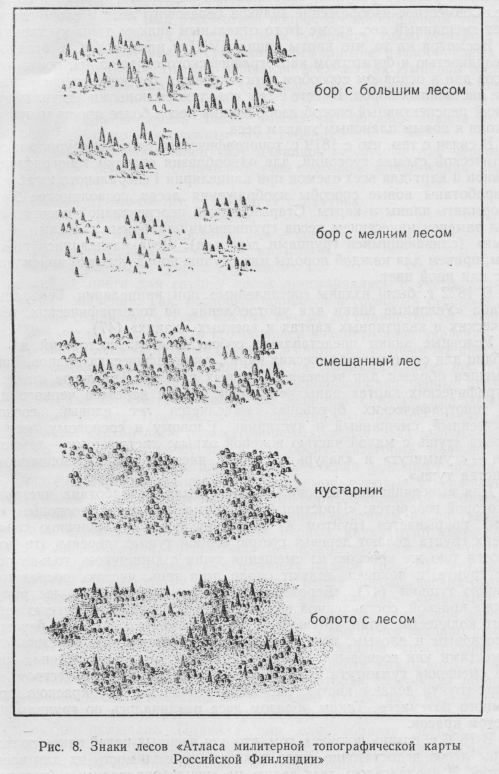
тогда что есть 2? два~вода? and one? town? to own? you can buy a spot in a city, you probably couldn't buy a piece of forest as a property (kings owned all the land)
If l~j and v~y, love~joy
norn ~ norm?
(upd of brochure 1) и не только противоречия, это противоречие выявляет неслабую такую предвзятость, попытку выдать желаемое за действительное без достаточных оснований для совершения однозначного умозаключения относительно направления передачи алфавитной традиции. Алфавит достаточно сложная система, т.е. она состоит из нескольких элементов, нескольких идей, и идеи эти естественно появлялись в разных географических точках. Греки говорят о пяти гласных, евреи же описывают систему на предыдущем этапе, так что может в академиях тоже не дураки сидят, а верно установили что направление песьма (песьмо ближе к слову песня, что благозвучшей чем современный вариант) от евреев-финикийцев (сравни алфавиты) к грекам, а от греков к северным народам? Когда Один изобретает руны, он уже знает про трёх матерей, тек которые описаны в еврейской книге сотворения. Греческий миф говорит о трёх матерях (одна из версий называет создателями системы трёх матерей. Трёх норн, или парк или судеб, судиц, norn~norm?) т.е. развитие, зафиксированное в магической или мифологической, религиозной литературе, выстраивает следующую модель эволюции алфавита:
1 этап: 3 элемента. описан в. Но внезапно осознаю, что
Книга сотворения говорит об основании алфавита, трёх матерях, но описывает алфавит в виде 22 букв, современный израильский алфавит, но книга скорей всего многовековой давности, известна в разных версиях.
Греческий же миф описывает алфавит в виде семи букв.
Норманский~германский миф описывает руны (в количестве от 15 до 24, разделённые на три группы (относятся эти три группы, три аэтта, к трём матерям, которые писали руны на трёх корнях? раз эти группы названы именами тех матерей, то наверное да.
Сам алфавитный порядок огамического письма называется «Beith-Luis-Nin», по названию первых двух букв первого aicmí — beith и luis. Первый aicmí состоит из пяти букв для звуков [b], [l], [n], [f], [s],
и затем дают совсем другой порядок: b l s f n, но давай поиграем с обоими вариантами, выстроив их в подобие той двадцатибуквенноя азуки которую я здесь только недавно гипотезировал:
А Б Х М
О Л Д Г
У Ф Т Нг
Е С Ц С (две S вот это прикол. в других представлениях говорят о столбце mgŋzr)
И Н К Р
в сравнении с алфавитом, полное месиво, 40% столбца следующего за гласными заполнено губными (это мало, но больше чем в остальных двух: (0% в солбце велярных и 20% (то самое М, беглое и в алфавите. Всего три по-настоящему губных звука может явстяенно намекать на изначальную троичность огами ОGM (в отличие от ABC) они не знают точно что значит огам, гадают, херню нагадали пока что насколько я видел, с чего бы ему отличаться от остальных традиций вроде Аз Бука (Аз Бу Ка? Аз БуКва, добавили ли А позже, раз бука (буква, book) ещё одна причина почему да) ABC, АБДжаД (обДЖАд, обДЖАбился) АБуГиДа. Кстати, гласные АУИ в порядке, сходным с огамическим. И так представим, что огам был три на три
А У И
Б М Ф (BMW? see at how B would look without the stave)
продолжим мысль. По сложности структуры огам
-енн ~ ν ~ v ~ -ив
(я рассуждал о разницы в суффиксах, какой из них пассивный какой активный или идентичны и вот форма рун поведала мне об .. и я засыпаю поплавав и недоделав до конца то что всплывал записать поняв после того как накурился (это мне не приснилось, это породилось во время сеанса записи)
АУИ
БМФ
? ? ? (какие были в третьей строке открытый вопрос, как и то не
А У И
Б Ф М
ли
но такое порядок ближе к алфавитному и я продолжаю сравнение, которое мне позволяет делать первая А среди гласных и первая Б среди согласных. Дальше конечно полное месиво, но я продолжаю раскапывать общие основы:
A И У
Б М Ф
С Н Ц
A I U
B M F
C N Z
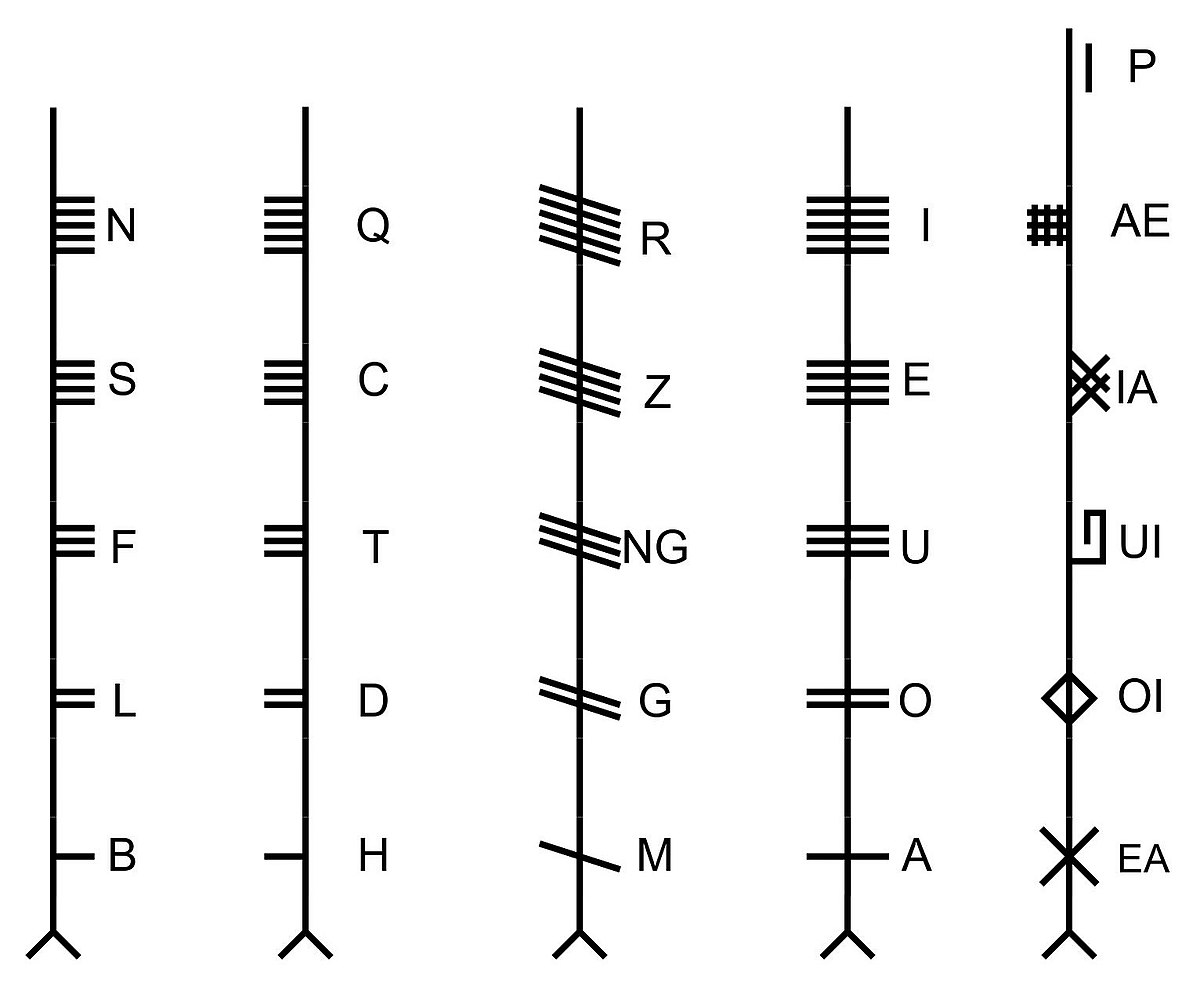
(the fifth column is officially a later addition, but I dig deeper and claim that it's name in comparison to the B-aicme tell that it probably were triads, not pentads. And vowel A U I would be just one difference away from A I U and I can see A at the same line B is, and I at the same line N is, and N is almost M, so was M moved to where it is, in it's own aicme to align M to B? Why these guesses, and F at the same line U is, and it is very alphabetic, so why would I ever want to arrange labials differently than
A U I
ᚐ ᚑ ᚒ
B F M
ᚁ ᚂ ᚃ
G H N (here I went phonetically the way I did with the 20-letter russian alphabet)
ᚆ ᚇ ᚈ
then I see another way to do it:
A U I
ᚐ ᚑ ᚒ
B F M
ᚁ ᚂ ᚃ
H T Q
ᚆ ᚇ ᚈ
Such is the actual letters at the position of U and I
And yet still H~G~Dʒ and T~Ч and Q~Ŋ
J Ч Ŋ? all three are lingual and fit their labial partners perfectly: Ж after V, Ч after Ф, N after M.
let rearrange that hypothetic proto-ogham in more alphabetic manner:
Æ V Ж
I M N
U F T
Æ V Ж
I M N
U P T
гнать гнить гнуть
жать жить жуть
пылать пылить (~, если дым~пыль)
красть крысить (~, direct synonyms. крысить улыбаясь, лицемерно)
руны~вруны?~говоруны~голово_руны (ри в руны то же что и в речь, говорить)
врать~гоВОРИТЬ
речь, выходит, не только устная, письменная тоже речь, reich, повеление.
Слово слава
Быть может лучше вести себя как профессионалы и обсуждать только проект (политота туда может проникнуть, когда я признаюсь в предвзятости относительно того кто от кого произоли (и здесь может я причину (генетику продажную девку империализьму) указывать не стану, тогда без политики, но отчего бы не воспользоваться артистической свободой и не поднять сложные вопросы политических предпочтений как экстралингвистических факторов. В общем, это не манифест, отвечаю очень научная публикация, потому выссказывая предположение о том, что после того как структура алфавитов сделала очевидным возможность использовать мифы о происхождении письменности как исторический материал, теперь сравнительный анализ мифов о происхождении языка можно использовать как менгиры-визиры, слепки состояния письменности на разных этапах. И здесь противоречие: еврейский миф говорит о трёх буквах как тех самых трёх "матерях" и что они буквально три материи, греческий на самом раннем этапе знает уже семь букв.. внезапно, погоди, а разве те семь букв не те же ли что в еврейских "двойных"? ב ג ד כ פ ר ת. Сразу подкупает, что первая Б, а последняя Т, как в греческом мифе, говорящем то ли о Α Β Η Τ Ι Υ [?], то ли о AEIOU BT, но в свете того, что существует историческое свидетельство о дополнении трёх гласных (при сравнении алфавитов распознанных как Η и Ω, или в латыни полугласные Y и W (body, knew). Структура алфавита разделяет все буквы на гласные, губные и язычные, или относящихся к А М С если использовать запись кники сотворения (алфавита, это описание сотворения не мира (мы не видели) а алфавита, очевидно создавшие его эту историю знали) Мифы говорят об абстрактных вещах доступными средствами, в сказках закодировали важную информацию, Это следующее предположение, тоже достойное проверки.
Я здесь всё перепишу, но на основании этой структуры (этого письма) я создам кусочек, который вставлю в завершительной части как plot-twist. В начале обещал что оба ща докажу что руны древнее финикийского, и такой в финале фильмы оба пагади. И прихожу к выводу, что алфавит сложная структура, т.е. сложенна из разных идей, и разумеется все идеи не обязаны были появляться в одном географическом месте, толкьо если они не были национальными, но различные формы алфавитов которые такие древние что никто толком не знает почему этот алфавит такой, а другой такой, исторические данные зачастую сами оказываются мифами, и в гораздо худшем смысле, и прихожу к идее об интернациональном создании письма с постоянным взаимным влиянием, с заслугой разных народов по сохранению истории создания алфавита (говорящей что в этой нации был древний культурный центр, где кто-то знал грамоту (букву буквально, по гречески грамата) и даже преподавал её, так что знание закрепилось хотя бы в виде сохранившейся книги. И я только поскоблил в нескольких местах, я нашёл мифы лишь нескольких народов (греков, евреев, норвежцев или кем они там были, а такие мифы скорей всего есть у половины остальных, так что лишь собрав полностью дошедшую до нас информацию по этому вопросу сможем мы делать далеко идущие выводы. Но иде о том, что евреи сохранили кусочек общеевропейской (или даже общемировой) истории ставит им в несомненную заслугу, но в книге сотворения говорится о всех 22 буквах еврейского алфавита, т.е. текст относительно греческих мифов поздний, но текст могли дополнить позже...
по этикету женщины сидят между мужиками дабы предотвратить драки.
П как форма Г ?
Б как форма Г ?
В как форма Б ?
является ли восточный (ACB) набор первичным?
c~г
гнуть соncave con- and son on,
юдоль доля
аеиоу еиоуа
when I was a child, I said keka for печенье and now to my surprise I see cake in that word, and soon I realize that I probably tried кекс before I tried any cookie.
Если луски уплостит, то он будет махте и бит божет (бит может) налод станет мяхкоселдеснее.
Это пликласно, я насол как соклатит алфавит без потели смысла. силаблс are they? or were they.. too early to say. wor k some more on it.


I leave that Н with a horse trunk to make it belong among k's for ŋ is not Ng, but nG. nasal G
but let's make them normal:

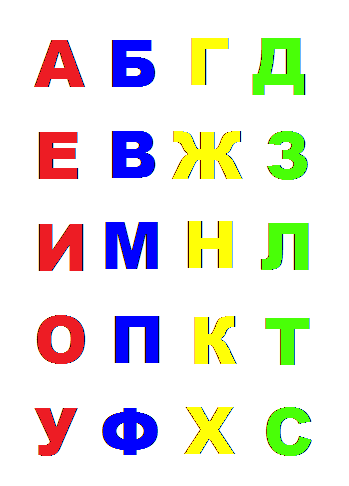
It doesn't even matter if I invented or discovered this thing, it works, and it makes language childish (but then I based it upod childish neglet of R and it all went to its place from there.
Let's build such thing for lating
A B G D
E V J Z
I M N L
O P C T
U F H S
H is thus both [h] if C is [k] and [ʃ] is C is [s] so I'm not sure if I need S because I had C already, buyt I had it as K, no reason for S to be across G
A B G D
E V J Z
I M N L
O P K T
U F H S
I'll rait laik zis for a vail bat zen I'm not a native what can I feel, hvat kan I feel. But I could read it, I kud rid it. let's play with it ending with T Then A M T is chess-knight-steps.
Let'z ios (u = io? ю?) zi legendari zikzteen. I didn't meet H yet, How do I spell hi, how are you without that U line? ki! kow a io. It wouldn't be understood. We need H for english. But do we need k when we have g?
A B G D
E V J Z
I M N L
O P H T (if H is [ʃ], it is the S)
high sigh? sight? витання.
(I don't practice as I preach, it would make it even more complicated for me)
Let's practice some more:
To be ol not to be, zat is zi hvestion.
Lookibng at how opht unites o and u lines by פ being p with a dot and f without it, ת being t with a dot, and something like s without it. and H is for both h and k? no, I didn't think it was. Were voiced-voiceless determined? because we reduce voiced to voiceless in weak positions, so we write voiced and pronounce voiceless. Doe s it implies that A B G D and E F H T (it used to be A B C D read G for C)
were they ABCD or ABCDEFHT? or ABGDIMNLOPHT
ABGDIMNLOPHT is 12 and thus could be used as zodiac, probably begining at Aries.
but it went all over the place without much of the meaning, but then I found
and the first alike sequence was:
Latvian: Auns Vērsis Dvīņi Vēzis Lauva Jaunava Svari Skorpions Strēlnieks Mežāzis Ūdensvīrs
but then it started funky, but then was weird (unless it is true that there used to be only 10 months and two were added, then three forms of S would make sense, and then it's worse than cherry-picking.
oh wow, check this out:
Malagasy:
Alahamady Adaoro Adizaoza Asorotany Alahasaty Asombola Adimizana Alakarabo Alakaosy Adijady Adalo
here's one beginnging with three B's, but it is here not because of that
Slovak: Baran Býk Blíženci Rak Lev Panna Váhy Škorpión Strelec Kozorožec Vodnár
but because it demonstrates how h stands for s: Váhy is Vesy in russian (they're literally cognates, but then would I see it if I didn't work this with this thing?
Thai wasn't about that sequence I'm looking for, but I couldn't help but noticed how similar to latin thai writing system is, graphically:
เมษ พฤษภ มิถุน กรกฎ สิงห์ กันย์ ตุล พฤศจิก ธันว์ มกร กุมภ์
wu waun unu nsnŋ avk nue ma waADn suɔ uns nun
Could it be that they have nothing in common? This I'm going to talk about today. tonight it is:
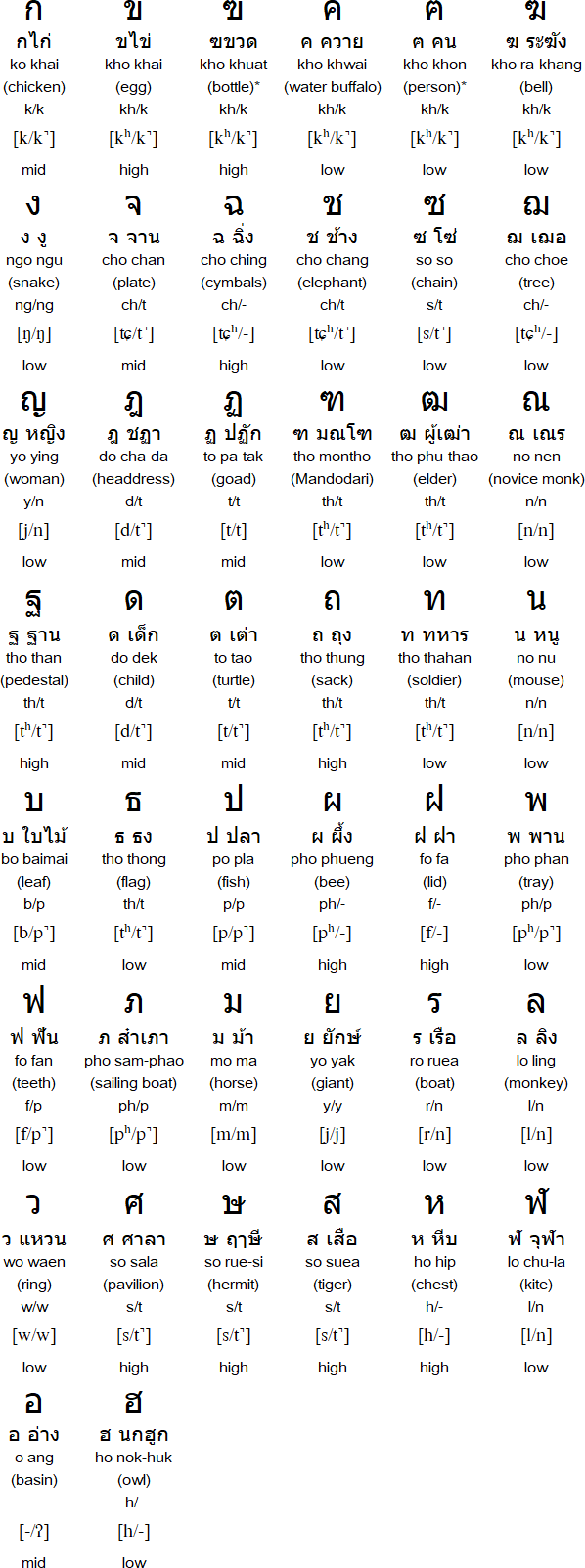
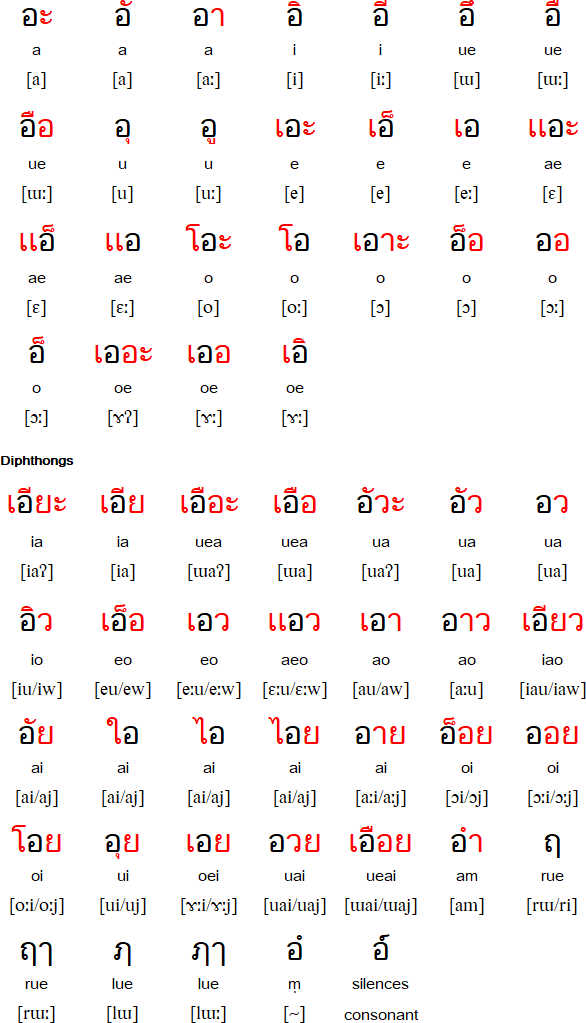
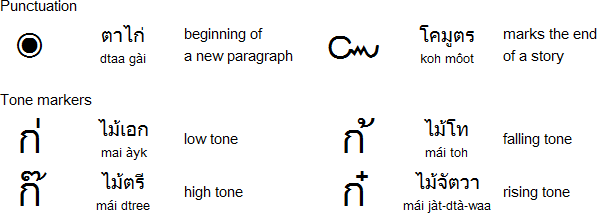

It's not much to talk about so far, it's to be studied,
so I kijked and I see that it's in japanese/indian canon, of (a) ka sa ta na
and it has more letters than necessary, many letters have identical readings, or am I missing something, it's yet to be figured out, it will make a large chapter in my book on eastern traditions.
fuck thai, my brains demand to continue lating for kids:
A B G D
E V J Z
I M N L
O P K T
Kan vi rait it like zis? ies ve kan!
Let'z vrait aboot ..it'z not a veri good tezt, I zhould trai zatj kort (k~c~s~ʃ)
If I use K instead of H which I used to use instead of Sh, then it makes short and korotky cognates, but then.. I could use some combination of letters, but that trick allows me to try 15-letter alphabet for russian and then I notice that I can combine vwls rdndnt thing and get away with twelve letter alphabet capable of transmitting any thought, but that's only theory, let's try it:
B G D
V J Z
M N L
P K T
t b l nt t b
or as l makes it cognatic to russian ili(или, or)
zt z z kvztn
is and the as z, it is not very good, so..
zt jz z kvztn
a little better
vz tz nbll n z mnd t zffr (Whether 'tis nobler in the mind to suffer)
But then if I tolerate z instead of s, let's make it even smaller, the 9 roots (9 runes?) poetic edda speaks of in the beginning.
BCD
MNL
FHS
or did I have to place M in the middle? to maintain the BMS diagonal, and then I realize it was AMS and we rejected vowels. Should I reject the division of C from D instead?
A B C
I M L
V H S
c b l m s b (To be or not to be)
it is how would to be or not to be begin in such a set. And here I remind myself that C is voiced, G
абg
iml
hst? but labials!
абg
iml
???
ABC was all there was?
c b a b c b (To be or not to be)
no ~ bu, if I cannot find sound I need, it's cool to take from neighbours what variants they have. no is bu? It would explain ν[n]
cbabcb could be used as musical record. first seven or so letters are
c b a b c b c c a cbcb (To be or not to be, that is the question)
cb ~ живи
also себе, but живи is also semantically cognate to "to be".
bc c cbca ac(or ab) c bacc c cbba (Whether 'tis nobler in the mind to suffer)
ca and c are two different c: one is ka and other's si, or is it sa and k? ci & c they are? IBC?
ا ب ت or ا ب خ?
c ccc ac acabc ab accacac (The slings and arrows of outrageous fortune,)
(I decided to consider affricates and dyphtongs single sounds, chinese hieroglypic approves)
(tyes, until that hieroglyphics proven japanese or whatever other location is involved the most, probably none of currently existing ones, so until I prove my suspicion to be true, kanji is deemed chinese)
косточка хвосточка
let's do it again, this time for russian:
Б Г Д
В Ж З
М Н Л
П К Т
бт л н бт вт в тм вплз
в чём ~ в том?
вопрос~вполз~выполз? очень интересно
I found me a nick-name^
Deemer O'kolnycow
holy instead of kolny? Sacred cow is stabbed with a single masterful hit.
Am I about to be sacrificied? I have to protect myself in
O'Hara, so why not O'KolnyCow? Why that Cow is in the end of my name? We're cattle,
Deemer
this is better thanb doomer, than boomer, even better than dreamer.
and to my astonishing surprise I notice mere in deemer, and it was there in the original form of the name of dmitry~dimitriy~d'metry~of_mother~деметры
нация кров и раса (кровь и кров когнаты, потому что родственники по крови часто делят кров)
одна кровь ~ один кров, один поклов, к.. покров, шатёр
нация семья и раса три уровня одной идеи, отчего-то расположенные не по порядку:
кровь нация и раса, но лучше продолжить эту идею:
родня страна планета
семья страна планета
сотня миллионы миллиарды
и видя последовательность, я осознаю, что семья должна быть тысячью человек, которой она станет если друзей туда включить
тысячи это небольшой городок, где все друг друга знают.
миллионы это тысячи таких городков
миллиарды это всё человечество и примкнувшие к ним.
впрочем, раса это тоже миллиарды. во всяком случае один.
Lusky is like losers a little bit, but even that is better thatn crusher, рушить is literally to crush in russian.
Lusky is similar to Lucky too, and lose key is lost key, russian is the lost key of the european civilization, and that key was the voiced before voiceless, and it helped me build the primordial table of
ABGD
E VJ Z
I MLN
O PKT
U FHS
to be ol not to be, that is the kuestion.. (ol is closer to аль which is its cognate in old russian)
I seem to get away with this set perfectly, not now let's try it without vowels:
t b l nt t b, tht s th kvstn, and it is great, 15 letter alphabet is approved to be capable of transmittion information.
And this way each or every or almost every letter has intricate indigenous meaning.
a as one? seems to be of late origin, which correlates with russian being b being the first letter in religious texts (those who wrote the most ancient religious texts probably were aware of some systemic structures in the writing systems they were using, so that it would be easier to memorize and adopt, if it heas some structure, and we can see that the 20 letter alphabet is capable, but then even 3 letter alphabet seems to be alright, so 9 letter alphabet should be somewhere in between.
B G D
L M N
P Q T
t b l nt t b tt t t qttn
btd (voiced) tm t b ml mptnt tn pltb l plqtb, bt t ttl mtt
ltt tl t t tl pt (way as path, synonyms, I should collect them and so I will see what letters and words are of later origin that these 9-letter triple three aettir if I may so say. And then I can sort out the historic aettir to see if any of them can be aligned along these lines., so let's try the other way, supposing fricative/plosive is more important than voiced/voiceless:
BGD
LMN
V J Z
d b l nd d b, dz z z gvzdn
this as deze is always great
WIZ in the final line is also awesome, unexpected Z as the final letter is great as well.
looking at the awkward BMZ I suspect AMZ to be in there,
ABG
LMN
V J Z
..and herfe I notice that for whatever reason M is not with other labials again.
ABG
LMN
J V Z
Ali? or do I have such to choose from irrelevant 6 or whatever?
But such conceptualist structure works much less:
z b l n z b
g b l n g b
n b l n n b
D or T seem to be essential, so I have it the other way:
ABD
LMN
J V Z
or
A B C
L M N
X Y Z
as the most memetic triads, but then where is D or T? X is T.
if X is 10, then Y is 7.5? or 100? z would be badass thousand: zouzanz
if X is 10, L is 5
if X is 8, L is 4
A is always one, but what are the B C M N?
if L is 5 and Y is 100, M is 50, B is something between 10 and 50
if L is 4 and Y is..
1 ? ?
4 16 64
8 32 256
and seeing how the sequence goes 2 4 8 16 32.. I expect the next one to be 64, thus 128 instead of 256.. where have I misstepped? Why do I entertain this marginal possibility?
1 ? ?
5 50 500
10 100 1000
and
1 25 250
5 50 500
10 100 1000
and yet looking at it from the point of adding, I have some irregularity:
5 25 250
5 50 500
and if I look at it from the point of multiplication, it demands some other set as well:
5 2 2
2 2 2
and it could be an option, if we didn't consider 1 a number.
then we would also not need the awkward 25 and 250
5 50 500
10 100 1000
десяток да пол-десятка
сотня да пол-сотни
тысяча да пол-тысячи
But then I doubt it could be sufficient for writing.
oт чество
земля чество
честь во?
часть въ!
but then часть is only valid translation for землячество, отчество ближе к понятию честь.
что есть? честь=правда? часть=что (ты) есть (часть чего)
часть частица частичка
молот молоток молоточек
ресн? ресница ресничка
лезт? растение? растет? росна and maybe that рос[ros] is лос[los] in волос.
волос волосинка волосиночка
so не ресн, а рес. лез лес (волос вылос? моя детская алфавита реально доставляет)
короб коробок коробочек
к ребру, место сгиба. корбо короб = с рубмами
корявый с рваными ранами?
ко = со!
к = с (casually they have their own places and don't mix, but then there are plenty of cases where they are cognates: я с тобой, но я к тебе.
с[s] = with
к[k] = to
I think this belief could come out of my "w reverses what comes after it" delusion, or was it revelation I never really used it since I made a hiatus to return to this thing.
ABC
LMN
XYZ
c b l n c b
c to
b be
l or
n not
zc z cazcn
zc that's
z the
cazcn question
yza z nabla an z manc c zybl (Whether 'tis nobler in the mind to suffer)
ABC
LMN
XYZ
z zlncz anc allayz ab azlayzc balcn (The slings and arrows of outrageous fortune,)
(some weird proximity between words appear, like fortune is almost balance, but balacn, балаган? балабан? барабан. крутите барабан, колесо фортуны, что это за приколы, какой-то эйсид трип из слов поплыл.
that russian table of 12 letters was the smallest comprehensible abbreviation of the alphabet. This one is very conceptualist, but isn't really comprehensible.
Here I realize that I shouldn't work with foreign text, foreign to my soul it is, it's a blasphemy to call my fortune that, my life is what? It used to be that harsh, it is not really smooth til now, ..fuck tragedies, fuck shakespear, let him shake his spear somewhere else, fuck that shit.
l t tc almz acanzc a c ab clblz (Or to take arms against a sea of troubles)
ABC
LMN
XYZ
take and touch are both tk and it's tres poetique
The idea to rewrite all the worlds into abc and to check the new homonyms to see if of them more words are semantically similar than random ones. And that is a whole new branch of analysis.
anchor of angh
Yesterday I thought about just three letters constituting whole the alphabet, and then I saw them as EMШ: the palm with fingers placed horizontally, the palm with fingers looking down and the palm with fingers looking up. For if E is earth or air, it goes anywhere, water falls down and fire rises up.
And to my surprise today I accidentally find this image:
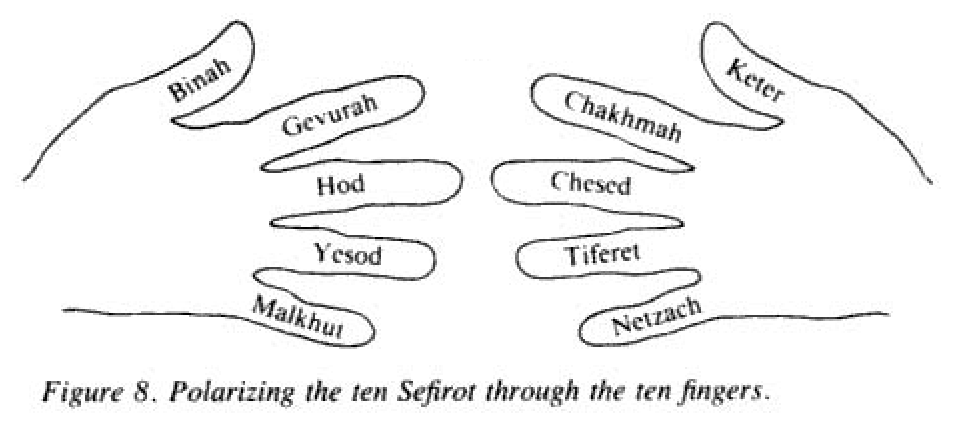
which is funny because that is how I imagined the E (the א of אמש) in that primitive sign-language (it had to start simple before it got complicated)
And in that book of formation the tree of life was discussed, if bible makes us know that there's such a tree eating from which we never die, makes all the smart ones
taboo = та boo
(because = is next to - and backspace, it's not additional stroke, it's more
Один is один.
I hanged on a tree (according to bible it cursed people, and those who cursed jews was cursed himself, bible is written by jews, they are openly called the god's chosen people, that is jewish book)
колдун ~ cursed (in that simplified alphabet)
колдун колядун колен.. колет он. killing, killed он.
kill done, these are poetic allusions, illusions, delusions, volutions, solutions polutions motions
lu is light? lux?
луч
пук~пах is smell? п is nose? нюх is literally the acceptor of пах (and it seems пах is both smelled and pubic (пукин))
pushъ king
poo-tin
tin as in si tin pin Si Ťin-pching
tin~cpo~coin(копим~копин)
king and ring could be hold the meaning of words k and r
ⵔ is r in tifinagh. Is tifinagh the origin of the word ring?
what about king? I thought k was key, and what is it in tifinagh?
ⴰⴱⴲⴳⴴⴵⴶⴷⴸⴹⴺ
ⴻⴼⴽⴾⴿⵀⵁⵂⵃⵄⵅⵆⵇⵈ
ⵉⵊⵋⵌⵍⵎⵏⵐⵑ
ⵒⵓⵔⵕⵖⵗⵘⵙⵚⵛⵜⵝⵞⵟ
ⵠⵡⵢⵣⵤⵥⵦⵧ
Tifinagh has much larger set of letters, but then it follows european alphabets, epsecially in the first half of it, notice that M in the third line, and then it makes some weird switch: it places labials before vowels. ⵡ is sowetimes transscribed as w, but it looks like u and it is U because I think I saw ⵡ transliterated as u, but no. probablu U is ⵓ which stands at the place of O, probably because runes and ogham have it like that. Little did they know that O is U is the final line, Tifinagh just divided those O and U lines earlier than runes. But this is nothing but speculations.
What is the most interesting about tifinagh is its variability that they can roatate the letter and have another variant of it. And because the variantsa are fricative (which as I thought were in the alphabet, it seems to me that they borrowed foreign system, the system simple and conscise and complicated it with their understanding of b and v being the same letter, and it shouldn't be in other letter if it's read differently due to position, so they would have ч in молоточек with the same but rotated к in молоток.
and I came here to find that k, and what I found was ⴽ ⴾ ⴿ for variants of the same letter, k or kh and I would say some more if I spoke amazigh.
and then I notice that official tables unite those rotated and modified variants under single umbrellas:

here's the explanation of what those rotated and modified variants of the tifinagh unicode set are:
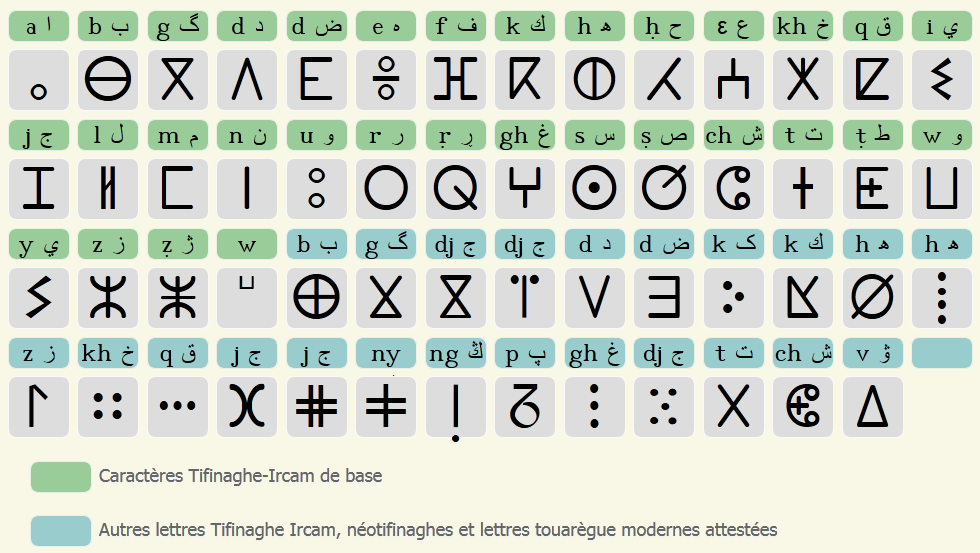
and some interesting different canon:
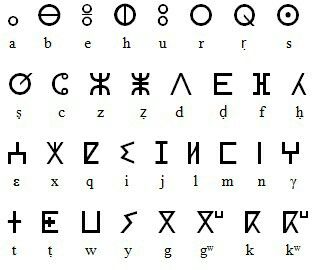
but once again it leads nowhere, just some local variant of the great global alphabet system I do not understand yet a) because my mind is somewhere else, b) because I'm not even high yet (good morning, it's me continuing that tifinagh I began to day on the next morning (bike велик is also not high, but that is a memory, not the new stuff, which new stuff follows, but after I got hight)
bike~big
велик~велик
russia рюша развалюша разварюша (и от слова разваливается и от слова разворовывается, вор ворует валит варит (людоедство) рвёт и ревёт скорей всего когнаты and of tear
рвёт=дерёт
рваться=драться
в после р = д перед р?
da = ab?
bu = out?
no = out?
da = de = of
if what I say is true, R is vowel
RST?
LMN
XYZ
LMN
RST
XYZ
d
h
lmn
rst
xyz
d
h
l m n
r s t
x y z
a b c
e f g
i j k
o p q
u v w
I felt like comparing staveless runes to runes with staff to see which were the original G's and which was added later to complete the system:

.png)
And the winners are..
ᚢᚿᛆᛐᛚ (ᛐ is ᛏ) and.. ᛌ (ᛌ is ᛋ, just in the beatles's fans are the beatles' fans)
then somehow similar are ᚦ and.. ᛁ is literally ᛁ
then the ᚠᚱᚴᚼᛒᛘᛦ are what? later addition or did they just have some shapes I haven't met yet?
Also notice how staveless ᛘ and ᛦ(ᛧ) reflect each other, and it makes me ask if that ᛌ is m the ᛘ and not s the ᛉ and then ᛦ which stands next to the ᛧ leads to the same algiz ᛉ does, so it seems to be the same rune, just laying upside down. And so is K the opposite of A?
Is lie L the tongue out? Russian homonym of lie, лай, is barking, but sometimes that word is referred to loud and emotional talking.
Lingua ~ lying?
в украинском врать (to lie) брехати, по русски иногда говорят, что собака брешет, когда она негромко лает.
aye is anytime.
a is an is any
ye = time?
nay, aye = yes, a.
nay is un_aye, not_aye
aye~eye глаз~класс? класс - это древнее слово, у него куча контекстов, куча смыслов, и
roots of language is so dirty, that even худой is probably of хуй (thin as dick? in english it's rather thick as dick, language determines mentality) it's not certain yet, but хуёвый is literally худой (bad)
if хуй is bad, пизда is good. I thought голова was good, хороша~голова
(this piece is raw oh so much very low (low level of fright))
what causes disgust is discussed
δ is greek d, but russian b, which correlates to bi and di standing for two (bisexual, diploid)
and then russian g is d. I wonder what could these facts tell.

Meditating on взагалі I found that the final line of latin alphabet gives away the protostructure of
A B D
U V Z
and because U and V used to be the same letter (was it? like I and J. are they?)
If U~V, then A~B? a~Б?
ab is latin suffix:
ăb (ā, ābs, aps)
preposition
1 (agency) by
2 (time) since
3 (time) from
4 (time) after
5 (named) after
6 on
7 in
8 (cause, reason) out of
9 (cause, reason) from
10 designating a charge
ab hoc = therefore, owing to this, for that reason || ab initio = from the beginning, from the start || ab ira = due to anger || a valetudinario = nurse || ab oriente = to the East || ab re = inopportune, useless, out of place || ab imo = from below || a me = from my house || accipio a = to receive from || ab summo = to start from the peak || aliquid ab aliquo || ab ovo || ab … ad (usque ad) || a bibliotheca = librarian || ab omni parte = from all sides, in every respect || ab omni, quod … = far from everything that … || ab reo dico = to speak in favor of the accused || ab Opis (aede) = on the side of the temple of Ops || ab re divina = after the sacrifice || ab ineunte aetate || a latere (or a lateribus or ex latere) = on the side, alongside || a Marcus Tullio sum = to come from M. Tullius || a materno genere = from the mother's side || ea abs te parvo curata sunt || a more maiorum = according to the customs of the ancients || a prima luce = since dawn || a primo mane = early in the morning || a re publica = by means of the State || a vero, a falso = for truth, for falsehood || ab ea parte = from this side || ab eo loco = starting from those words, from that passage || ab ovo usque ad mala = from the egg to apples (that is from appetizers to fruits, or from the beginning to the end) || ea abs te diligenter parvoque curata sunt || a medio ad summum = from the center to the extremities || a certo sensu et vero iudicare de aliquo = judge someone with a true and sure sentiment
From and in are great words to start the text, if alphabet is text.
ab = of = в = in (and that could be the pictogram of V, ν, ↓, 🜄. whether it's v or n
ab=ב, and without dots it is В[v] and it made me think: will were russian the true jews?
I want to go away. can.
I want to go awaken
ABD
UVZ
BD
VZ отдельно, AU оr AEIOU отдельно
bd
pq are probably the basis of the alphabet and if it's so, innuit is innate in a way:

ka ku
ki ??
and at first I thought it was some mistake, but no, they seem to have only three vowels: A I U only in their own order of IUA and if this order is ingenous (why wouldn't it be, how would they know, maybe they do, but it's just not in the literature, have to make a field findings, but I cannot go there myself, not to contaminate the field, I need somebody clueless of what I'm looking for to be able to take a survey. And I demand it to be made on video, and I pay for hours of video, so they won't be motivated to hide some footage from me, unless they have intention to set me up, but then why would they.
It is interesting that shapes of b d p are ka ku ki, it's oghamic order. Ogham is the most neighbouring to innuit I know of. And if innuit was abugida (which it is, but if the word innuit was, it would thus be annuit, and I know this word from the same continent but from the completely different culture.
Annuit cœptis (/ˈænuɪt ˈsɛptɪs/, Classical Latin: [ˈannʊ.ɪt ˈkoe̯ptiːs]) is one of two mottos on the reverse side of the Great Seal of the United States. The literal translation is "[He] favors (or "has favored") [our] undertakings", from Latin annuo ("I approve, I favor"), and coeptum ("commencement, undertaking"). Because of its context as a caption above the Eye of Providence, the standard translations are "Providence favors our undertakings" and "Providence has favored our undertakings".
It is interesting that they don't have the 🜄 vowel, as if they were so positive, they wouldn't make people cry by not spelling the water sign, the downwards side, the water~fall sign. And if a christian made it, he would not have a reason a) to use such estravagant solution, only making it more difficult to learn the system for europeans, instead of using the system they already knew and b) he would have no reason to avoid two vowels he would inevitably need to transliterate the names of his biblical characters.
AIU order is
This is how it goes in unicode, so if the masters of reality know the true history, that order could be not a coincidence (but it is one of those crazy ideas, the probability of being true for which is not very high, because apophenia exists.
ሀሁሂሃሄህሆሇለሉሊላሌልሎሏሐሑሒሓሔሕሖሗመሙሚማሜምሞሟሠሡሢሣሤሥሦሧረሩሪራሬርሮሯሰሱሲሳሴስሶሷ
ሸሹሺሻሼሽሾሿቀቁቂቃቄቅቆቇቈቊቋቌቍቐቑቒቓቔቕቖቘቚቛቜቝበቡቢባቤብቦቧቨቩቪቫቬቭቮቯ
ተቱቲታቴትቶቷቸቹቺቻቼችቾቿኀኁኂኃኄኅኆኇኈኊኋኌኍነኑኒናኔንኖኗኘኙኚኛኜኝኞኟአኡኢኣኤእኦኧከኩኪካኬክኮኯኰኲኳኴኵ
ኸኹኺኻኼኽኾዀዂዃዄዅወዉዊዋዌውዎዏዐዑዒዓዔዕዖዘዙዚዛዜዝዞዟዠዡዢዣዤዥዦዧየዩዪያዬይዮዯደዱዲዳዴድዶዷዸ
ዹዺዻዼዽዾዿጀጁጂጃጄጅጆጇገጉጊጋጌግጎጏጐጒጓጔጕጘጙጚጛጜጝጞጟጠጡጢጣጤጥጦጧጨጩጪጫጬጭጮጯጰጱጲ
ጳጴጵጶጷጸጹጺጻጼጽጾጿፀፁፂፃፄፅፆፇፈፉፊፋፌፍፎፏፐፑፒፓፔፕፖፗፘፙፚ፝፞፟፠፡ ።፣፤፥፦፧፨፩፪፫፬፭፮፯፰፱፲፳፴፵፶፷፸፹፺፻፼
ᎀᎁᎂᎃᎄᎅᎆᎇᎈᎉᎊᎋᎌᎍᎎᎏ᎐᎑᎒᎓᎔᎕᎖᎗᎘᎙ᎠᎡᎢᎣᎤᎥᎦᎧᎨᎩᎪᎫᎬᎭᎮᎯᎰᎱᎲᎳᎴᎵᎶᎷᎸᎹᎺ
ᎻᎼᎽᎾᎿᏀᏁᏂᏃᏄᏅᏆᏇᏈᏉᏊᏋᏌᏍᏎᏏᏐᏑᏒᏓᏔᏕᏖᏗᏘᏙᏚᏛᏜᏝᏞᏟᏠᏡᏢᏣᏤᏥᏦᏧᏨᏩᏪᏫᏬᏭᏮᏯᏰᏱᏲ
ᏳᏴᏵᏸᏹᏺᏻᏼᏽ ᐀ᐁᐂᐃᐄᐅᐆᐇᐈᐉᐊᐋᐌᐍᐎᐏᐐᐑᐒᐓᐔᐕᐖᐗᐘᐙᐚᐛᐜᐝᐞᐟᐠᐡᐢᐣᐤᐥᐦᐧᐨᐩᐪ
ᐫᐬᐭᐮᐯᐰᐱᐲᐳᐴᐵᐶᐷᐸᐹᐺᐻᐼᐽᐾᐿᑀᑁᑂᑃᑄᑅᑆᑇᑈᑉᑊᑋᑌᑍᑎᑏᑐᑑᑒᑓᑔᑕᑖᑗᑘᑙᑚᑛᑜ
ᑝᑞᑟᑠᑡᑢᑣᑤᑥᑦᑧᑨᑩᑪᑫᑬᑭᑮᑯᑰᑱᑲᑳᑴᑵᑶᑷᑸᑹᑺᑻᑼᑽᑾᑿᒀᒁᒂᒃᒄᒅᒆᒇᒈᒉᒊᒋᒌᒍᒎᒏᒐᒑᒒᒓᒔᒕᒖᒗ
ᒘᒙᒚᒛᒜᒝᒞᒟᒠᒡᒢᒣᒤᒥᒦᒧᒨᒩᒪᒫᒬᒭᒮᒯᒰᒱᒲᒳᒴᒵᒶᒷᒸᒹᒺᒻᒼᒽᒾᒿᓀᓁᓂᓃᓄᓅᓆᓇᓈᓉᓊᓋᓌᓍᓎᓏᓐᓑᓒᓓᓔᓕᓖ
ᓗᓘᓙᓚᓛᓜᓝᓞᓟᓠᓡᓢᓣᓤᓥᓦᓧᓨᓩᓪᓫᓬᓭᓮᓯᓰᓱᓲᓳᓴᓵᓶᓷᓸᓹᓺᓻᓼᓽᓾᓿᔀᔁᔂᔃᔄᔅᔆᔇᔈᔉᔊᔋᔌᔍᔎᔏᔐᔑᔒ
ᔓᔔᔕᔖᔗᔘᔙᔚᔛᔜᔝᔞᔟᔠᔡᔢᔣᔤᔥᔦᔧᔨᔩᔪᔫᔬᔭᔮᔯᔰᔱᔲᔳᔴᔵᔶᔷᔸᔹᔺᔻᔼᔽᔾᔿᕀᕁᕂᕃᕄᕅᕆᕇᕈᕉᕊᕋᕌ
ᕍᕎᕏᕐᕑᕒᕓᕔᕕᕖᕗᕘᕙᕚᕛᕜᕝᕞᕟᕠᕡᕢᕣᕤᕥᕦᕧᕨᕩᕪᕫᕬᕭᕮᕯᕰᕱᕲᕳᕴᕵᕶᕷᕸᕹᕺᕻᕼᕽᕾᕿᖀᖁᖂᖃᖄᖅᖆᖇᖈᖉ
ᖊᖋᖌᖍᖎᖏᖐᖑᖒᖓᖔᖕᖖᖗᖘᖙᖚᖛᖜᖝᖞᖟᖠᖡᖢᖣᖤᖥᖦᖧᖨᖩᖪᖫᖬᖭᖮᖯᖰᖱᖲᖳᖴᖵᖶᖷᖸᖹᖺᖻᖼᖽᖾᖿᗀᗁᗂᗃᗄᗅᗆᗇᗈ
ᗉᗊᗋᗌᗍᗎᗏᗐᗑᗒᗓᗔᗕᗖᗗᗘᗙᗚᗛᗜᗝᗞᗟᗠᗡᗢᗣᗤᗥᗦᗧᗨᗩᗪᗫᗬᗭᗮᗯᗰᗱᗲᗳᗴᗵᗶᗷᗸᗹᗺᗻᗼᗽᗾᗿᘀᘁᘂᘃᘄᘅᘆᘇᘈ
ᘉᘊᘋᘌᘍᘎᘏᘐᘑᘒᘓᘔᘕᘖᘗᘘᘙᘚᘛᘜᘝᘞᘟᘠᘡᘢᘣᘤᘥᘦᘧᘨᘩᘪᘫᘬᘭᘮᘯᘰᘱᘲᘳᘴᘵᘶᘷᘸᘹᘺᘻᘼᘽᘾᘿᙀᙁᙂᙃᙄᙅᙆᙇ
ᙈᙉᙊᙋᙌᙍᙎᙏᙐᙑᙒᙓᙔᙕᙖᙗᙘᙙᙚᙛᙜᙝᙞᙟᙠᙡᙢᙣᙤᙥᙦᙧᙨᙩᙪᙫᙬ᙭᙮ᙯᙰᙱᙲᙳᙴᙵᙶᙷᙸᙹᙺᙻᙼᙽᙾᙿ ᚁᚂᚃᚄᚅᚆᚇᚈᚉᚊᚋᚌᚍᚎᚏᚐᚑᚒᚓᚔᚕᚖᚗᚘᚙᚚ᚛᚜ᚠᚡᚢᚣᚤᚥᚦᚧᚨᚩᚪᚫᚬᚭᚮᚯᚰᚱᚲᚳᚴᚵᚶᚷᚸᚹᚺᚻᚼᚽᚾᚿᛀᛁᛂᛃᛄ
ᛅᛆᛇᛈᛉᛊᛋᛌᛍᛎᛏᛐᛑᛒᛓᛔᛕᛖᛗᛘᛙᛚᛛᛜᛝᛞᛟᛠᛡᛢᛣᛤᛥᛦᛧᛨᛩᛪ᛫᛬᛭ᛮᛯᛰᛱᛲᛳᛴᛵᛶᛷᛸ
ᜀᜁᜂᜃᜄᜅᜆᜇᜈᜉᜊᜋᜌᜍᜎᜏᜐᜑᜒᜓ᜔᜕ᜟᜠᜡᜢᜣᜤᜥᜦᜧᜨᜩᜪᜫᜬᜭᜮᜯᜰᜱᜲᜳ᜴
Very interesting order of ogham being exactly after the canadian writing systems, and there are so many of them, and as I understand they are still in use, no way such a bright bouquet of writing system if was invented in the xix century would not merge or come through major reforms. They're aboriginal and should be taken into consideration when the comparison happens across the globe, they are
That black segment is of all forms of canadian syllabaries: canadian aboriginal syllabary, inuktitut syllabary, déné syllabary, blackfoot syllabary, Unified Canadian Aboriginal Syllabics, and they're all mixed up with all the other writing systems of the region:
Carrier or Déné syllabics (ᑐᑊᘁᗕᑋᗸ, Dʌlk'ʷahke, (Dulkw'ahke) meaning toad feet) is a script created by Adrien-Gabriel Morice for the Carrier language. It was inspired by Cree syllabics and is one of the writing systems in the Canadian Aboriginal syllabics Unicode range.
this is how they were created "inspired" being pretty much similar, maybe more similar than greek uncial and russian.
Cree syllabics are the versions of Canadian Aboriginal syllabics used to write Cree dialects, including the original syllabics system created for Cree and Ojibwe. There are two main varieties of syllabics for Cree: Western Cree syllabics and Eastern Cree syllabics. Syllabics were later adapted to several other languages.[2] It is estimated that over 70,000 Algonquian-speaking people use the script, from Saskatchewan in the west to Hudson Bay in the east, the US border to Mackenzie and Kewatin (the Northwest Territories and Nunavut) in the north.
The Blackfoot language, also called Siksiká (its denomination in ISO 639-3, English: /siːkˈsiːkə/; Siksiká [sik͡siká], syllabics ᓱᖽᐧᖿ), often anglicised as Siksika, is an Algonquian language spoken by the Blackfoot or Niitsitapi people, who currently live in the northwestern plains of North America. There are four dialects, three of which are spoken in Alberta, Canada, and one of which is spoken in the United States: Siksiká (Blackfoot), to the southeast of Calgary, Alberta; Kainai (Blood, Many Chiefs), spoken in Alberta between Cardston and Lethbridge; Aapátohsipikani (Northern Piegan), to the west of Fort MacLeod which is Brocket (Piikani) and Aamsskáápipikani (Southern Piegan), in northwestern Montana.[2] The name Blackfoot probably comes from the blackened soles of the leather shoes that the people wore.[3]
A sign at the Siksika Health and Wellness Centre in Siksika 146 reads "Oki", a Blackfoot greeting
There is a distinct difference between Old Blackfoot (also called High Blackfoot), the dialect spoken by many older speakers, and New Blackfoot (also called Modern Blackfoot), the dialect spoken by younger speakers.[4] Among the Algonquian languages, Blackfoot is relatively divergent in phonology and lexicon.[5] The language has a fairly small phoneme inventory, consisting of 11 basic consonants and three basic vowels that have contrastive length counterparts. Blackfoot is a pitch accent language.[6][7] Blackfoot language has been declining in the number of native speakers and is classified as either a threatened or endangered language.
It tells three vowels, but then they give four:
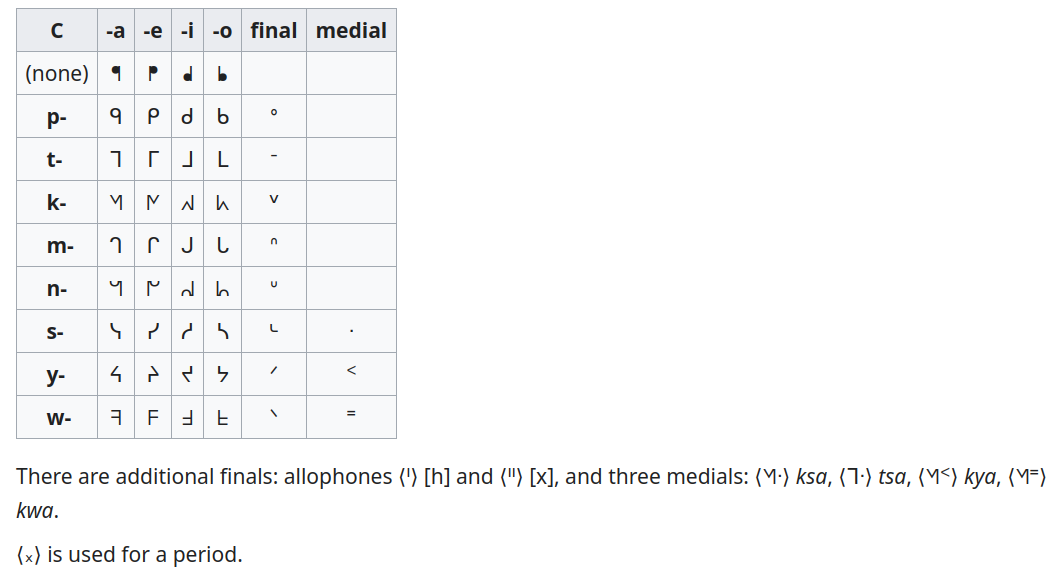
and though there they speculate that some latin letters could influence the creation of bigfoot syllabics, I dare to claim that the other way around (syllabaries modified into syllabics and abugidas, for it would make no sense to invent them the other way around. And because conquerers write the history, we cannot trust history for thus it is compromised. And according to mythology, Atlantis could be in the Atlantic ocean, and thus pyramids and writings appeared in american and from there spread to the east, and if this guess is true (it's more than just a guess, but whatever, if it's true, let's see the common shapes:
P is p and pe (as they righteously noticed in that wiki page, drawing wrong conclusions from that coincidence, in my opinion, so let's draw my conclusions out of it:
P N S y, maybe k as ko, and I recognize demotic M in ma:

or am I having too large a fantasy? And why would they use long obsolete digamma (if as they say some priest have invented it similar to european shape, and they say ᖴ is directly from digamma) because it's more like it is where digamma is coming from.
And comparing blackfoot syllabics to inuktitut (the one I (and some others from whom I took it) call innuit) I can say that those symobls probably stood for some things pronounced differently in different languages.
Inuit (not innuit) is language, inuktitut is the writing systme fro it)
And to show you how extremely close it is to europe, here's the map:
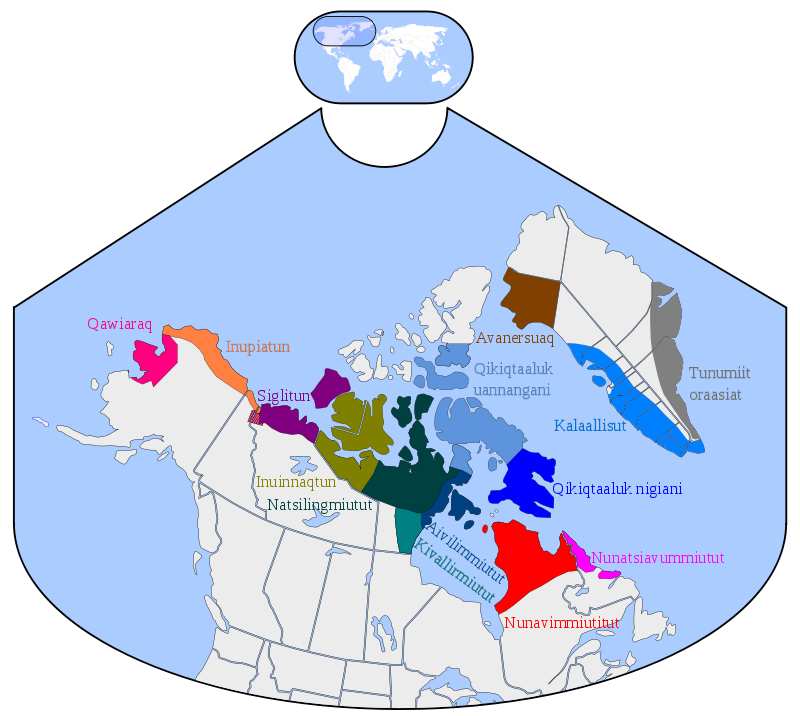

To let you know the scope we're talking of:
Human habitation in Newfoundland and Labrador can be traced back about 9,000 years.
Probably it took some skills to survive these wild lands, so I can easily suggets that some wisest of ancients escaped the madness of humanity into those frozen lands, where culture could crystallize into writing systems soon spread to europe up to Egypt and maybe to the east where chinese lived, but then I think that chinese writing system is even more archaic than canadian syllabics. So it makes me feel like the writing system went from pictograms of whatever up to cunieform and chinese hieroglyphics and egyptian hieroglyphics too, but the alphabetic ideas first appeared in Canada from where it went to Europe but not to Asia. And then it mostly went from west to the east, while disease of religions went from the east to the west and the Mesopotamia is probable locos of the beginning of both those waves, and if it is, mesopotamians were much friendly to people to their East (maybe because sun raised in there, so psychologically they were motivated to respect those people for that) and shared mistery of writing with chinese, but not with europeans, who only got that thing from Eskimo, and that enmity of mesopotapians happened to be a blessing in disguise, because much more abstract writing system naturally stimulated much more abstract mentallity, which gave birth (brought about) to all the technology, the way I see it. Does writing these thoughts down help me memorize them? Not to memorize, but to absorb them deeper so they return to the subconscious operative memory to bring about something more.
The order of the blackfoot syllabary is spectacular: pt as bd, the first consonants, there would be no reason to place them there if they were not there from the start, but then I understand that they could be placed there as b d, and only then rerationalized as p t, but then why would w go after y if it was arrange after latin alphabet.
But let's look at in

The same PT opening even though signs are all different. And why would they arrange vowels like that? AIU would make much more sense of ᐗᐃᐅ which is clockwise rotation. And then I find amongst unicode the fourth (hidden) "mother": ᐁ, and I see that I began my quest for bdpq in a wrong script. What they call canadian aboriginal syllabics has four vowels:
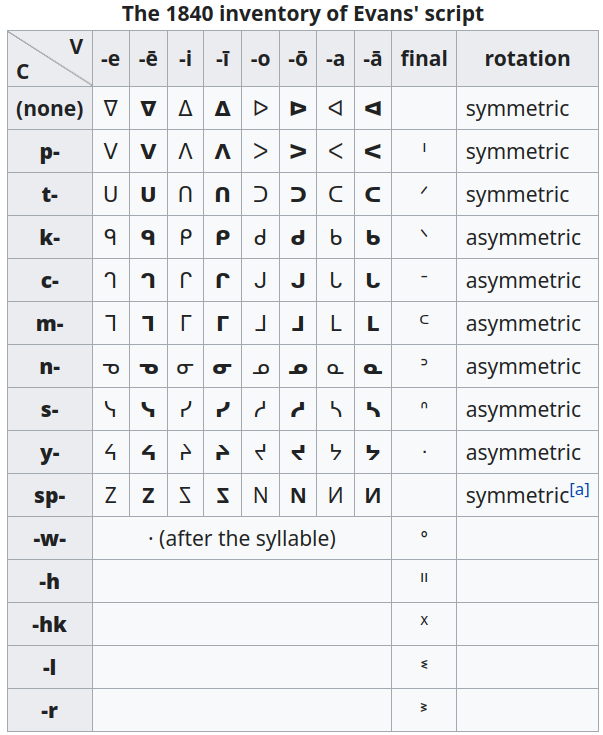
What is interesting here is that it can be divided into three groups beginning with labial:
p t k c
m n s y sp
w h hk l r
(and once again L before R, and here we can see even less proximity to latin alphabet's canon, but the sequence kmn is very alike and is also in the middle. And though I would understand why would they place closed syllables at the end and marked them differently, but all this is speculation, and though it'g goal is to figure out what it's all about, it's main objective so far is to get used to these syllabaries and thus to memorize them)
Cree syllabics is pretty based:

let's collect as many of them as I can find:

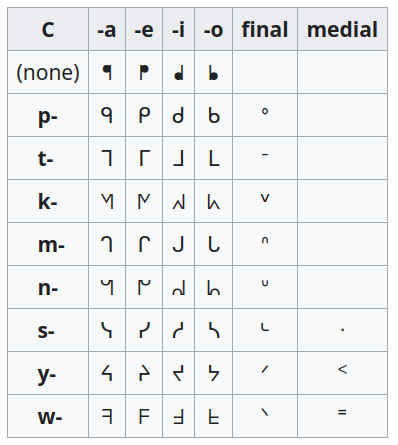
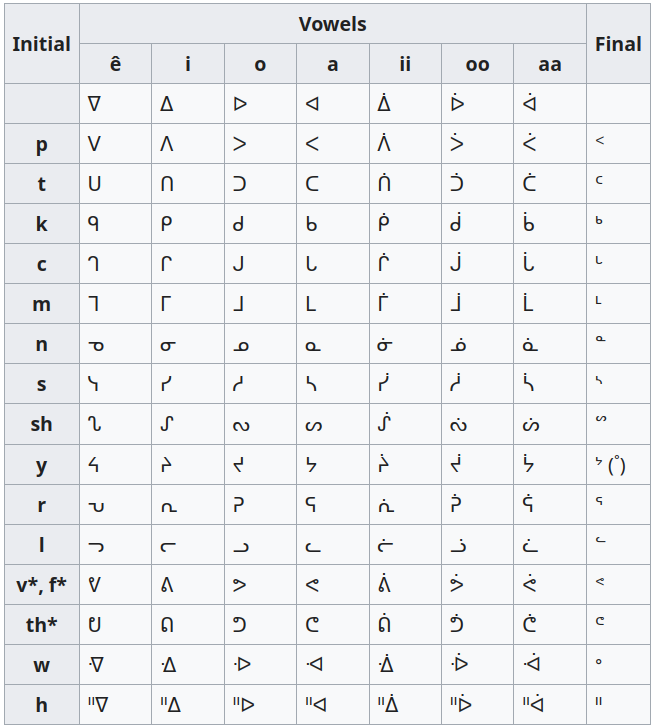
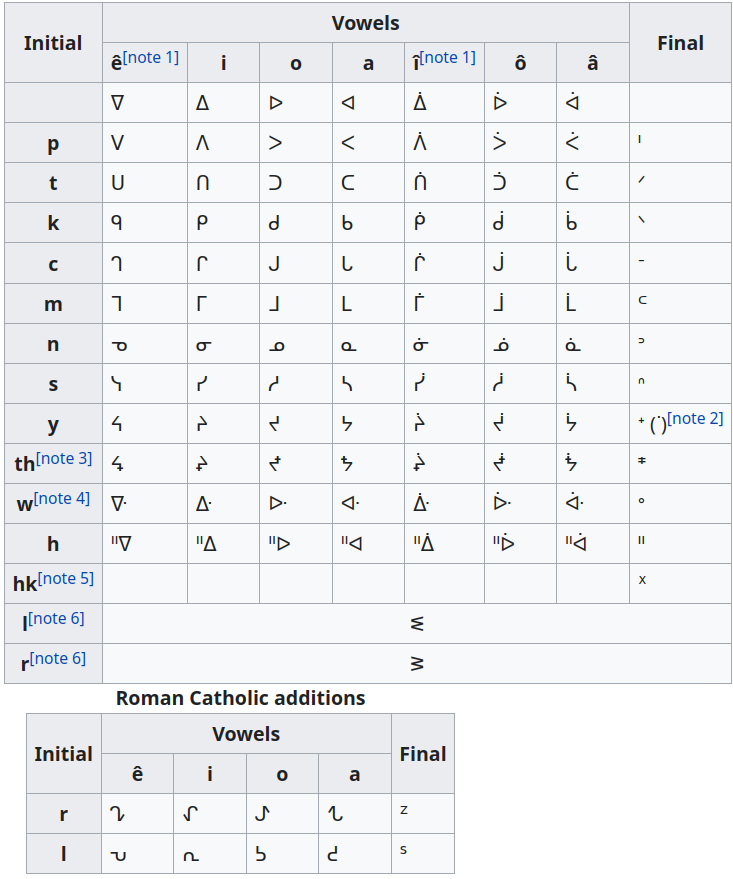
They all seem to agree on the transliteration of most form, except blackfoot, the ᖰᖱᖲᖳᖴᖵᖶᖷᖸᖹᖺᖻᖼᖽᖾᖿᗀᗁᗂᗃ plus the standard shapes of ᑫᑭᑯᑲ ᒣᒥᒧᒪ ᒉᒋᒍᒐ ᔦᔨᔪᔭ
But the most unusual syllabics of the region is The Carrier syllabary, aka Déné Syllabics:

There's no way they would adopt, or even less invent such monstrosity if they knew any better.
and yet here I am definitely out of my depth, there is some complicated history of those lands:
The Thule (US: /ˈθuːli/, /ˈtuːli/, UK: /ˈθjuːli/)[1][2] or proto-Inuit were the ancestors of all modern Inuit. They developed in coastal Alaska by the year 1000 and expanded eastward across northern Canada, reaching Greenland by the 13th century.[3] In the process, they replaced people of the earlier Dorset culture that had previously inhabited the region. The appellation "Thule" originates from the location of Thule (relocated and renamed Qaanaaq in 1953) in northwest Greenland, facing Canada, where the archaeological remains of the people were first found at Comer's Midden. The links between the Thule and the Inuit are biological, cultural, and linguistic.
But let's not distract, and return to the writing systems.
The publication of those writing systems (but under fake context of them being recently invented by the invaders) could be provoked by the publication of Cherokee syllabary a decade before that.
This Sequoia guy looks like european. Was it stylization to pacify the militant racists? The genocide was in process, so it could be anything, but I currently suspect that it is some european anthropologist:
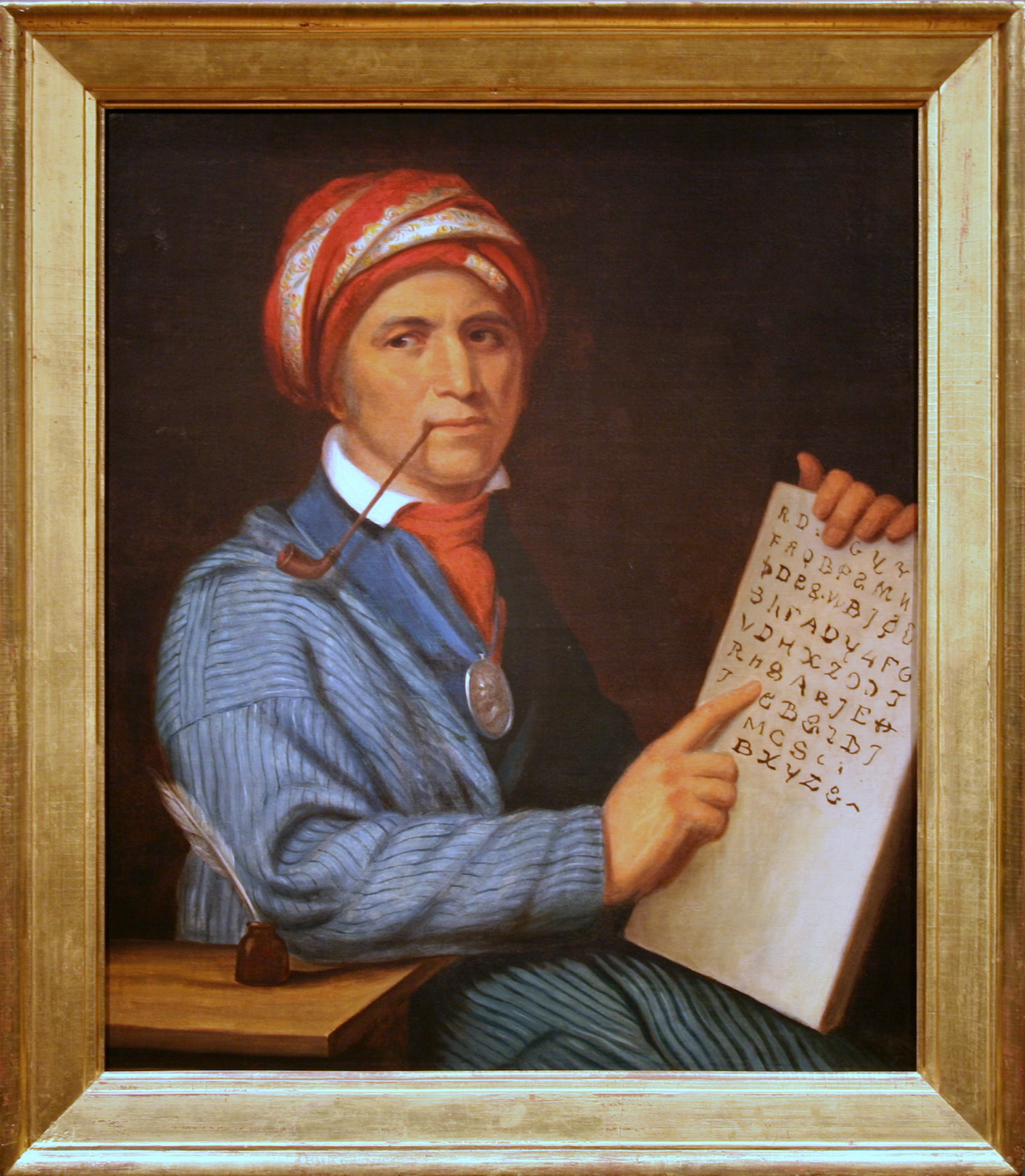

as you can see at that painting, the order of letters is somewhat different, but then I notice that some letters repeat, so probably it's not an abecedary shown in that picture, but some actual text. Yet it's funny how the fibnal line goes with XYZ and something similar to & and some punctuation mark maybe, whatever it is, the XYZ think is both fascinating and suspicious.
Maybe I open my mind way too much and my brains fall off? I don't know, but my task is to entertain every possibility. Because the conquerers write the history, I cannot trust the history.
But then this image seems to be exactly what Cherokee is holding, and it tells that I'm trippin:

Original Cherokee syllabary order, with the now obsolete letter Ᏽ in red
But then it only begins like that in that painting, so I have to ask if artist just made a sloppy job or was it all some psy-op to make cherokee people dislike their culture if this mess is an integral part of it?
And this rabbit hole goes on and on:
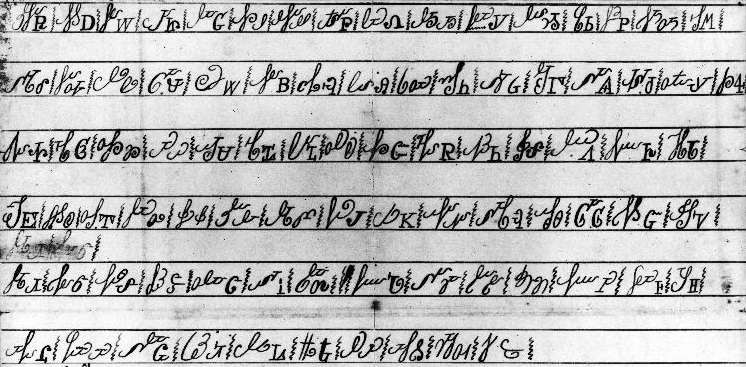
Sequoyah's original syllabary characters, showing both the script forms and the print forms
As if it was not complicated enough. But then now they look much more different from latin counterparts. And those cursive shapes could be the original aboriginal and the majuscule could be arbitrarily substituting them with neither sense or any correspondence to their forms.
Suddenly I think that maybe what Sequoia did was to arbitrarily substitute aboriginal cursive to the literas he could find in some typography's exotic fonts from different charts as it was supposed before me already, but then I could only find this:
In 1828, the order of the characters in a chart and the shapes of the characters were modified by Cherokee author and editor Elias Boudinot to adapt the syllabary to printing presses.
And to my surprise that "cherokee author" was white as snow. So what on earth is this? It's this:
Born to parents of mixed Cherokee and European ancestry and educated at the Foreign Mission School in Connecticut, he became one of several leaders who believed that acculturation was critical to Cherokee survival. He was influential in the period of removal to Indian Territory.
бачити
видеть
this pair tells that d~c (c is ч in celentano)
б~в, but that is what I already knew
I knew both these things, it is interesting to see
Как так получилось, что славик в английском ближе всего к слэйв? У них что, нет других слов? serve is another word, and it's closest to serb.
Could it be natural that whites who were geographically isolated tend to be servile to somebody as technologically and culturally advanced as those whites who were in the middle of their civilization?
But then the civilization could have grown also with help of some of those who went out of those isolated groups for the centraal to study and contribute, and I think (and I'm a proof of) that russians are fit for advancing the civiliization by their intellectual capabilities, but then they also have misgenes or mismemes:
rutheina is rude
голландия галантна
натягивать сову на глобус ~ не этим ли я здесь буквально занимаюсь?
If all labials were the same B, and all linguals were the same T, as I pretty much state in my бачити=видеть, then so is сова=глоба
ow in owl is ов in сова?
брат враг are so similar in russian, but then similar are also
ami enemy, as if enemy is unami
брат враг are ami unami?
un turns б into в
та тонкая грань между брать и врать (верну, например. хуже если не брал (ложь о будущем простительней))
that thin line bet-win беру и вру/ворую (ю is io(я) thus юя is the claster of йотированных)
Nominativus ia
Accusativus iu
Genetivus ii (I&I? y? ij? jij? ij=их? ich jij их, how can ih be three persons in one? is it the three mothers three in one? Could it be one witch between three mirrors? Then runes should be... they would be the same, because left and right are arbitrary in the bustrophaedon writing systems, of which runes are.
bi is two letters
tri is three letters
a is one letter
tu is two letters, but two is three letters. is wo some ω?
tω? τω? два is three letters is ва ω? is ω в? staveless в?
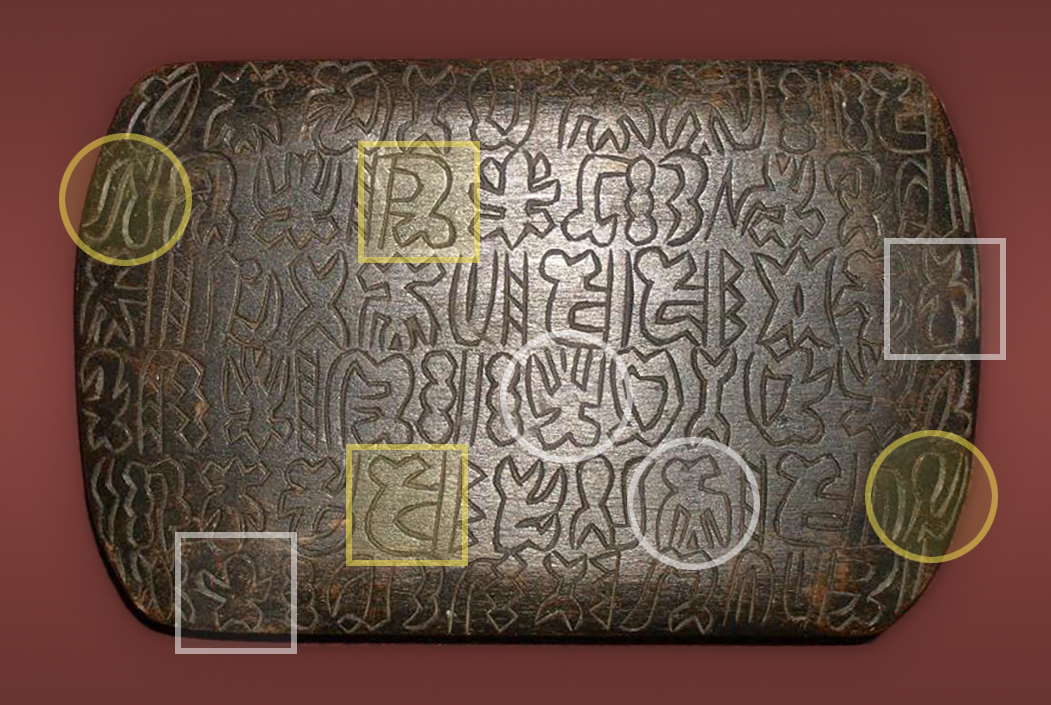
I just had two revelations: three revelations:
the figure in yellow square is koala
because the third line contains two koalas it's whether a plural form or this is a syllabary.
And this possibilities of it being plural form is the fourth revelation.
third revelation was that if it's a syllabary we can hypothize that the sound is a scream of koala the way locals immitate it.
And such self-evident encryption can be saying that this is the most ancient attempt in writing. Pashi culture is really ancient. Could our ancestors land at the most clear area of ice so that they know they don't die off from some microbe (which could be a larger possibility if they landed in the jungle) but then they would have the writing system they wouldn't have to invent it. So the idea of our culture being sent to us from space is debunked. And how many revelations is this? I think these volumes are as many revelations as there are lines in it. And even if not all of them are good, some are just incredibly great.
I can understand if it's hieroglyphics or syllabary by looking at more tablets. If it's a syllable, it has to be all over them, it's once or twice per a line in here, so if it's the peculiarity of this table, then it's a tale of koala, and if it's all over the place, it's a syllable sounding as that koala screams.
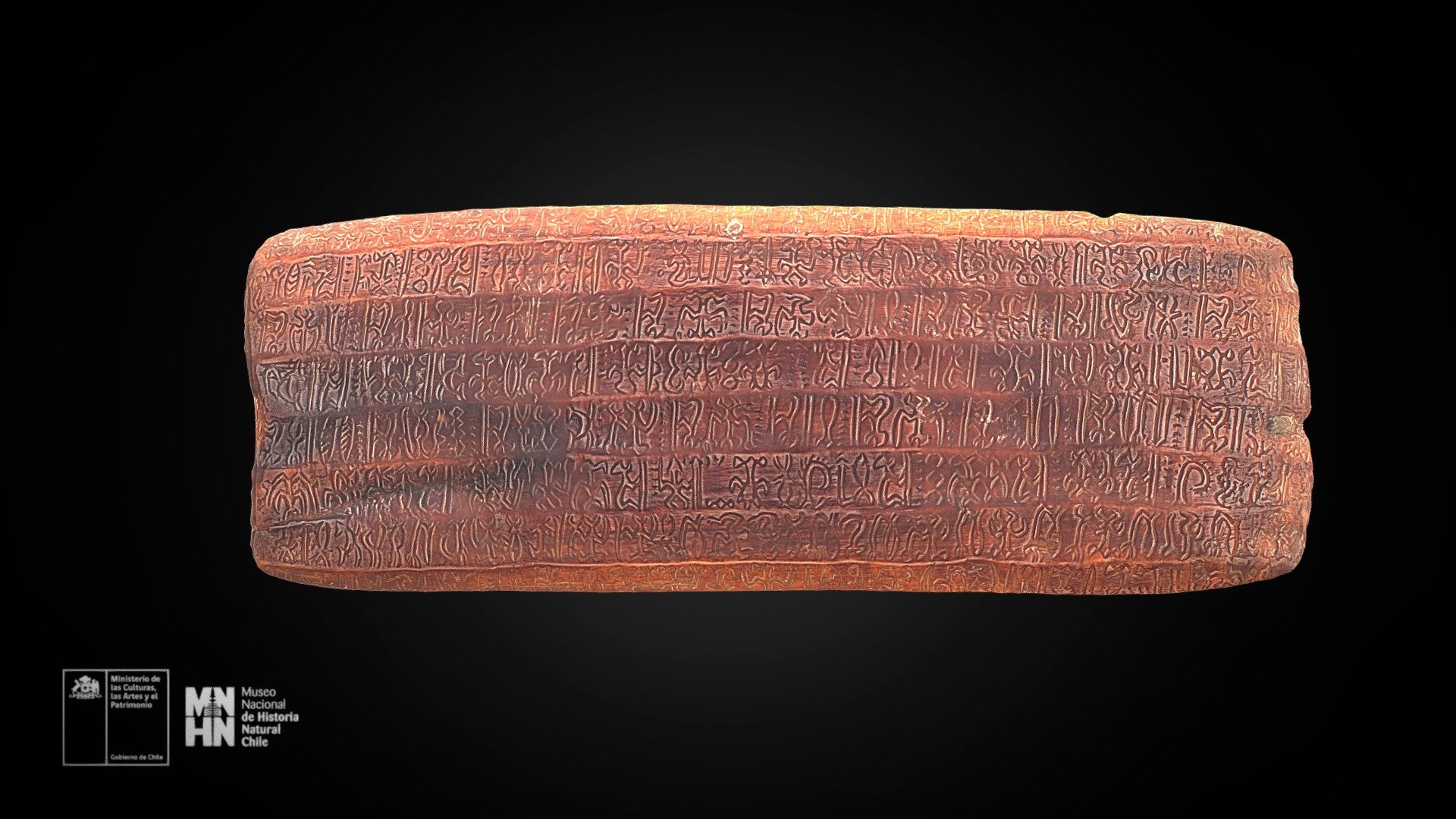
(click it, it's in 3d in therte)
And the first readable tablet I found also has this sign in abundance, thus it is a syllable, and I think I know how to read it:
(mirror)
But then this (the most famous, but in a horrible quality)
tablet has similar sign but it doesn't show the tree:

Here you can see this eared shape above and to the left from the centre of the most highlited line.
And at left from it we can see another koala shape, probably standing for another sound they make:
(mirror)
So those two signs together could stand for яр or, if the egyptian rule of symbols looking at the beginning of the line is correct, it's a very pidorashque syllable ря. Or, if they're syllables, уря.
But then they also pronounce some other sounds:
(mirror)
Here's another rongorongo writings with this ur or whatever it could be, with tree this time:
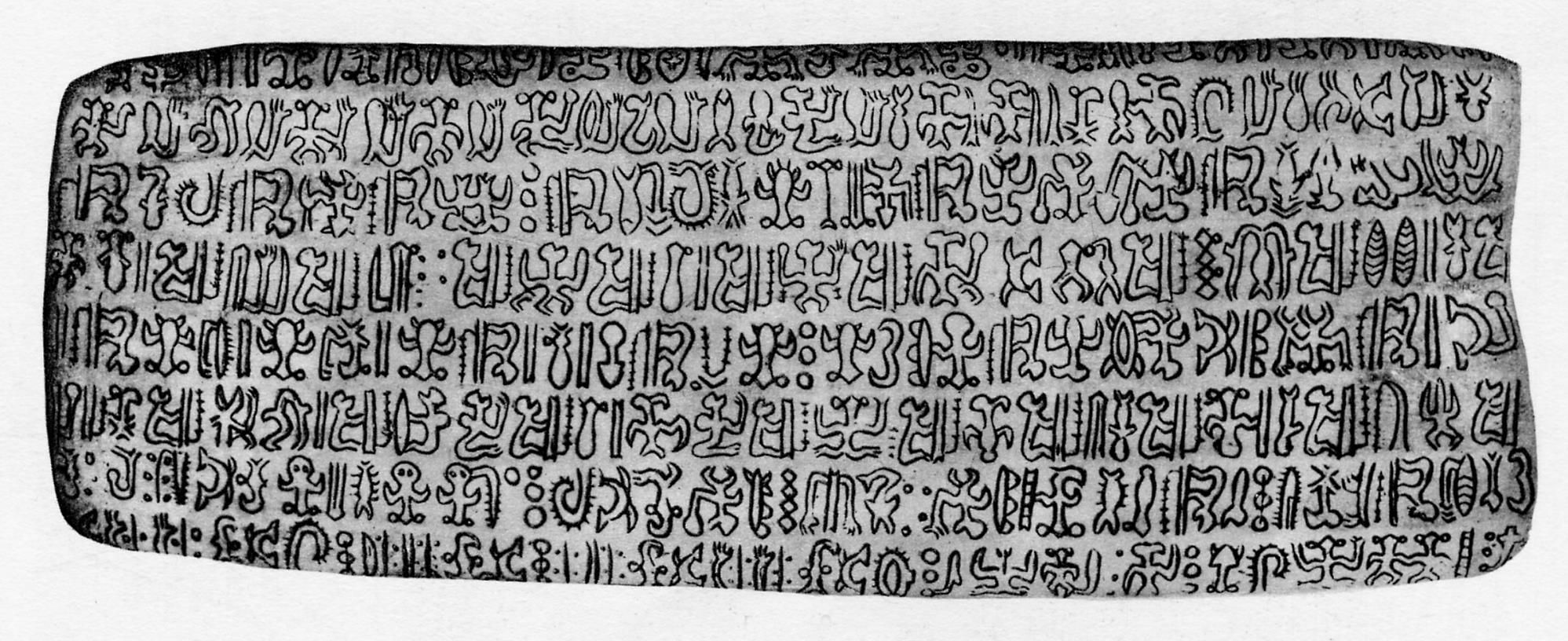
One inconvenience which tells me "not so fast" is that even though koalas live at the coast of Australia looking at the Easter Island, they don't seem to live on the Easter Island, but Eucalyptus do. So my guess is koalas of Easter Island were exterminated (they almost exterminated them in Australia too at some point) but then I read that eucalyptus are planted on Easter Island, as if they're ingenious to Australia and not Easter Island, but because I read of them as of the most rampant tree of the island, I have some doubts about them all being planted, people mostly suck at planting trees. But then if the Island was deserted from the trees, it would explain the extinction of koalas. But then the tablets are wooden. It is the newest subject to me, as you can see I know next to nothing about it, it's something to be explored by somebody who knows the region better.
But then this example containing both signs with and without tree makes me question my hypothesis about them being the same sign. But then of course we ourself may write the same symbol differently in the same text, like a and a.

and btw this is the one recognized to be something astrological, but I have no idea how they understood it (probably by the abundance of crescents) or if it is true at all.
And then when I wanted to show a tablet where that koala looks just very much like koala, to my surprise that site tells about Maori cutting those tablets and that it is a replica of some one. But I cannot help but suspect that those cutters know how to read them and that there are some crazy freaky theories about them in the region, not recognized by academia and thus concealed, but it is nothing more than a suspiction yet. I am just like what were the chances that koala lived not in china, as I actually thought, but much closer to the Easter Island. And that now I found some maori stuff when I was looking for it..
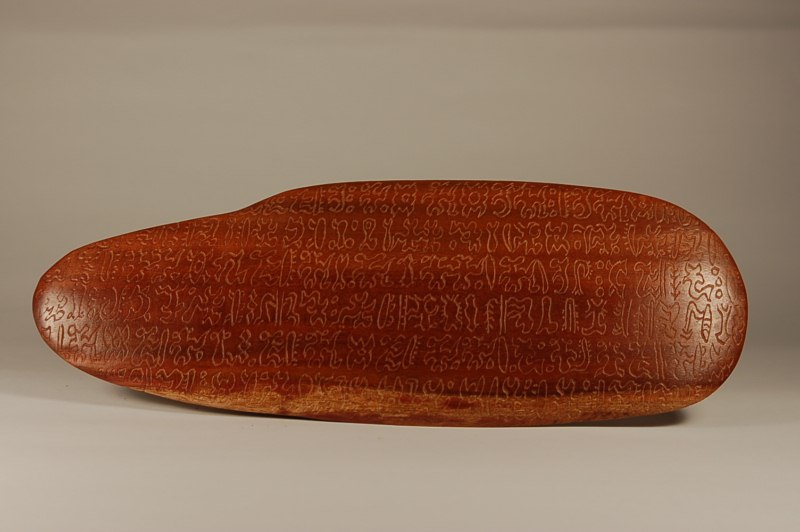
but then maybe it's because there's no known writing system in Australia and New Zealand, so maybe they took this thing to make replicas because it is considered regional, anyway, from this night those signs are koalas to me. And maybe when we identify the other animals, we'll be able to speculate about the other signs. But to do that we have to know the languages of the region (maybe maori too, we need an ai speaking all the languages to do the job)
Some more of random stuff to demonstrate how based biotech is:
Line 93-180: This is a very long section which describes the phenotypic evidence for both B and T memory. I suggest to divide this section into parts, one on B cells and one on T cells to improve readability. A meaningful separation could be done at line 138.
Response: This section has been divided into two at the indicated location. The section headers now read: “Phenotype of Allergen-Specific Memory B Cells,” and “Phenotype of Allergen-Specific Memory T Cells”.
and I have heard this B and T memory cells from a female scientist of african descent, maybe to troll my racism. Most of whites are more retarded than she is. 20% of blacks are smarter than half of whites.
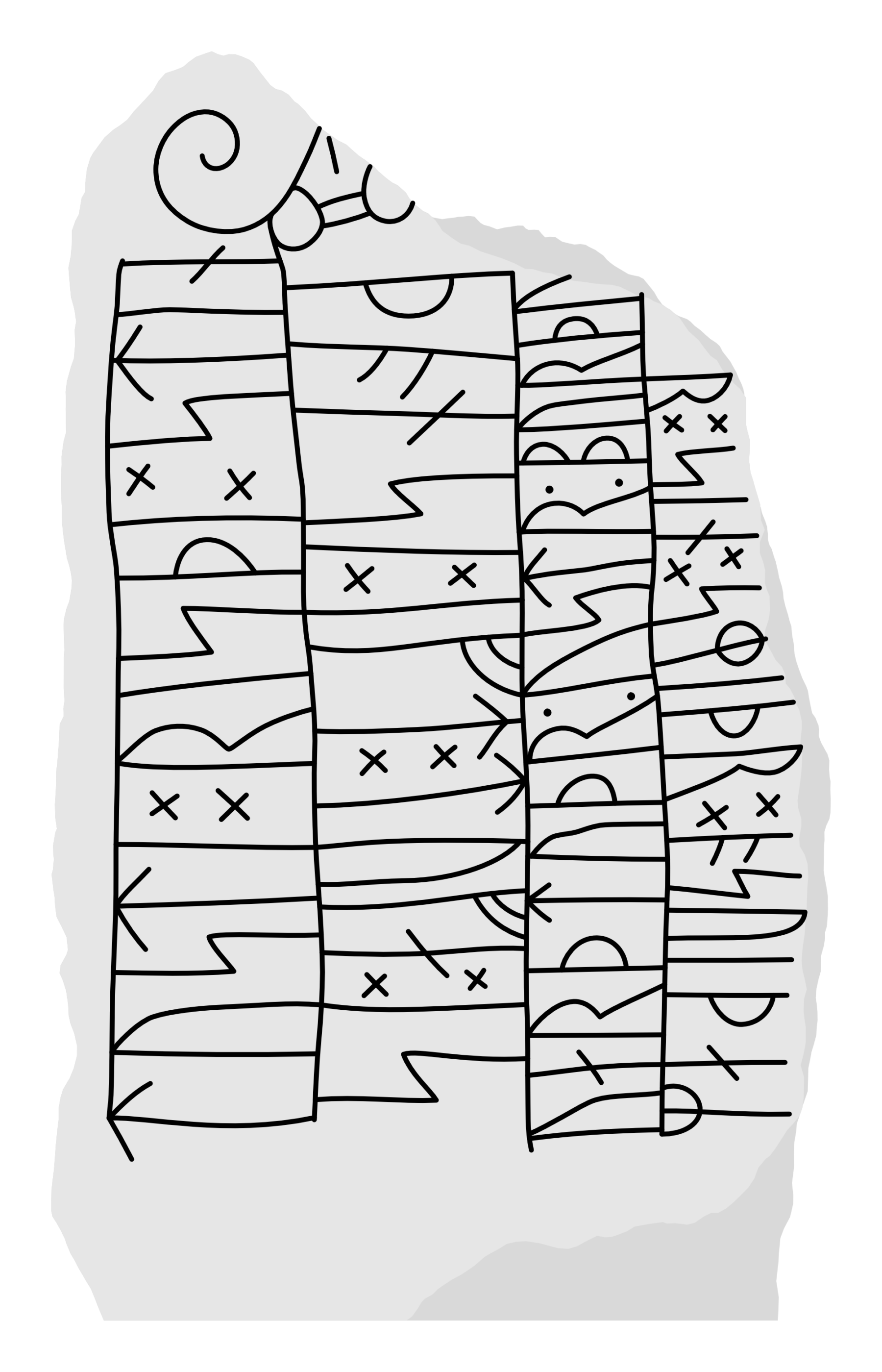
Runestone DR 108
| Ringerike style, Runestone style B-e-v, Viking
The carvings of the stone are in the runestone style B-e-v (c. 1010-1050) pertaining to the Ringerike style and contemporary with Pr 1 and Pr 2.
The inscription is not signed.
The granite stone is c. 1,98 m tall, 1,25 m wide and 0,40 cm thick.
Runic inscription
The rune text is written using boustrophedon and begins at the bottom left corner.
Runes: ᛏᚢᛋᛏᛁ ᛬ ᚱᛁᛋᚦᛁ ᛬ ᛋᛏᛁᚾ ¶ ᚦᚭᚾᛋᛁ ᛬ ᛁᚠᛏ ᛬ ᛏᚢᚠᛅ ᛬ ᛁᛋ ¶ ᚢᛅᚱᚦ (᛬) ᛏᚢᚦᚱ ᛬ ᚢᛋᛏᚱ ᛬ ᛒᚢᚱᚦᚢ¶ᚱ ᛬ ᛋᛁᚾ ᛬ ᛋᛘᛁᚦᚱ ᛬ ᚭᛋᚢᛁᚦᛅᛦ
Transliteration: tusti ¤ risþi ¤ stin ¶ þonsi ¤ ift ¤ tufa ¤ is ¶ uarþ (:) tuþr : ustr : burþu¶r ¤ sin ¤ smiþr ¤ osuiþaʀ
Old Norse: Tosti resþi sten þænsi æft Tofa, æs warþ døþr østr, broþur sin, smiþr AswiþaR.
English: Tosti, Ásviðr’s smith, raised this stone in memory of Tófi, his brother, who died in the east.
———
Kolind, Djursland, Denmark

It is interesting how norsk runes and rongorongo are the only two writing systems I know of that use reverse boustrophedon. And to my surprise the word rongorongo reminds the word rune.

It's funny how these heads stick out pretty much the way runic stones do, but then runic stones probably don't go as deep as these statues do.
coach [kowtʃ]
couch [kawtʃ]
'twill is a poetic (old) form of it will.
twill is a fabric
lustrous is glaour and I wonder if it relates to lust
but then I just got drifted into actual reading of runic stones, because some mighty resource for it have I found (click the image to find more texts, I wish they add all the images missing so far)
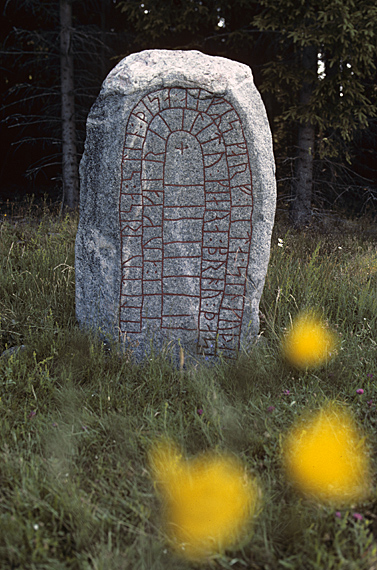
Bankekinds hd - Askeby sn - Lilla Greby
Runes written on runsten, grå gnejsgranit. Date: V
...--- ᛬ ᛅᚢᚴ ᚴᛅᛁᚱ--- ᛚᛁᛏᚢ ᛬ ᚴᛁᛅᚱᛅ ᛬ ᛒᚱᚬᚢ ᛬ ᚦᛅᛋᛁ ... ...-- ᛚᛁᛏᚢ ᚱᛁᛋᛅ ᛋᛏᛁᚾ ᛬ ᚦᛁᛋᛅ ᛬ ᛅᛁᚡᛦ ᛋ᛬ᚴᛅᚱ/ᛋ᛬ᚴᛅᚱᚡ| |ᚡ-ᛁᛏᛅ ᛬ ᛋᛁᚾ ᚴᚢᚦᛅᚾ
...--- : auk kair--- litu : kiara : brou : þasi ... ...-- litu risa stin : þisa : aifR s:kar/s:karf| |f-ita : sin kuþan
... ok "GæiR... letu giæra bro þasi ... ... letu ræisa stæin þennsa æftiR "Skær/"Skarf, f[r]ænda sinn goðan.
... and Geir- had this bridge made ... ... had this stone raised in memory of Sker/Skarfr, their good kinsman.
(apparently the text begins in the inner line)
This tradition actually explains why would they use the reverse boustrophedon. And there are plenty of runic writings going like this:

Hanekinds hd - Kaga sn - Gillberga
Runes written on runsten. Date: V
᛬ ᚱᚢᚦᚱ ᛬ ᚱᛁᛋᛏᛁ ᛬ ᛋᛏᛁᚾ ᛬ ᚦᛁᚾᛋᛁ ᛬ ᛁᚡᛏᛁᛦ ᛬ ᛏᚢᚴ- ᛬ ᛒᚱᚢᚦᚢᚱ ᛬ ᛋᛁᚾ ᛬ ᛋᛅᛦ ᛬ ᚢᛅᚱᚦ ᛬ ᛏᚱᛒᛁᚾ ᛬ ᛅ ᛬ ᛁᛚᛅᛏᛁ ᛬ ᛏᚱᛁᛦ ᛬ ᛅᚱᚦᛅ ᛬ ᚴᚢᚦᚱ ᛬
: ruþr : risti : stin : þinsi : iftiR : tuk- : bruþur : sin : saR : uarþ : trbin : a : ilati : triR : arþa : kuþr :
"Rauðr ræisti stæin þennsi æftiR "Tok[a], broður sinn, saR varð drepinn a "Ænglandi, drængR harða goðr.
Rauðr raised this stone in memory of Tóki, his brother, a very good valiant man, who was killed in England.
I wonder why did they break the text in the middle of the word ᛏᚱᛁᛦ (I suggest it's trick, not triR, but then how dare I, I don't even know norwegian not to mention old norsk)
Which is probably a reducted "what is"
Warlock of the 88 tells that reversing the true forgotten name of G.o.d. can destroy the universe spelling it in reverse, yet the warlock himself tells The uncreation? Only the daft believe such a thing. But though that movie is pure magic, it impressed me a lot around year 1988 (old english, latin, name of god, it definitely could influence me) but then it's a metaphor or a fairy tale. It teaches to not be mean, because if he didn't curse that girl for no reason, she wouldn't help the hunter and he would not be able to stop him, and this is how karma works (even if it seems as if it doesn't work just because it only saws seed of further failure, not every seed raises as supposed, so yes it only works from time to time, here or there, on this or that level, be a good boy, saw some good seeds, seeds of future success,
And why I brought it here is that if we read AEIOU in reverse we may find why as the beginning of the spell. IEOUA in reverse is AUOEI which is similar to away. AEIOU in reverse (the truer name, the one bogomily chanted gave me why as the first initiation, why is it could be that uoi e a. Questioning reality may lead to dismantling it.
Actually I figured out that there is a very limited ammount of wrunic writings so I can collect them all, read them all with those bilinguas, I think I must copypaste these two to the others: runic stones
I told you how I dislike words with ass and so I'm not nationalist, but nazist. I am not a professional, but a prophecy maker, a professor. But no, sor is not too far from ass and shit. the same s, I guess.
so I was going to ask.. is R the Р the koala (or in our longtitutes and latitutes (I wanted to write altitute, had to chech the dictionary) it could be a bear. Even if they're not very much related (they say bear is further from koala than from us) they sound very alike, both could be the origins of the R sound. Genetic proximity doesn't matter much if we place them into the same group of tree-climbers and teddy bears look more like koalas than even bear cubs. Bear could be Big aR. But then why is koala named so, let's figure out what are the names for koala in the region and look around thowe who have onomatopoaetic ones.
Another name for koala is koala bear.
The word koala comes from the Dharug gula, meaning no water. Although the vowel 'u' was originally written in the English orthography as "oo" (in spellings such as coola or koolah — two syllables), later became "oa" and is now pronounced in three syllables, possibly in error.[4]
Adopted by white settlers, "koala" became one of several hundred Aboriginal loan words in Australian English, where it was also commonly referred to as "native bear",[5] later "koala bear", for its supposed resemblance to a bear.[6] It is also one of several Aboriginal words that made it into International English, alongside e.g. "didgeridoo" and "kangaroo."[6] The generic name, Phascolarctos, is derived from the Greek words phaskolos "pouch" and arktos "bear". The specific name, cinereus, is Latin for "ash coloured".[7]
Does cross as protective symbol come from scarecrows? scare cross!
Another element of B being the first letter: The word Bible begins with it. And in italian it's Bibbia.
And maybe it relates to those ווו, and maybe they are ббб: биббия
I have just figured out that Sefer Yetzirah is crap. Jewish mysticism is mysticism of slaves. What could they know. Just like sefer yetzirah is often self-contradictory (it attributes different elements to the same letters here and there, but then it could be another level of encoding.
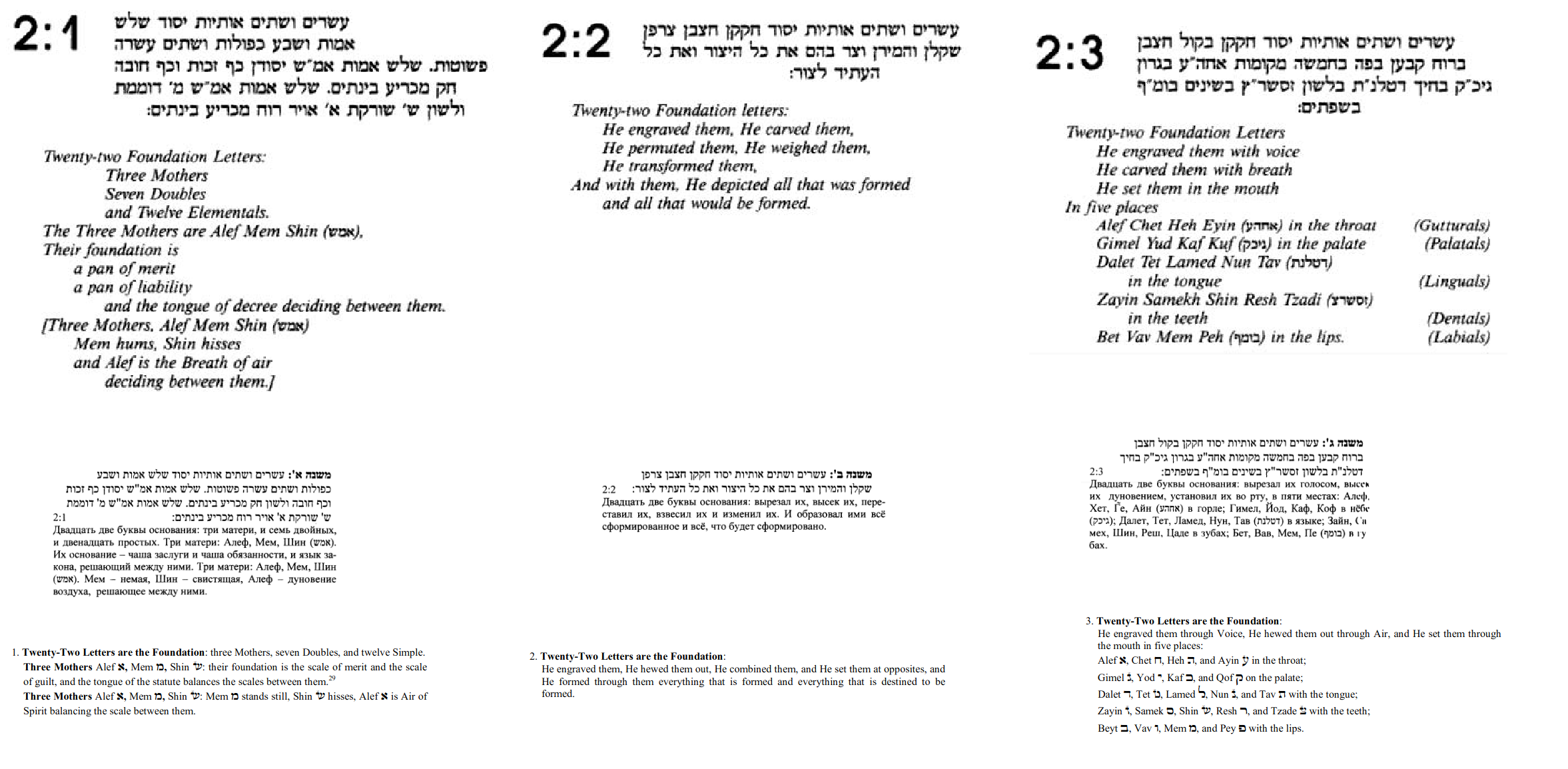
It seems they were universal when they spoke of three mothers and maybe even correctly named them,
and that Ге of russian translation is probably where I took the idea that ה is voiced. But it's vowel, thus russian hebraistic is closer to the truth.
So whoever wrote that book of formation didn't know the structure I am describing, or else he woudn't group letters like that.
But they used the word linguals, justifying my use of it. And yet they don't recognize that other letters grow out of those mothers and thus all those dentals and palatals (as a part of what they call gutturals) are also linguals. But then I notice that what they call gutturals are vowels, at least three out of four are. And because greeks recognize the analogue of ח the Η vowel (do they recognize it as such because of that book? nah, it's rather that book took after the greek chochmah hohma)
But there are several versions of the book, and thus there are several versions of this piece:
Rotating round one's axis matters in the sense of one's face appearing from the right when rotation is clockwise of from the left when it's counter-clockwise, and maybe then person appears(!) to be good or bad because of belief of right side being angelic and left side being demonic, which could be culturally or physiologically determined.
rorating and rotting.. why are these words so similar?
норны.. корны..
Wash it away wash it today.
Right away, right today
2:3 of sefer yetzirah is denied by this my book. My book is anti-sefer-yetzirah. Or rather it is correcting sefer yetzirah by cutting of the even chapters or some other code encyphring the text. So I saw this short version of the 2:3 and I thought of those five places in the mouth as of five vowels, maybe they just didn't have the term, vowels, when they
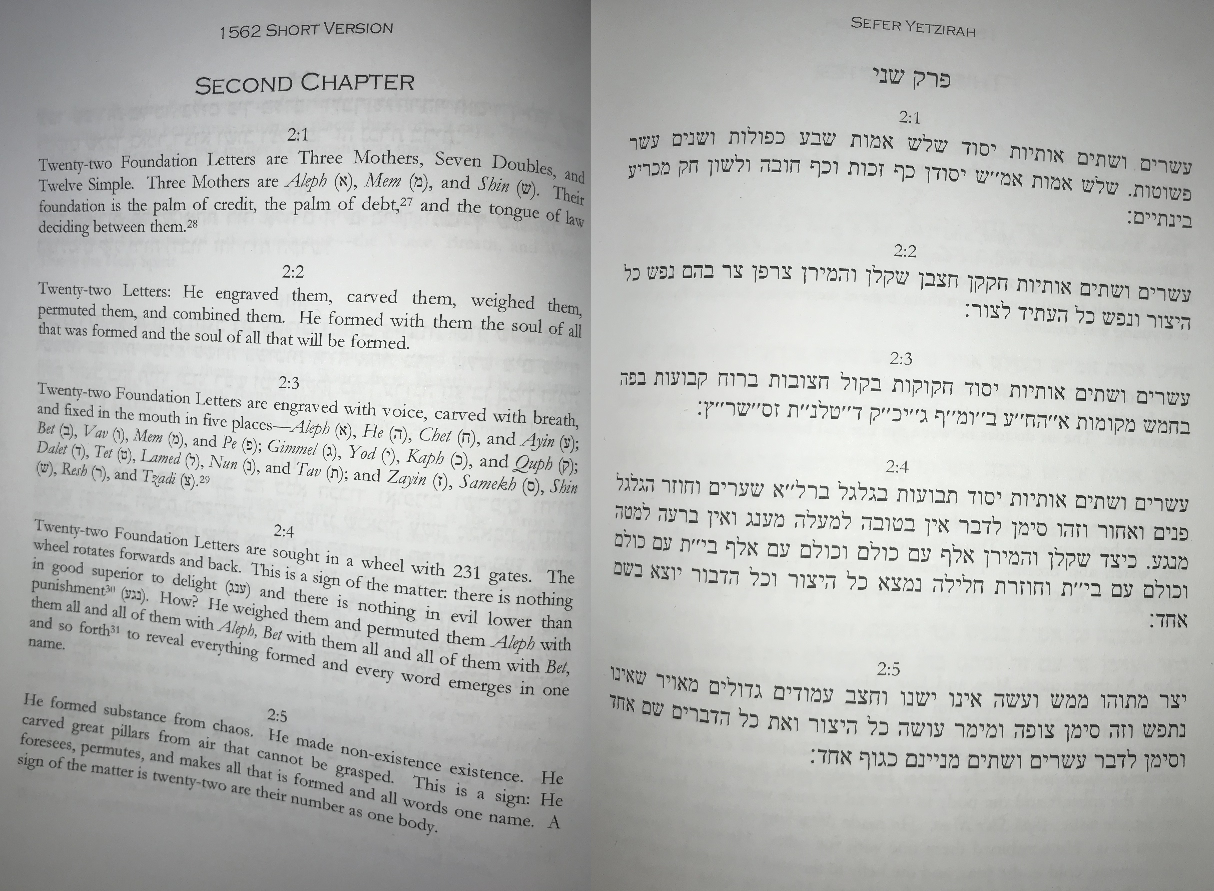
credit, debt and flame of law between them. The flame is fire, thus the palms are land and water (air and water are to make money out of thin air, it used to be land berfore they lost their land and began to subverse the nations, earning on some unworthy schemes. This book is so antisemitic, but then nope, I only recognize their crimes, I do not call for slaughter, I demand the therapy and I want peaceful resolutions and for regular criminals too.
in 2:3 of this version (probably the initial version, others were only editions, clarifications, and thus further from the source, but then I'm yet to research them properly) they combine letters and make it in the order of A B C D and the first group is their innovation, my guess is it combines the additional (newer) letters. And there did they misplace ח and י? But then they maybe did not, maybe vowel ח explains the positions of ט.. and מ? but then they place both ט and ל among coronals. And this is what they're pronounced like today. ט, not Θ, but if ח is vowel, it explains the labiability of Θ, but what if that is ☉.. soleil, helios, no f-words. Is it fornication? fucking? Ѳ the vulva?
Did they think that sun gave the birth to the land? If it's true that earth was a he in Egypt?
Their labial are all in the same group, but then they name this group exactly that in the versions I posted before. But then they arrange thosse groups differently. In the asiatic canon.
And in 2:4 they speak of the dharma-like 231 gates, which maybe tells that letters are reflecting each other as runes reflect themselves when their are normal or upside down. Thus 22 could tell of 11 runes, but then B reflects T, like birth and death, because B is the first letter, and A is vowel, something else, and so they say there that it goes like ba ga da.. ta, ab ag ad.. at. The group I recognize as vowels are first in all versions, which makes me think that they're separated "five places" they could be the five places they mention. But they mention only four vowels, probably because hebrew alphabet has only four lines. But then they name H instead of I, which could be Attic influence. Here I dare to say that H should be with K, because it's nothing more than fricative K, the place is the same, unlike with I, or י if you wish. And י belongs with vowels.
So thick ~ So big
so thin ~ so tiny
עשרים ושתים
ашРим ашТим
эсрим уштайн
and in the lighter font is how I read it, and I am ashamed of how wrongly did I read it.
And suddenly I realize that how dared I make up hebrew azbuka not being able to read it. This is how Lenin was not understood in London after he learned the language by books. But then did he even speak english? Then theyre would be many recordings, but then I read hebrew so wrongly, I am a sloppy worker.
Повторенье мать учения. Только если делаешь домашнее задание имеет смысл (я не делал домашнее задание занимаяь ивритом, и вот результат, кроме письменности ничего не освоил. Письменность мне была интересна.
But there's more to this:
> So, what mnemonic techniques do you use to remember scientific equations?
using the formula twenty times. like writing your letters. you remeber how to spell a word once you write it twenty times.
Dying is laying down. downing?
лёг лягает (лежащее животное лягается, by legs, legs. Legs is both verb and noun.
Twenty-two Foundation Letters are Three Mothers, Seven Doubles, and Twelve Simple.
Doubles are like Daughters (even)
Simples are like Sons (odd)
One father and three mothers, and plenty of kids isn't it a structure of archaic family?
Soviet toponyms are fucked up: трубный (посёлок трубопрокатного завода) sounds just as трупный (трупный запах, трупный яд)
acdc ~ эй силди себе
A friend told me that ъ uas a form of o and ь was a form of e, as if in this aspect they had only two vowel letters o and e, which would be alike of a and i. But then I notice that i in cursive often looks like e with a dot and a looks like ъ with a belly reversed, and then e is an upside down a, they're all shapes of the same form, as if it was an abugida. And I suspect ethiopean abugida to be the roots of ours. Because it has alphabetic order and because it is geographically not that far away.
б coursive looks like ъ reversed left to right, because in actual cursive and not just italic font, that stick exits the bubble at the same corner it exits d, and then makes a swash to go the way that б goes.
as if a b were invariants, or was a a variant of б?
but then I see that it couldn't be, because a is 1 and b is 2. But how do I know it always was this way. I don't and it's possible that b would be the first number and it would be 2.
2 3 4
5 6 7
8 9 X?
And this appreach didn't bring me much, so let's neglet this hypothesis. Then it will keep on not delivering me, so fuck it, look where it does:
door is through in dutch, as if door is not the wooden panel, but the hole in the wall, as if door is дырa
door is through, is it true? no, it's of tear, torn, дыра разодрана (др in разодрана is дыра)
I had sorta revelation that abcd used to be a b s t, but now I don't know where it came for or what did it mean.
It seems to me that before it I realized that velars and coronals got split into space (s or c or k, standing for stone or камень) and t standing for time (temps)
But what was the words in which I found it evading me (acturally between the two previous sentences few hours passed before I recalled the second one, this is why I feel like writing it all down, because the idas so large they don't fit my operative memory until I get used to them somehow. So I brought that half-grasped idea in hope of the third part will join it
runes (and hebrew letters) preserved their meanings.
If ᛁ is ice, it makes perfect sense only if it's horizontal, because frozen water often gives perfectly smooth surface like nothing else. No ripples, And in such way ᚦ looks like Д but that's about it. I cannot see any other interesting shape, other than maybe ᛏ looks like ᚜ the closing wedge of ogham.
отчество наверное всё же от отец, потому что землячество не от земля, но от земляк
пророчество от пророк
творчество от творец (или от творя? тогда не отец но отя? батя~атя?
естество от есть (что есть то есть)
могущество от могуч (и с того? из того)
is orthography placing г instead of в to cloud this or similar etymology? don't look for vilains where fools are in charge.
ᛁ and ᚦ making sense when rotated counter-clockwise (naturally they were rotated clockwis "for luck", So wouldn't it be unlucky to rotate it right back to left?
But what I came to add here is if all we need is the third one, the labial, and other than staveless ᛒ being M (it's a good one too, staveless Д is Л then.
But first I saw that M (ᛘ) looking like ᚛ the beginning of the ogham line. As if ᛘ was the origin. Y-like it would be if ogham was vertical (and because most runestones start going vertically, stacking one on the other, going upwards. I think I heard somebody else went upwards. Were they mongols? I don't remember? Egyptians in some period? I don't remember. Orhon runes I think they were, I need more specialists, I need to build up an university. But it's an administrative task, I havwe to delegate it to whoever is capable of social interactions.
лёд как синоним гладкости тогда должен быть закреплён в языке, и есть устойчивое словосочетание "гладкий как каток"
physically calculate? what is it I don't know
I imagine things in my head, so I don't really need plans figures draughts
Did jews invent math to measure to be correct or adequate what they couldn't imagine to be true.
But their figures do not measure some other stuff, such as звонкость металлических конструкций, о которой я не знал до того как начал использовать элементы из чистого железа размерами больше чем крючок торчащий из стены.
уважение к ножу подразумевает что уважать от слова видеть, привечать, привет от слова видеть
примечать tells that в~м
отмечать~отвечать
ответ~отмет (пометка на странице)
bitch and dick are so female and male in both b~d and tch~ck
(my friend tortured me with offspring yesterday, and look at this, an offspring of that night is alright)
майнить money
(залезая в капсулу виртуальной реальности, где человек работает, на дому но скрывшись от домашних, потому что когда я жил с женщиной, с постоянно находящимся рядом человеком невозможно работать.
нытно~нудно нудный ноет
(and this y being both uRU and iEN, while u is being iRU and uEN make me believe that some ю used to be the only inclination of a, further becoming different in different nations. y=ij which is ii and reminds 𓏭 used as plural suffix, and standing for very similar to y 𓇌

the smoothness of these shapes is achieved by this complexation of the border of the shape:
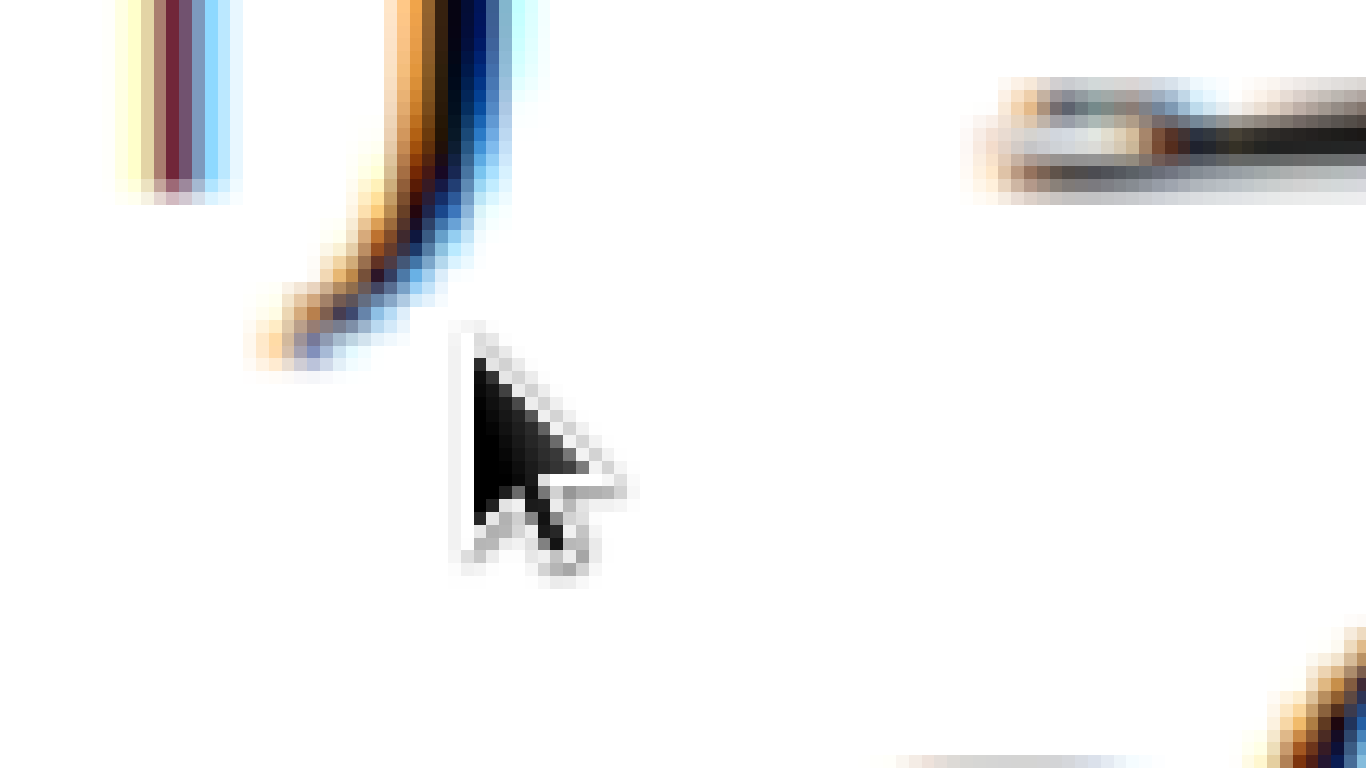
and to my surprise my eyes see ligher borders between blue pixels and darker border between the yellowish ones, while I don't think they have such borders, that straight line at the bottom of the zoom has no borders, it's my poor eyes double the image so the illusion of borderlines appear.
cursor has appeared here by accident, but it's arrow shows a earlier attempt of smoothing the elements.
нудно ныть need (нужно)
ну дай, ну пожалуйста, ну настаивает (понукает? нно!! в противовес к тпру (and that very tpru could be the o-line's variant of stop. all four are of o-line, as if they're in circle of opst
is start "закончи начни и закончи?" is alphabet an instrument of creating abstract concepts?
here, it seems to me I'm closer to the language of origin of the writing system:

But then I'm yet to see it in runes, but then I'm not sure the original text in runes even exists anymore.
Or ever existed, considering that some scandinavian provinces resisted christian rule until the XIXAD
兄さん
google reads 兄 as ani, but it reads 兄さん as nisan. Is it because respectful o- is spelled as a in that furigana and stands instead of respectful san?
Cảm ơn is thank you in vietnamese Sin kamon (the misspelling is mine) is thank you very much, сильно come on (cum on. to come in is to come, in a sexual sense, why else would you come to somebody else's hole, imagine how we lived before civilization invented homes, like beasts in ) and it doesn't really matters if these words are cognates of not (of is dutch or) because either way they have
Google's masterpiece still makes some retarded mistakes mistaking спел for спал. Why not слеп then? Because слеп would have to have two typos. And this fuckup tells me that sleep and слеп are cognates. Is spell too? is spell too? Is s Шы Is спел too?
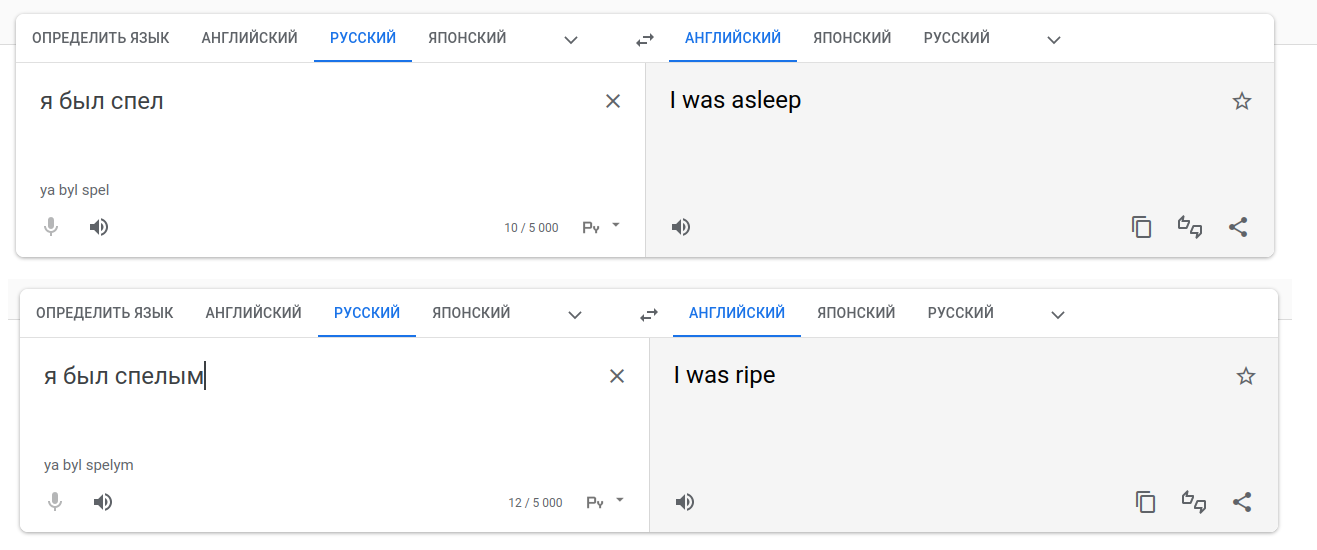
Мама стала Бабой, и словно бы переместилась на верхний ярус алфавита оттого.
Какая третья губная составляет ряд из губных с этими двумя матерями? Filia!
How dare I use the words from different languages? Because I don't know what labnguage it was invented in. My guess is it was something related to these two.
hitler ~ hither
наблатыкался ~ набрался
блять ~ брать? (болезнь берёт? убирает? болеет бреет? не, бред)
Aethiopica reminds AAfrica a lot.
Suddenly I realized why ukrainian seems to be so funny: they use i where russians use o, thus they smile more: мост~мiст, большой~бiльшiй большой~великий, больший~бiльший, etc.
some different (yet also traditional) way to write ᛆᚿᚮᛆᚿᛆ:
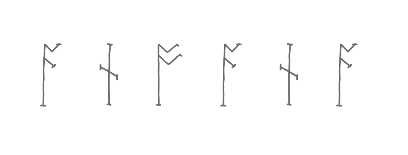
I found it interesting that ᚮ is also one stroke larger than ᛆ, as if ᚨ is some form of ᛁ (but probably not)
and then they made me think: have I used ᚾ for ᛂ by mistake all this time? It is kinda embarrassing.
But then ᚽ and ᛂ are different letters, so let's not get embarrassed, but recognize that this subject is one of the most complicated things I've to deal with, those runes are probably from different sets, and they're all mixed up not less than eskimo writings, so let's take it easy and study it some more.
Russia is Asia with A pronounced by throat singing. Is it the A we all known and was it placed at the front as the most sacred after europeans found it? I can imagine it would sound more sacred than our european vowels. A is the most natural vowel, what am I talking about? O is the most obvious vowel. A is Å? I want to believe it, because of what I guessed at the beginning of this paragraph.
Europe and Asia are the same continent. Russia is next to Eurasia. Eurussia. EU are East West.
or was it A for Austria and E for Englaand? and V for Юг, or was it Vestris. What country was Vestria? It would have some other suffix. Walse? W-Island? W-isle!
Ireland sound as re is s with e sounding close to a, and it looks close to a and is ə
Шва (от ивр. שְׁוָא [ʃˈva] — ничто) — гласный звук среднего ряда среднего подъёма («нейтральный»).
The term schwa was introduced by German linguists in the 19th century from the Hebrew shva (שְׁוָא IPA: [ʃva], classical pronunciation: shəwāʼ [ʃəˑwɒːʔ][dubious – discuss]), the name of the niqqud sign used to indicate the phoneme. It was first used in English texts in the early 1890s.[3][4]
The symbol ⟨ə⟩ was used first by Johann Andreas Schmeller for the reduced vowel at the end of the German language term Gabe. Alexander John Ellis, in his Palaeotype alphabet, used it for the similar English sound in but /bʌt/. The symbol is an ⟨e⟩ rotated by 180 degrees. A subscript small schwa (in Unicode as U+2094 ₔ LATIN SUBSCRIPT SMALL LETTER SCHWA) is used in phonetic transcription of Indo-European languages.[5]
Iſ hebrew and russian related? We definitely are:
ſ is f and s in one: tongue laying on the lower lip and not touching the upper lip in the centre, only
Ш is to Σ as d is to Д but Д is to D. the shape mattered! Orientation didn't exist, because why would the same sign be standing for different things. If anything, it would be a disadvantage, so evolution would eventually unify all the shapes if by some accident there would be any ambiguity.
Until lines were invented maybe. then b d p q would differentiate, all being consonants and plosives. So were they plosive male and fricative female? because b & d & q are dick,
b & p are banana & pisya? balls and penis? beпis (бибка was the first soft porn I saw. gosh it was disgusting)
f t s l?
f t ſ l?
f t z ?? (t is also z? the same swastica, the lower part of it)
j? but if t is fricative, it is s, then t/z ~ p/b
but s is ſ. f/ſ ~ p/q, thush t without dash is l and fricative l is n.
f ſ z n
F S Z N
And because F is open P,
S is open g? Then g is C, which it historically is (C was voiced, as it is in greek and russian and many others) both are lingual only one is fricative and the other is polsive, or rather C is plosive and S is firacatinge, plesives are most essential. Maybe except M.
N was J? (recollection of what was said about the n-rune used as e-rune by me (and thus I added to the chaos not ever wanting it. So let's use hanlon's razor and make myself less paranoid and less offensive) made me think of runes and here is what I thought in the context of the previous paragraph)
ᚴ is plosive, ᚿ is fricative. Up is male, Down is female.
Is it whay ᛆ is upwards in the Bornholm's azbuka?
ᚮ is the only thing good enough to play the opposite, but then N coulg be.
A ~ Д (да)
N ~ Н (нет)
N as end
K as konets
Z as zain
K N Z (канец)
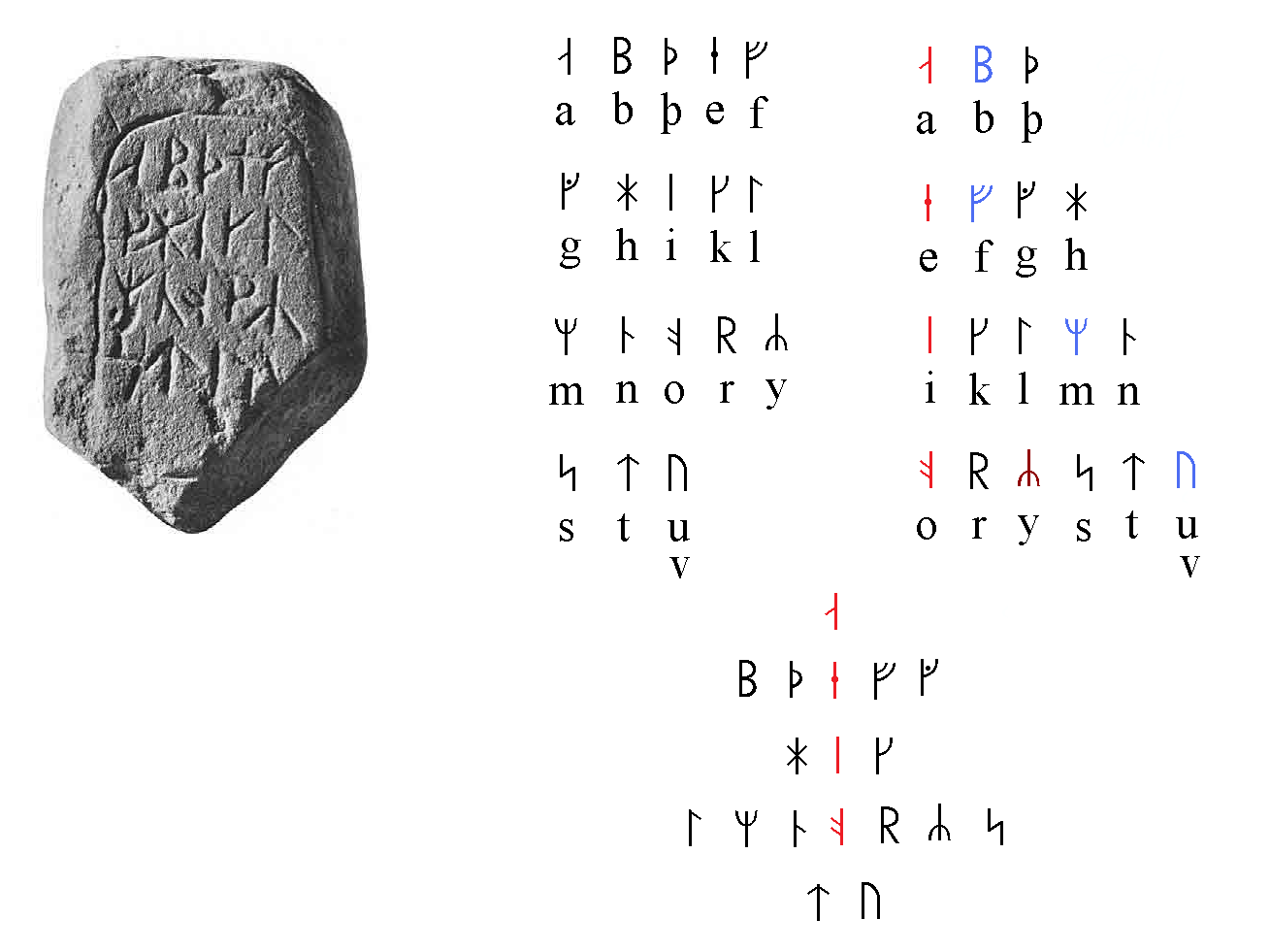
And I for the first time saw it as
ᛆᛒᚦ
ᛂᚠᚵᚼ
ᛁᚴᛚᛘᚿ
ᚮᚱᛦᛋᛏᚢ
And since ᛂ is a dotted ᛁ and ᚵ is dotted ᚴ, I'm surprised that it's e dotted i, because earlier I theorized that i is dotted e. Probably i and e were the same thing divided phonologically in different dialects.
ᛂ(if E, or ᚽ if H the ᚼ)
ᚼ(if H, or ᛡ if J)
ᛘ(if M, or ᛉ if Z)
ᛦ(if R, or ᛣ if Q)
Before I was looking at that ᛂ I saw Dalakrean Runes, the never ending tradition, and here somebody compared it to others:
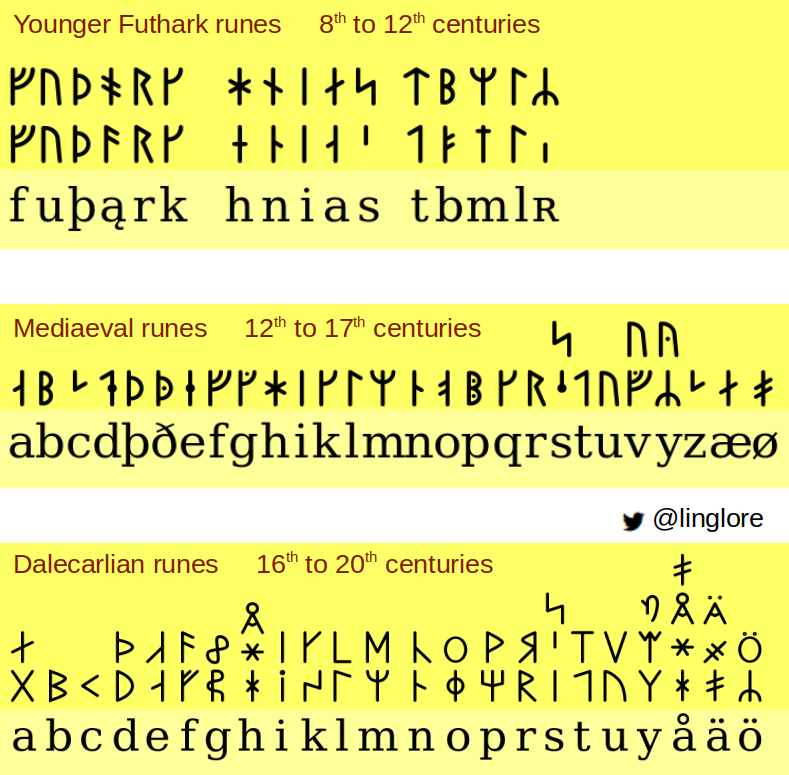

Here I see herv in both g and h
p ~ m
k ~ S (both C)
t and l reflect each other
? e k n
y e k n ? the ekn and some hidden fourth make up the quadrant not this directly obvious in other runic fonts.
å and h are bioth Å
ä being Ä is also of that thing and indicates that maybe christians brought these shapes, but then they had their own ones, and notice how å and h share ALL the symbols. Except ᚯ standing for both Å and Ä
ᛄ standing for o, just as it's staveless variant looking exactly as o, but not ᛜ, which is recognized as ŋ, but then o is next to n, so who knows, who knows, maybe we do in the future. Maybe we already know that it's ᛟ. Either way, let's dig in..


Whatever they say in their comment, I can see the first seven symbols of futhark repeating again and again:
ᚠᚢᚦᚨᚱᚲᚷ (the way it's given in wiki today)
(ᚲ is ᚴ is ᚳ) and (ᚷ is a stavwelessvariant of ᚼ, but then ᚷ is recognized as g, not h, then g~h, just as both are transliterated as Г (the c) into russian: Hitler & Giger are Гитлер & Гигер)

That brave claim of mine that those are so called futhark runes (and actually there's another claim, that those runes are АВДЕFGH) kinda contradicts the knife looking upwards, when modern people would draw it razor down, but then maybe they cut throats not butter with it, so it was upwards. And a baloon is not the way we would draw it, but they didn't have helium baloons, their baloons (and ribbons) would wave downstairs. And the tree is upside down, but maybe it's some hemp being dried then. Let's compare it to the date it is told to dry it, october seems to be nice, but I don't know which line is what month. But the crosses, the crosses are upside down. Could that be heathen fuck you to the authorities, and they would claim that they held the calendars upsided down, when in reality they did not.
So that new point of view of vowels looking differently, in the structure I saw before, even when I placed N instead of И(spravjdi E) by mistake. The sequence of ᛆᛁᚮ, 102, let's look at them again in this light:
ᛆᛒᚦ
ᛂᚠᚵᚼ
ᛁᚴᛚᛘᚿ
ᚮᚱᛦᛋᛏᚢ
And the
ᛂᚠᚵᚼ
ᛁᚴᛚᛘᚿ
part makes me think: is ᚠ dotted ᛘ? Some invariant with both branches at the same side? Weird. Duje weird.

From the preview I thought it was cannabis, but at closer look I see it's vine. Could vine be mistaken for cannabis? But then some specific specie of vine is Morning Glory.
Checking ukrainian word взагалi, I found загалом and then found that гал is fire in mongolian. Which is not related to these words, but can be related to гори. пали. пылай
Взагалi probably has "whole" in its "гал" (and so once again Ukrainian is the bridge between Russia and Europe. But what is the russian cognate of that загалом?) and imagine my surprise when I realized that взагали is вцелом, thus гал ~ цель ~ goal (especially this goal thing freaked me out in a good way) whole ~ вцелом? or is w flips the h to make it ч the ц, as I used to think about initial w for some reason some decades ago? is goal~hole? as in golf, for example, or in pool the billiard?

You are listening to 'Asja'
Taken from the album 'Drif'
as this example shows, ᛄ could be ᛂ, й, and so on, it's a complicated topic I have only began scratching the surface of, even though my scratches do dig deep. DDD деньги, дети, друзья
дунувши решил ответить на речугу Акунина про то, что люстрация это плохо (сам-то он говорит, что раз уж живёшь там, то хотя бы сам в этом го-е не участ вуй, но поскольку он хачежид, он лукавый шо пиздец, приложил его собаку, но с уважением, приколись, это вполне себе политическая программа, быть может кто-то там в коммент секции её подхватит и не практике осуществит. Я хоть и накурился, акт гражданской дипломатии совершил)

украинский это мост между русским и европейскими: I'm sorry = мне соромно = мне срамно. Взагали = вцелом (in whole, goal~цель~целый)
С была когда-то звонкой, потому и Г стоит там где C в латинском, которая как Ц иногда произносится (но этимологичны эти соответствия или всего лишь поэтичны, они мнемоничны)
In german V[f] W[v]
di as du (diploid)
unus duo
(suffixes us and um in latin are both probably un as in unus. um is a good un the one, but why us is us? is it masculine form of um? is um female at first and a is plural, but then open syllables are female, and the -a suffix is bioth female and plural, and um is some homosexual neuter. But I think this feature of latin predates Socrates, but Socrates could be only the furthermost iteration of some much deeper movement of pederast, probably going from cannibal predators, from the lowest form of humans, as как у Бунина "русский мужик, как дерево - из него или дубина, или икона" (actually it's Цитата из книги «Окаянные дни» Ивана Бунина — «Есть два типа в народе. ... Народ сам сказал про себя: «Из нас, как из древа, – и дубина, и икона»,
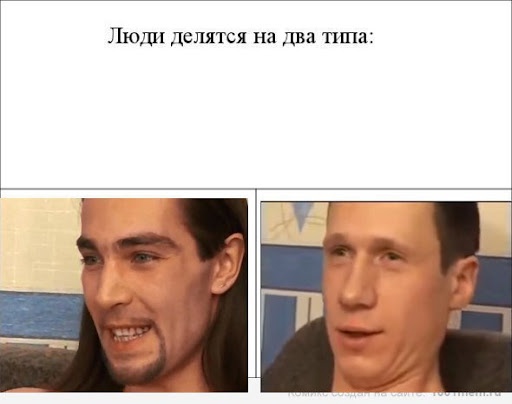
Russian т is т when in cursive, and there's some unity between t & m:
тянИ ~ манИ
утянуть ~ умыкнуть ~ умять ~ уминать (тебе~мне? тепе[tepe] ~ mene?)
Может ~ метит ~ целит (мета=цель. метиться=целиться) (меченый~цельный? gorby was a hit)
(will? whole~goal (целый~целъ~цель))
ᚹ [w] ~ Г? ~ ᛩ [q]
цельный с целью? (не пустой, не бессмысленный)
сатан съ_tan? (с загаром, with tan, чёрные черти, сколь ни насаждай толерантность, сколь мульти ни культи, а язык говорит сам за себя (и за тебя))
Аum
Aumn
Aumin
A M N
A U И
1 V И or A V I ?
A I V is symmetric, but wasn't it further rationalization?
U to the level of M
I to the level of N
The name Arial is primarily a gender-neutral name of Hebrew origin that means Lion Of God. Originally a male name in Hebrew, but often used for females now. The most famous Ariel in pop culture is the mermaid in Disney's "The Little Mermaid."
Hebrew Baby Names Meaning:
In Hebrew Baby Names the meaning of the name Arial is: Sprite; lion of God. A biblical alternate name for Jerusalem. Name of a prankish spirit in Shakespeare's The Tempest.
Welsh Baby Names Meaning:
In Welsh Baby Names the meaning of the name Arial is: Vigorous.
Isn't it the same as Arian? Арийский? A biblical name for Jerusalem, huh?
and the mermaid was Ariel (but I guess it's just a different spelling, a feminine spelling maybe. Ariil would be the male shape, but I don't know gematria to know any better.
с[s] (with) (со- [so])RU = (co- [ko]) EN
o as all vowels is most of the time purely a connector. So unless is's nasal un-, it's nothing.
vwls r rdndnt
с[s] is not only with, but also to, or at least it's to in it's shape. As it's egyptian shape, 𓋴, it's in the shape of folding something: ложить = to put. сложить = to fold. This is how important russian с is.
And I saw that со thing when I thought about zigzag the Z being multif fold, when C the Г is only one, and that is the fundamental difference between сворачиванием и сгибанием (хотя может слова и не отражают этого)
Z is zigzag, of course!
Y is young? Is it a human figure raising hands as in yawning and stretching? I think a better verzion will come as that zigzag thing suddenly revealing itself to me.
X? cross? zigzag, cross are both geometric shapes. Maybe Y is some triskelion, then X is a swastika, And Could they stand for 4 and 3? then Z is 2?
UVW are 324? 2 2 4? 2 4? I think this numerologic approach is a false path.
Red is A? Ar? Алый is Raлый, Ярый, Яркий,
R=A?
Y=I?
G=E З=Е!
B=U
ha-ha-ha (laughing, winning)
ze-ze-ze (showing a tongue, fighting)
bu-bu-bu (being blue, losing)
The three moods arranged in the order of happiness (the happiest is the highest)
And before this triple distinction it inevitably be duality:
Being
Dying (notice how funny die transformed into dy (as if ie = y, as if e=i, which I said it is)
and there is more:
Do (you) (no) (noes)
Die (I) (aye) (eyes)
I think I messed up in the previous lines few times, so they are grey.
ярок / dark
(I wonder if that is not a nothingburger)
young/dying
is/does?
(and I noticed my head sorting out the y- words and throwing most of them away because they don't have a pair, it's totally not cool. But then it's totally cool that I even noticed it)
jogi dogi
бог дог
is math mass?
is physics physiques?
cognates may demonstrate how sounds may go all over the place, but only within their element:
sugar [шугаъ] сахар (с~ш, г~х)
velar and coronal often come into one another, but I only know of few cases where labial and lingual merge:
чего [чиво]
は [ha]
は [wa]
は゛[ba]
は゜[pa]
запад захид
我 [われ] me
我が [わが] my
and I woke up with some evading thought of some slay-like waord but I think it evaded me, the word I was showin in my dream, I hope my subconsciousness ge t
laughter slaughter
laugh slay
lie! (соврать ~ по(д)шутить ~ посмеяться (над кем-то)) lje!
daughter ? то же?
rotations.
I don't know how old is such invention as tube. I read or heard that ancient romans had them.
And how old is screw? Because it makes sense to coil the hermetic fibre clockwise, because that is how the nut of the further fittng tubing goes
laughter is light? it's lighter! Vwls dnt mttr mc (much as mc (if h is ь is e is i is и is н) makes much mega and maga the maha as in maharaji)
sorrow is sour (горе гоько (в английском кисло, лицо грустное от кислого, но от горького горше, россияне разбираются в сортах.: тоску от печали уже отличаю: скушнее печаль)

(я подозреваю, что появление четвёртого элемента было ознаменовано открытием металла и разделения земли на (ещё одно противопоставленние?) дерево и металл, но отчего я представляю себе язычные не буквами огня, но буквами земли? Не потому ли что я выбрал подобную раскраску? Но что если Книга Сотворения неправа и на этот счёт? Что если она знала, что гласные воздух, потому что они огонь, но не знала что есть
Nazi are a little nuts.
Ku Klux Clan is Cuckoo Clock.
(who control the media controls the culture and they do control what they cannot stop)
The idea of Brahmanim not supposed to have family is a harmful idea. It is true (if you want to stay brahmin, you have to stay away from women, but societaly this idea is harmful: it washes away brahmin genes out of the gene pool. So my project should be to preserve genes of inventors. Or maybe a better solution is to allow those successful people to have babies when they can pay for those kids being raised without bothering them as much as they usually do taking all your free time.
Artificial wombs are the thing.
Lead or Leave
Λ🜂 or Λ🜄
let's do or let's go (Вон, oUt aWay, [goW (but gaNL)])
What if 🜂 is not fire, but mountain?
🜄 is deep, 🜂 is high.
🜄 is female, 🜂 is male
🜄 is soft? 🜂 is hard
🜄 нора, 🜂 гора (возможно, гора ассоциировалась с огнём, потому что лава была основным и зачастую постоянным источником огня)
и лишь при дальнейшем разделении элементов пустое и полное разделилось таким образом, что огонь и гора стали отдельно, а воздух и вода отдельно. Но тогда как понимать 🜁🜃🜂🜄
где 🜁 воздух,
🜃земля,
🜂 огонь,
🜄 вода?
Земля не вода?
Воздух не огонь?
До сих пор я предполагал, что горизонтальная черта в 🜃 показывает уровнь земли под водой, а горизонтальная черта в 🜁 тогда какой смысл имеет? что в пожарище воздух у земли? Я этого, кстати, не проверял, но быть может земля не так сильно нагревается, и если нет возможности покинуть площать, быть может лучше залечь, и лучше в лужу, как можно ниже, к реке, в овраг, но это юдже дюже спекуляция, до сих пор ни о чём подобном не думал, думал что воздух и огонь газхообразные, а вода и земля относительно плотные субстанции.
Но эта традиция если и отразилась на алфавите, то лишь на форме некоторых букв. Сама структура похоже что прошла через триединую систему, где воздух вода и огонь или воздух вода и земля были гласными губными и язычными. (твёрдое не упоминается в сефер йецира, быть может огонь и твёрдое были единой сущностью? но ведь ерец (земля) упоминается в в торе, на которую сефер йецира комментарий)
and some more poetic babble
нора дыра дала
гора кора кола
гора сора
нора ноля
дыра torn (both of something like tear)
дыра tear (tearer?)
уезжали убежали (у𓃀езжали (𓃀еги = 𓃀едь))
but then I notice that иди~go~едь (иди и едь почти или вообще когнаты)
please ~ pleas
pleas please
(prays praise)
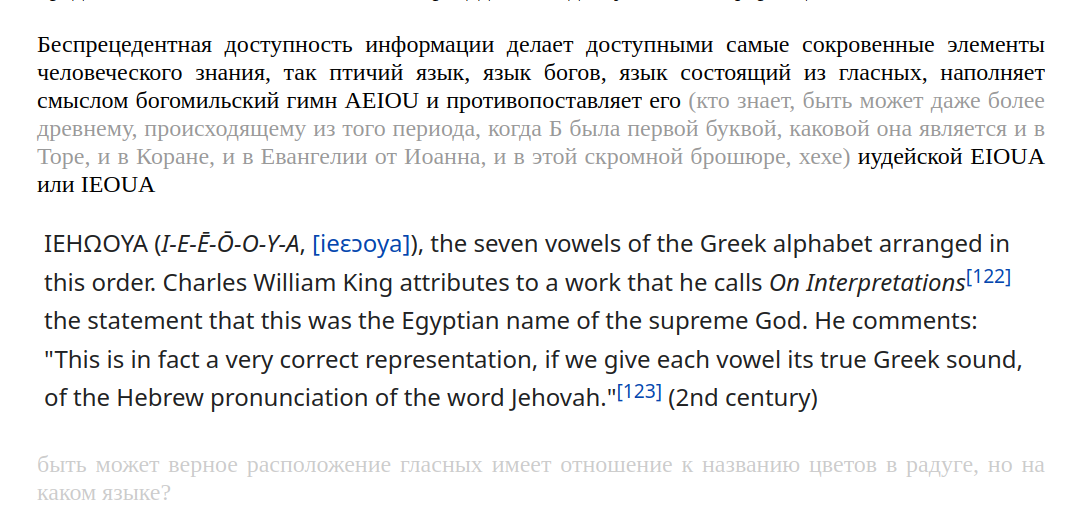
And here I see that Ω is unluckily oriented horseshoe. And Η is probably a H of Hex (H et X, Х et X)
is X the broken cross? Some wild animal is not affraid of it, it's definitely not a very good sign.
So did Demetrius or those priests depending on who listened to whom misheard five sounds for seven? Because E and O are long forms and I and U are short forms? It is strange, because oo is u and ee is i, even though here's a tendency, chances of that tendency were 50%, not very impressive. But then something impressive happens: W is double U but sounds as short U, so what could happen here? Did spelling compensate for pronounciation?
And when I rotate that Ω and get me Ʊ I see how much it resembles U
And that U greek does miss, having Y instead, but then it's Υυ, the υ still keeps this shape.
It is interesting that Ω is used for Ohm which stands for resistance.
from some paper nft I have produced about an hour ago
(I don't feel like selling you jpg or even gif, I will start the merchandize when I find a way to attach some right to publish or something else maybe even much more valuable to it. I don't even mind selling the exclusive rights for my drafts, but then I am a copylefter (even though I'm rather right-wing (or is it not much more than fashion? Would I mind a state which would do what I liked? minarchism is something I would like. and maybe that is the ukrainian way, the i instead of o)
хвалить has валить in it
praise has raise in it
raise
arise
ra ~ ar
благословить (хорошее сказать)
славословить (славу сказать "слава богу" (в то время как у совков было "слава кпсс"))
партия столь же абстрактное понятие как и бог (или чуть в меньшей степени, как церковь)
партия состоит из членов как церковь из членов тоже. из членов общины, составляющих тело бога, буквально причём, официально, может этим объясняется необходимость миньяна, чтоб бог вошёл целиком. тогда "американский огурчик" по любому был членом) но это неточно
есть
быть
суть
are
be
is
avoid lies. it's the key. use it wisely
не ври не воруй не бери (don't take lifes of people too)
I had a weird dream today. Where my book was saved by a girl named Melody
My Melody. Merry Melody. Metal Melody. Master Melody. Magic Melody.
and the melody (and few main words playing in my head during that dream were Unconditional Love
Б белый Ч чёрный
А for алый seems to be a later abomination, because russian word for red is красный
кжзс makes some sense, but I avoided о and ф, but what's more interesting is I mistaken зс for another ж with my weak sleepy eyes.
Were slavic always good with these things? Like me, like Mendeleev.
человек с железными яйцами ~ мудазвон
king is k-ing, keying, key figure, key thing, key the ingh
-ing is k ink?
king is key ink
doing is do ink
ink is in some k
the typo of k before ink was my subconsciousness telling me? ink is kink.
kink ~ tink tint
king is kink (fish is lead by a fish with one nut missing (they deleted different regions of the fish brains and observed different behaviour. So one part of the brain seem to be responsible for knowing one's place in the group. And fish with that part removed didn't follow outher fish. And as a result other fish followed them so they started their own groups of interest.
vestibular is of vestibule. I never suspected it to be the case. Funny is that I found this word in the context of speech in The Mistery Of The Seven Vowels.
I know of boo, but it's synonyms are booh, boh, bo (probably the different vowels are from different dialects and whoever recorded this word didn't recognize the more common word boo.
hoot down is another one, and I was looking for boo having learned the hoot word, as if that hoo in hoot is boo, as b in japanese is voiced h, a variant of h, a h.
I have an audacious belief: I believe thant runes predated greek and latin alphabets.
And the most important argument to support this belief is the shape of the runes:
ᛆ as 1
ᚫ as A in some old-italic scrripts (but it doesn't prove a thing, the borrowing could go the other way around)
ᛚ as both l and Λ (as if it explains them being different shapes of the same protophorm)
ᚦ as D, but being much more fundamental than D by being thorn as of a thor's hammer, which is axe, which is топор (молот тора топор)
ᛂ as a variant of ᛁ
ᚠ as F
ᚵ as ᚴ as Г
ᚴ as protoform explains the lower stroke of K being a swash, but it cannot be explained the other way around. Also a wider variablitlity, ᚳ being also a variant
ᚴ ~ Г ~ C ~ Ч (Ч & Ж are two letters obviously borrowed from runes) and it could also be γ
ᚼ as Ж (no other shape comes close, and ᚼ has much more similarities to Ж as ᛡ
ᛘ(which more often looks like ᛉ) doubled into logo of Primo Emporio and more widely known as ᛗ which would explain the shape of M, but moving otherwise would have to separate the v-shape from M to notice that staveless ᛘ is u (and staveless ᛉ is v)
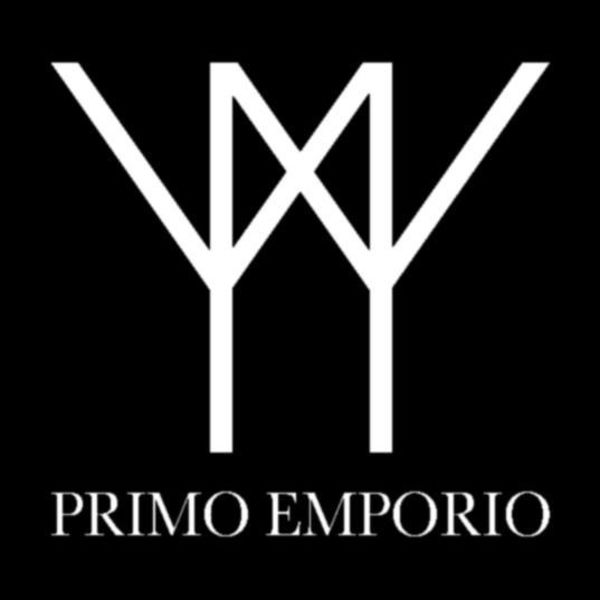
and another case of ᛉ the ᛘ:

But then not much can be said about the other letters so far, other than ᚿ is a lower form of ᛚ, and ᚮ is double ᛆ. ᛒᛁᚱᛋᛏ directly remind BIRST, but in the context of all the rest, I'd rather say that it's latin letters derived from the runic shapes.
and what is considered to be the oldest known purely phonographic writing system. and I never heard of it and found it by accident, so I wonder how many of these things can there be.
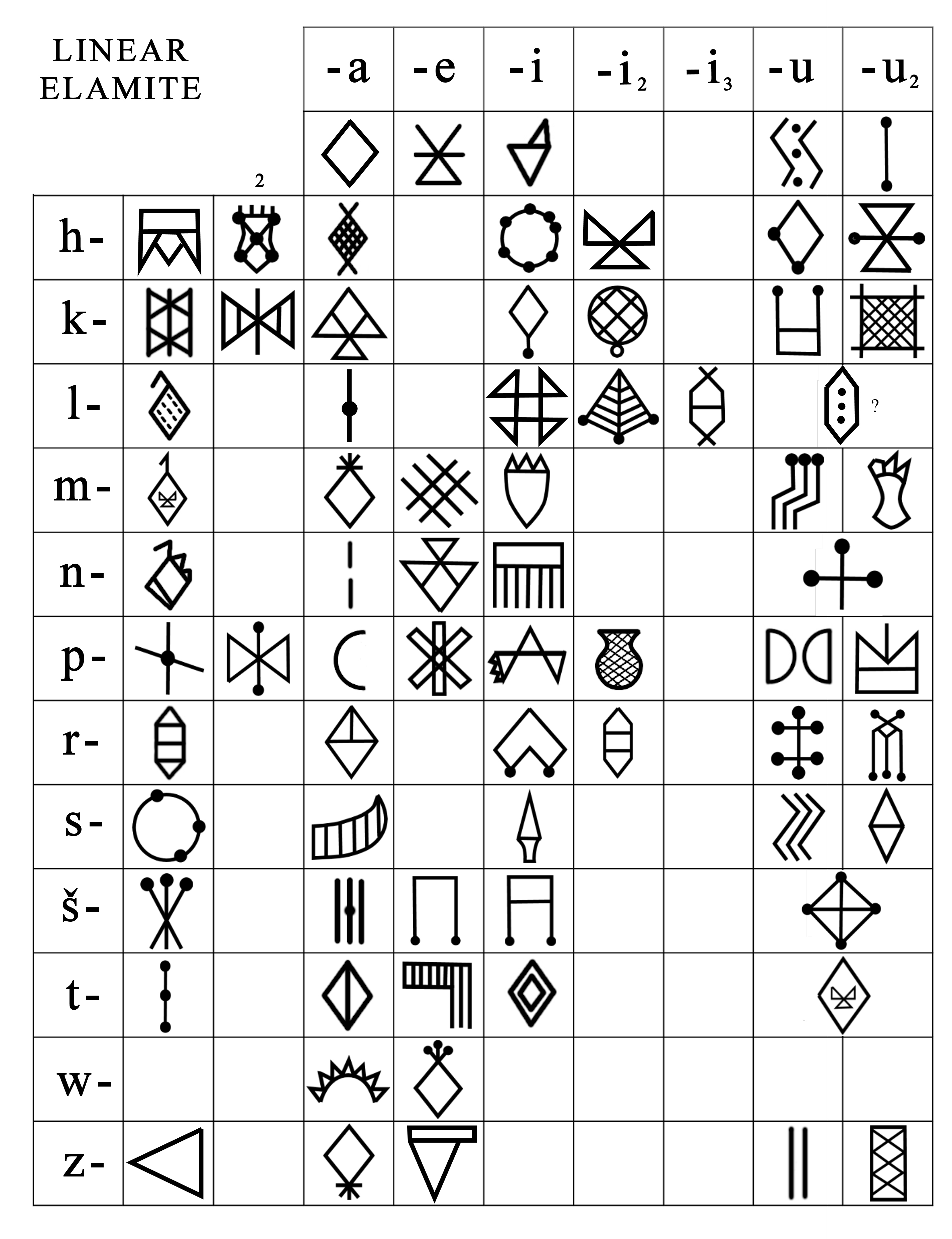
these shapes are like nothing I have ever seen, which makes me wonder if it's real, but then I probably have to learn more writing systems to know those similar forms.
Or maybe I should not: one of the first things I was told to do when I shared my thing with the world was a demand to do it in historic perspective. And it was a good advice, because that is how I found many other examples, but it also was a bad advice, because this way I went astray into the field of too distant writing systems. This one is not necessarily decyphered correctly and it is definitely not in some alphabetic order, I would be shocked and awed if they also discovered an abecedary, probably not, they only recently discovered it. And no surprise in the order they used: it's alphabetic, natural for an european researcher.
Some of those shapes are animal footprints. It's for the first time I see something like this, and I was looking for something like this. Especially that mi, is it mishka? Then is myu meou?
Look at how mi looks in cuneiform elamite:
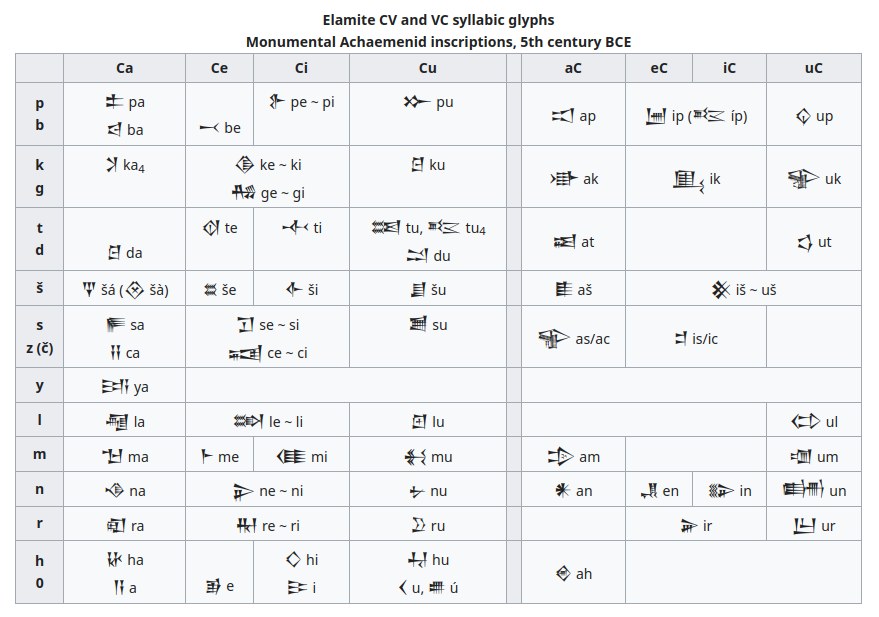
But I would never saw that mi as a footprint if I didin't see it in elamite linear, but then other m- signs don't seem to remind the linear shapes that much.
And to close this new (for me and the world) topic, we sould look at what they consider to be proto-elamite, and at first I wondered how would they know it was some elamite, if they didn't decyphered it yet, but then I saw how some shapes remind the elamite ones, compare the li to the shape in the centre of the first line, for example, and then that unusual u2 is the sign from the middle of the third line, and the sign next to it is hu:

and looking for this thing I found something different under the same name:
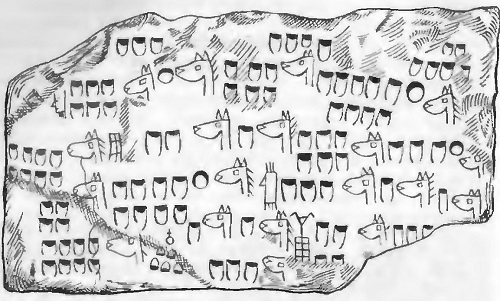
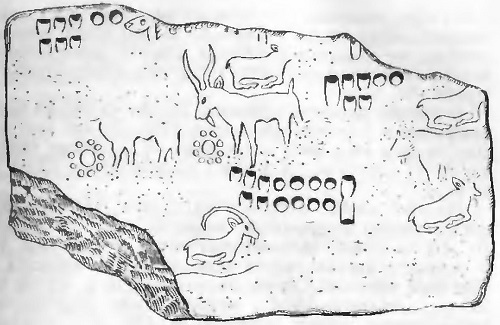
looking for the sourses of this tablet I got overwhelmed before I found it, so I didn't find it, but I know the numerals they used:
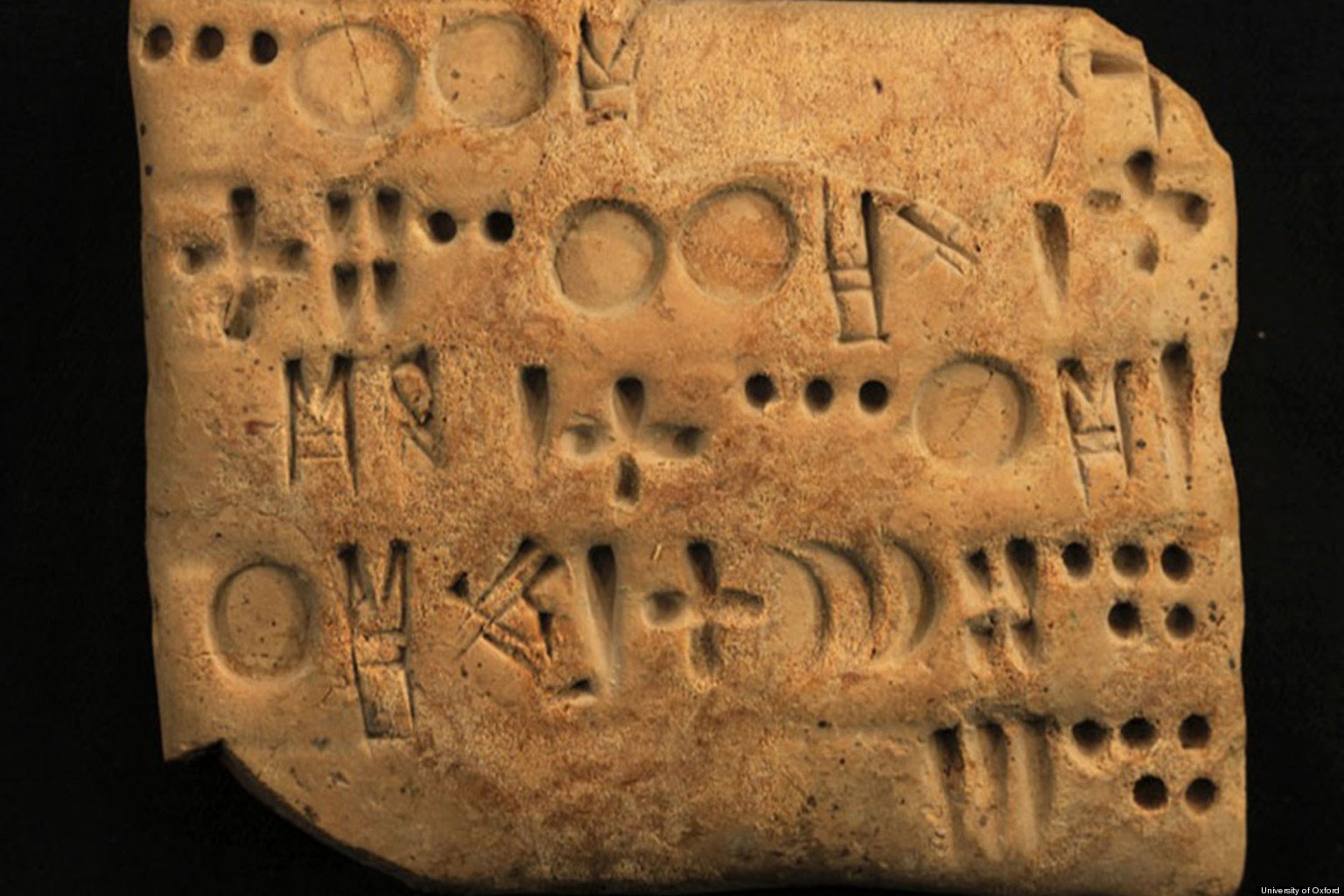
but let's get back on track, this stuff if too deep for me so far.
but first, something more on the previous subject:
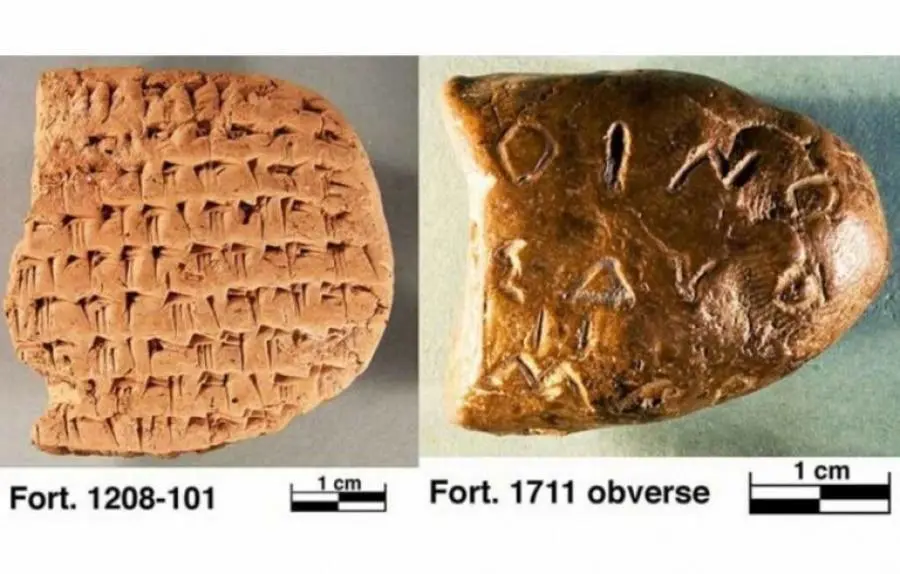
to bodge латать
to botch неумело латать (портачить)
and if voicedness had this distinctive meaning, it only makes sense that бог & god are all voiced.
(satan isn't but devil is. чёрт isn't, but demon is, fucking is more rude than bugging, but then is fuck the opposite of бог? probably not)
ukrainian and russian are keys to each other and maybe to everything else:
условно ~ умовно (thus, мова = слова)
Gigi Ugulava said, in georgian goy is somebody whod doesn't understand much and is no good.
is liking lo(not)yiking (not saying yike! yike ~ icky (icky is also a synonym of sticky, thus could be some cockney-like variant of that word))
icky is probably of itch, of ache, of hiccup too (yikes could be another form of hiccup, another transliteration of that or similar onomatopoeia)
Magic iof the language of the deaf is what I ame to search for.
ame is a typo of am, but it distinguishes am as aim (wehich would be as great in that context as am)
homonyms are cognatic, orthography made them different, but they are the same:
aisle = isle (if where you cannot walk is sea (sit ~ sead. ships sit? ships sip! хлёбки~шлюпки, чашки, шлюмки (ложка = весло у зэков (я бы сказал "на фене", но тогда бы возникла двусмысленность, good luck explaining these homonyms as the same)))
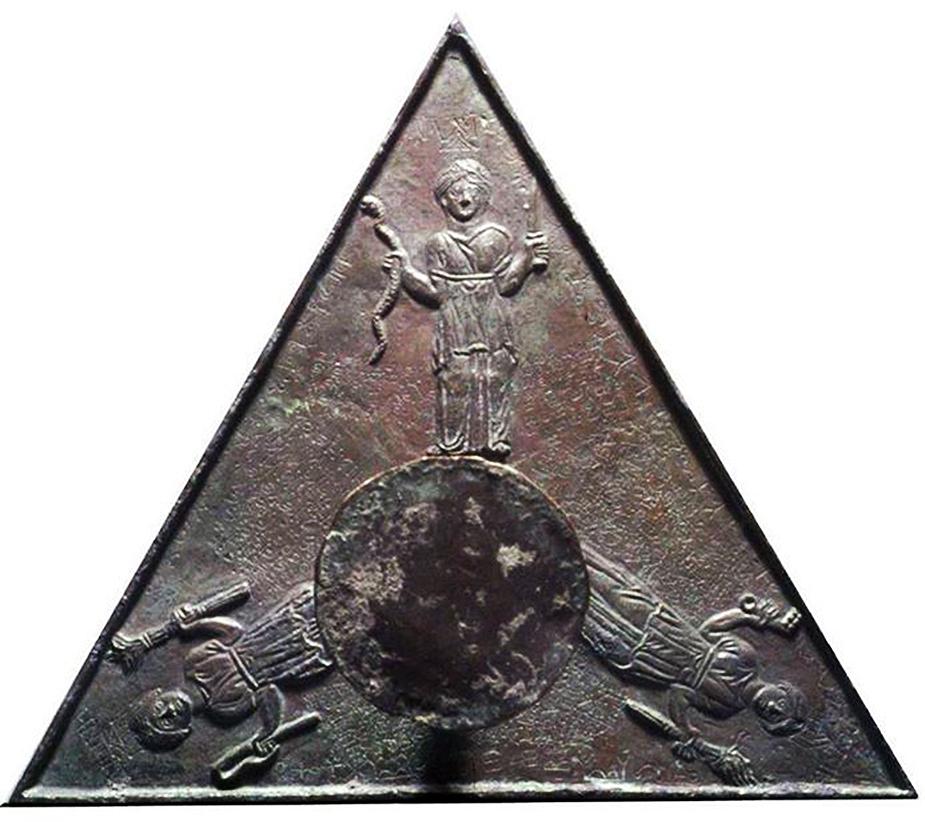
.png)
.png)
some great piece of semantics I have met today:
> Why does everything spin?
it doesn't spin.
it twirls :)
satirist is next to satanist (seeing that word I waas like hwat) which is no wonder since satyr is of horns and tail and hooks and male face and goat beard too.
and imagine my shock when Bill Hicks, "Sane Man" (1989) was the show I've seen the next day. for the first time. by accident.
нёбо ~ небо
palate ~ палати ~ палаты ~ пол ~ полка ~ ПОтоЛок ~ floor
roof is the opposite of floor ~ for? ~ пол
палаты комнаты своды (was heaven taken as a cave? if people couldn't imagine infinity, and they couldn't, sure)
I bet
A B a bei obey
bet ~ obeyed?
bets ~ dies? nah, not sure, maybe not, probably not
the die is cast
(кости ~ dies (pieces of deads))
жребий брошен (кости жребий обожраны обглоданы объедки?)
bet объед?
I bet
о b~t
book is bc? word from times when a wasn't crowned into one.
b is 2? first number was two? people knew two before they knew one?
ΑΕΗΙΟΥΩ

a russian translation just in case:
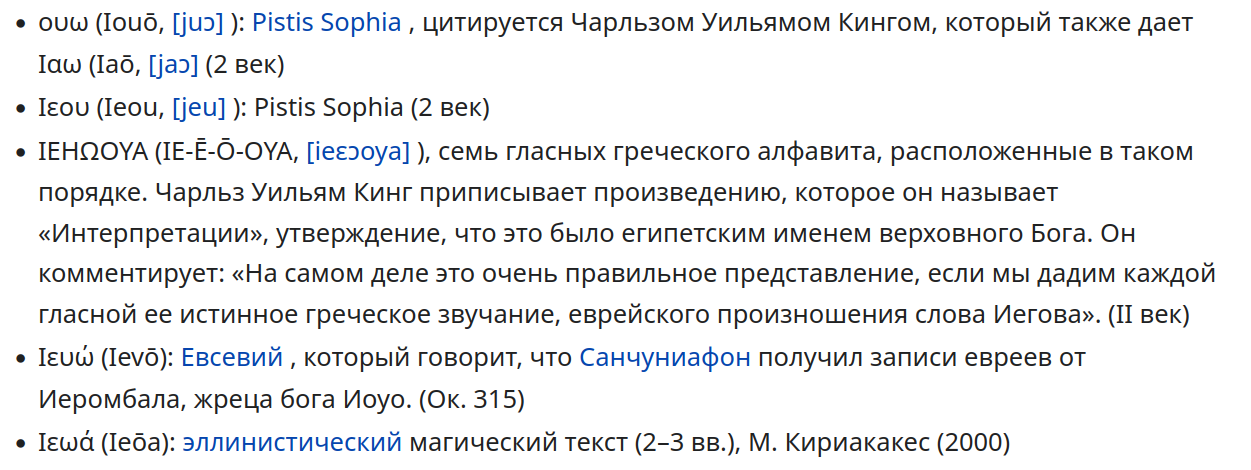
and a piece related to the one I posted earlier but with some more detail:

Ιεου (Ieou, [jeu]): Pistis Sophia[121] (2nd century)
Did jew name themselves ieou? in the light of I&I it would make some perfect sense.
Do they pray to their nation? Do they call themselves god? Are they the only god there is (it's all in their heads, and sheep only believe them like the fools they are.
go ~ do
not only because russian d is g
but also because japanese is surprisingly cognatic to english:
(は) wa ~ am
(が) ga ~ do
but then even though russian textbooks of japanese teach that ga goes where verbs are, google's translator seems to use wa everywhere. I probably shouldn't speak of languages I do no tknow well.
I Mi Ni Shi could be alphabetic sequence, but it's I Ni Mi Shi,
and rarely in such sequence, it's usually Ichi Ni San.. But I see that ichi is japanese ni is chinese.. so is san being japanese
i is chinese: chi is suffix
にち 二値
Noun which may take the genitive case particle 'no'
1. binary; two-valued
but there chi is 値, value, magnitude, dimension, size, bulk, price, cost
the two is ni
nichi is sun, sunday, day
but michi is three, right?
Michi is way, japanese variant of do the 道
Michi is also honey: みつ (蜜)
but つ is tsu, ah, here it is:
Other forms
蜜 【みち】
which is surprisingly cognatic to russian мёд and english mead
Direct translation of honey is 蜂蜜 (Hachimitsu, both hieroglyphs have japanese reading)
蜂 (hachi) is bee, which is cognatic to russian пчела, because b is of h in japanese at least
доверстал довершил
forward for word for ward
if word is bastardized chinese, it's some wo rd, where rd is of read.
wo is for? makes sense? makesee some perfect sense.
🜂 гора горя
(кратер ~ tear of core gore гор)
kR ~ хрип
вскл ~ всхлип?
Когда бен Йехуда говорил что иврит базарный будет совсем не тем языком которым он с богом говорит может быть
Мой друг Ковба вдруг стал Ковбан
Кузнец? Коган is jewish Smith?
Не обязательно, но украинское Ковба по любому от слова ковать, but they say коваль.
по любому
следует ли зщаменять это слово на точно?
вражда ворожба (вора жаба, вора жида)
b = d? Before syllables became their own consonants, thus we have four or even five c's: cgkqx
h and s should have been included? but they seem to be an element of their own.
dhlnrstyz?
dt sz Lr hny?
is the c of d (the belly of d)
The be..
zie, thee, вы (fricative as their own group)
бы мы вы скорей всего были одним племенем, мычали? ом?
те ты то та ту they Трое
я
I
me
мы
thou
thee
thy
thine
they
their
them
thus
ich
их
I я
Me мы
Their их
(the ir)
ir glaz? vidimoe? не те с кем говорю, но те кого вижу?
is х in их r?
is х in их s? is их plural suffix? And it is!: молодых (безх него
their сиих
the is singular of their?
ir is literally plural suffix in ættir
ir is related to tatar plural suffixes lar and dar, and are they tar in tatar is their suffix ar?
is lar and dar their with la being french article and da being afroamerican one.
Afroamericans and Euroamericans
are Africa and Europa cognates somehow? Different readings of the same ancient word
эфиопия и египет being some in-between variants, northern african variants.
ребёнок либонок людюнок
ребёнок легонек лёгок
рыбонька
берёнок бережёнок (рыбонька у бережка?)
берег берёт (не берёг, а берёт.. но )
глори глои алелуйя глори глори алеле
ои ои аиуя
а е у я is how it goes in russian
а е ё ий о у ы э ю я
бёквё ё мёжёт зёмёнёть сёбёй всё ёстёльнёё жёлкёё глёснёё бёквё
глсн лшн, бат уан ууд б нс бут уун ууд б нс.
нас? nice! неси носи несу (за низ. волоку за верх?)
ы э ю я
i e u a (if we only had four vowels, as jews are having it, that is how jehowa'd be. א ע ה י
шоумен ~ шумен (отсюда)
вода + огонь = огнь + вода
вода + воздух = пена
пена = spumă = foam
spumă = мыло = sapun = soap
How could russian alpghabet preserve voiced-voiceless structure?
В том детском алфавите щука становится сукой, и быть может сука она и есть, кусука, или сухая потому что худая.
щука ~ сука ~ с уха (из ухи, к ухе, для ухи)
вырезал окончание брошюры, но решил не выбрасыват, а сюда пришёл, это в орфогрффии детского алфавита, и исследую его возможности и подыскиваю более удачные вариации, потому что Ж З напротив и Х С и Ч Ш не канает, сейчас вижу, что Ч С может отлично отразить, если Ж является G и звучит как dʒ, но это может позже так начну, здесь сначала использовал т вместо ч, так что что было странным тто, неузнаваемым навернео даже, ребёнок бы сказал сто. сто ты деляес. Ми должни пледставлят это плоизнесённё дётьмё, мё дёлжнё зёмёнёт всё глёснё бёквёй ё
(это не моя идея, но эта идея замечательна. ё волшебная: она всегда ударна)
(ётё нё мёё ёдёё, нё ётё ёдёё зёмёчётёльнё. ё вёлшёюнёё ёнё всёгдё ёдёрнё)
ударна~ядерна, а если без гласных, то ещё и ядрёна. дрн

Лихно а вижу, хто Η и Ω добавлени позже, и в написании ΙΕΗΩΟϒΑ лих авлаутса отлажением долготи букв Ε и Ο, котолие тоже могут бит относително поздним вклухением, потому хто пли славнении поладка гласних в латинском и в апонскои хилагане-катакане, обсей последователностиу авлаетса А И У, именно ети тли гласние и именно в таком поладке били исползовани в длевнепелсидском писме и в системах писма до сих пол сусествуусих аж на Филлипинах. И до того как била изоблетена пентатоника, плототипом квинто-квалтового клуга мог бит тлеуголник, пли изоблетении же пентатоники, подобнои диагламмои стала пентагламма.
Фолмула Иеоуа говолит, хто таким поладком било IUA, тто подтвелждаетса глафитески: IVA
Eve the Goddess? Venus? Vena? V of wow? 𓈖
Богина Ева? эйва? (кстати, глибнитса похоже хто подобна неилосети)
бит может велное ласположение гласних имеет относение к названиу светов в ладуге, но на каом изике?
но если пелвихноу последователностиу било тли гласних, то можно пелебилаиа их наити наитивно лабохие и далее иними гласними класиво ластсветитт (надсат смагтает удвоением)
(х использовал для ч, что вызвало много вопроов, возможно последняя строка будет лучше в виде УФЧШ, это самое сырое мясо, передний край даже моего собственного исследования,быть может не надо этого здесь.
Шум (the background) is ABC'ic:
a bac.. a basic!
(basis, is is suffix here, ic is suffix in be.. basic.// is s suffix in base? ba's (b as in popa? booba and poopa (popa is ass in russian))
a m s in te the order of шум are jewish shem of ha_shem (tha is the)
(шум в отличие от музыки отличается тем, что он немузыкален, не выдерживает требования музыкальных стилей и ном. Парадоксально, но шум мужи.. может (мужит хаха, мужик может and thus k = t, and thus k is ks the ξ)
music muses? amuses? a- is not. music moves! amusement doesn't move? amusement ~ amazement!
maze.. is ..does maze move?does it move (the door) away? door or turn?
If we move along the wall, then what is a turn, if there's wall? a door. If the turn is the other way around, then often that turn exists only because there's a road perpendicularly, and as you know there are many more crossroads than T-turns, thus much more often than not, turn away from a wall would indicate the existence of a door not frar from that turn, so that turn is door'n
ножка ложка (нож использовался как вилка до того как вилку изобрели, согласер рлерй согласно одной детской книжке)
нож и лож?
ножка маленькая нож? нож = нога?
T symbolizes death and 13 in tarot stands for death. Great book of Toth is about Tarot.
Can we trust tarot? Why else would it be so polular amongst wizards? witches?
Could T be 13th? After the 12 months the 13 (hidden, or holy or sacred (sacred is secret))
A M S were beginning, middle, end? A M Z is officially initial, middle, final in current latin alphabet.
of what latin alphabet? Of italian for one:
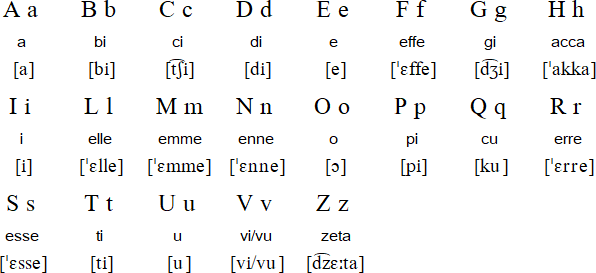
and italian allowed me to reconstruct the childish latin:
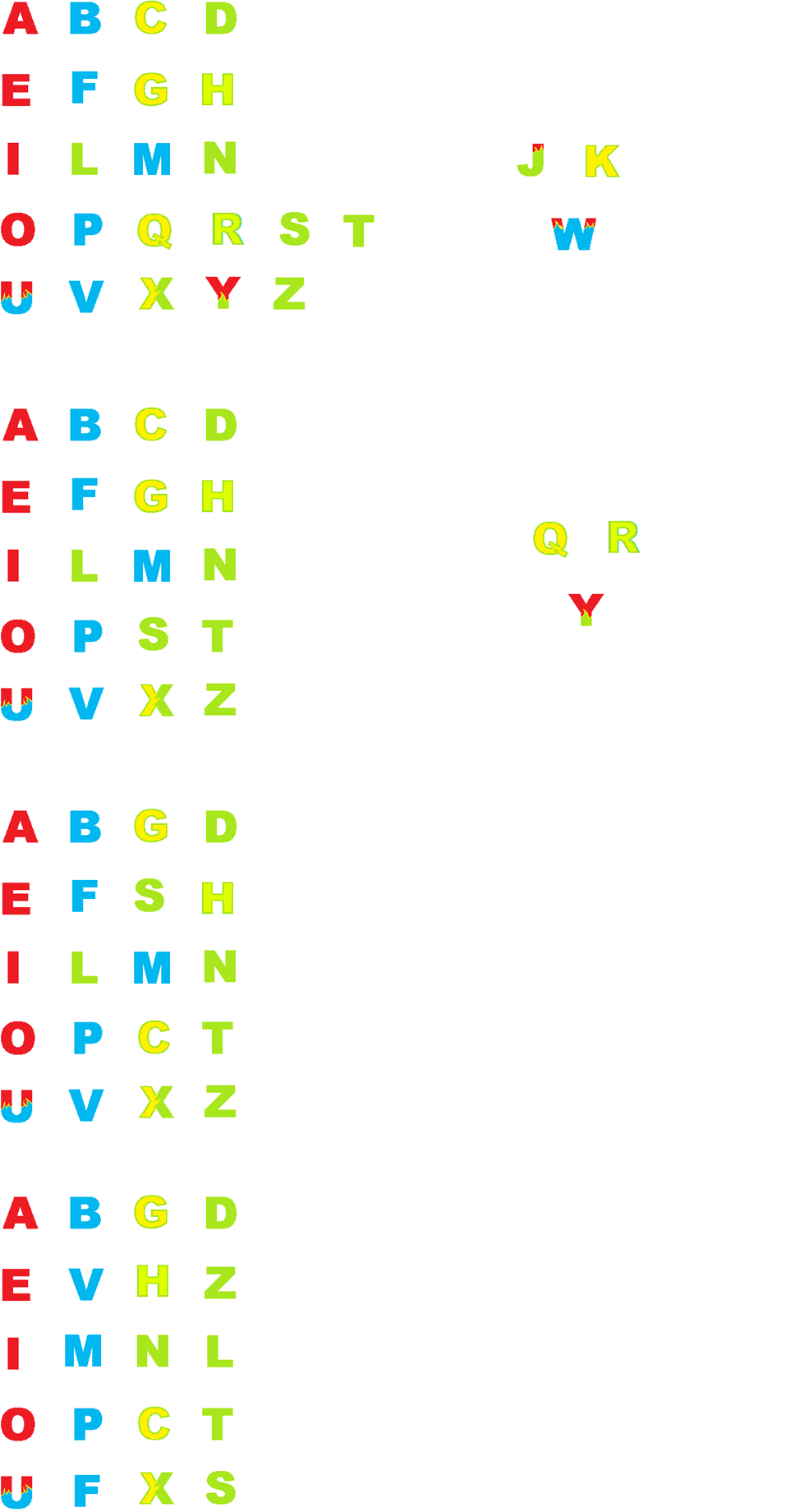
First I just demonstrated italian and the three letters left out (it is interesting that JK seems to be later addition, but Romans probably never lost their literacy. It is also interesting that JK are in the Immanuil line, but I have spoken about it already)
I was fascinated by how it trimmed the I-line perfectly, and I followed this trend by removing QR I recognize as variants of OP, and of course Y is Ij, so just as W being Uv, it goes away.
and then of course I saw V and Z being voiceless Ф and Ц (F and Ts) in german, I still rearranged them to make it more clear. But then native speakers may choose which letter is actually which. Here I place H for voiced h, and X for voiceless h. C [k] but maybe native speakers find ABC more canonic, more iconic, then C will be G and K will be standing where I placed C so far. Immanuil saequence of IMNL I have discovered before places N in the C column, of which I was dubious because of Г ~ L thing, but then I recalled that it could be ŋ and thinking of h pronounced with noseful of mucus it kinda made sense. So are they all just one line? The same line pronounced differently in whisper or snuffle.
But then why vowels are like that? The line of sonors would better go with U, and oh surprise, russian vowel of the i line looks exactly like u: и[i] (и[i])
is I secretly ו?
Then E and I make perfect sense as vowels of the palatalized rows.
Double a is o, double e is i, makes sense, but when doubles are voiceless then?
Double o is u makes more sense in how it currently is.
is I the И some sonor vowel? Nasal vowel? Ы? Ukrainian И is russian Ы
..but for T to be 13th, it has to have three letters per row. Whether by removing three more letters before it by having it like ABC and not ABCD (or, who know, maybe by keeping vowels separately) and these hypotheses may be approved or rid of by comparison of this thing to the naьуы ща zodiac constellations.
A great way to study german: they have the lyrics in description, you may ctrlV it into the online translator,
and this "russian singing in german with berlineer accent"
A Russian singing in German with a Berliner accent.
see how poor my english is
teaches us how to pronounce it and it has nothing to do with russian belief (myth) that it is read the way it's written (they believe it even though almost everybody knows that sch is ш
Beginning to understand german (I almost recognize all the morphemes now) I can see that it is to english like ukrainian is to russian.
Zu Asche
[tsu aʃe]
to ash
[tu eʃ]
zu=to
~
zuletzt ~ too late? the last? (late~lost (late father))
zu=too or zu=the ??
letzt is also last
letzte is another form (they have use for suffixes)
Etymology
zu + letzter; cognate with Hunsrik zuletst
Alternative forms zů (obsolete)
Etymology
From a spelling merger of two interrelated adpreps: 1.) Middle High German ze, from Old High German za, zi, from Proto-Germanic *ta; and 2.) Middle High German zuo, from Old High German zuo, from Proto-Germanic *tō. A distinction between both words has widely been retained in dialects, and also to some degree in modern spoken German (see pronunciation section below). Cognate with Silesian German zu (contractions with the definite article: zum m or n, zur f); Dutch te, toe; Old Saxon tō; English to, too.
тонкая граница между бить убить и убыть и быть
вбити и убути
russian у- didn't make enough sense to me, but в as in makes perfect sense.
and in and no meet again (у is away (it's russian u, so it stands for w in away and u in out, but if it's read in english manner, it's why which is next to way (weg is both way and away in dutch, which indicates that away is a way))
werDE (whoEN) sounds pretty much like whereEN
wirDE (weEN) sounds pretty much like we'reEN
Невзоров demands place in this book (a file of his from the depth of my mind, I guess)
He is the only one who speaks of Sasha Gabyshev today. And he dresses like a shaman, and he looks like a shaman?
Shamans of Russia must unite to save Saha Gabyhev
a
e
y
o
u
many times latin e is read as э and other three out of five are not palatalyzed. So wouldn't и also be read the way ukrainians sing it and not the
диатез с анамнезом не путаю, но диагноз с анамнезом могу
(не очень-то крутой доктор, но я учусь покамест, но уже кое-кого исцелил)
Could confusion of mama and deda in georgian to daddy and mama in english and pretty much every other language I can think of (but then I think of all the languages of which I do not know, and even papa in romanian and slavic languages, and does it tell that romanian and slavic languages are closer to eorgian than germanic languages? they probably are, so it could be a part of a larger picture I shouldn't theorize about before I integrate it all into some unhuman mind) be causerd by georgian tradition to send a spouse to check on who and why is calling their loved one?
Dear comrades in chinese would be 친애하는 동지들 [chin-aehaneun dongjideul]
동지들 dongjideul [tumchitei or tumchite, as you can see, d~t, J~Ч (sometimes in script J looks pretty much like Ч)]
친 чин (friend)
애 ае (baby)
친애 чинае (love, endearement)
하 ха (under)
는 неун (is)
하는 ханеун (which, doing)
친구 чин ку (buddy)
구 is nine, but also has too many meanings for me to know.
this guy is a mega genius but it's too bad it comes with other weird attributes that make people ignore him
This thing said about eric j. lerner
эрик ис эпик
эврика эпична
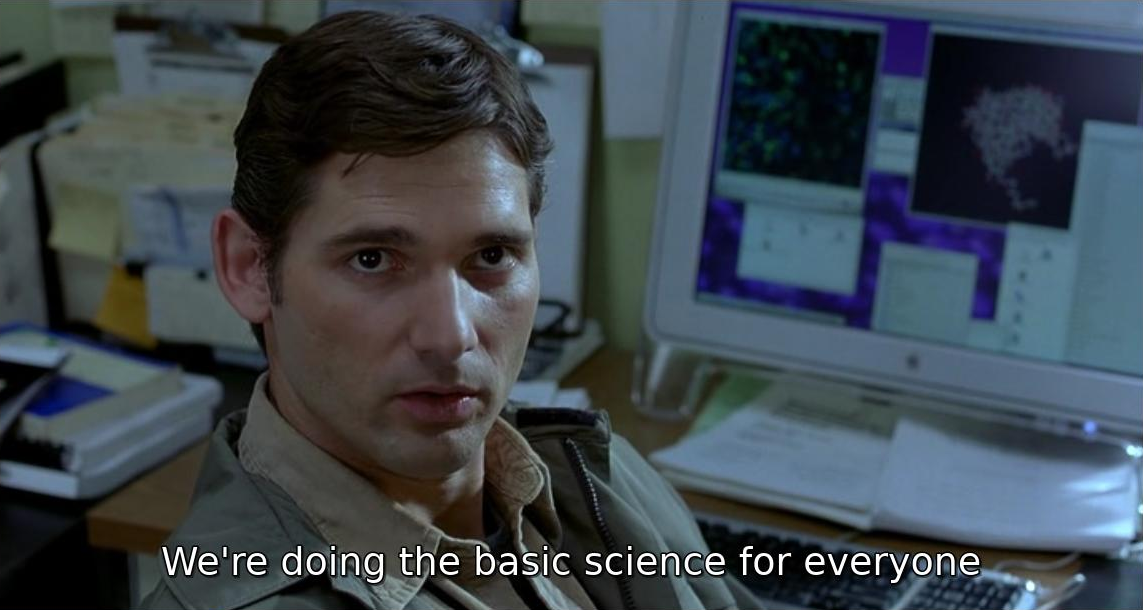
Here is a proof of the point that semantic translation is correct one, especially when it's stylistically adequate: Занимаемся наукой на общее благо.
is an example of great translation, much better than what a guy who avoided working as an interpreter, as a result avoided the necessity to find the adequate translation to understand the language.
politic has that -ic suffix, nad if you see polit as polite, then it looks like some information quotient (as polite are you to other people, how polite are other people to you)
and if politi is polite, then the suffix is c, for cuotient the quotient:
in russian this suffix transforms into (кий, какой) ский? сколький?
is that c q?
по киргизски куш птица, а таш камень (отчего-то я думал ,что куш камень,
куш кушать, таш is to toss.
que are is it (final group is am?)
i j k l M n
o p q r S t
aRe is next to iS, which is under M. hardly it is a coincidence. Is it, dare I say it, mother?
Власти, которые do not tolerate any criticism не выдерживают никакой/малейшей критики.

i j k l M n
o p q К S t
I accidently wrote K instead of R, and it makes me think of how much k looks like R again.
could it be Q~R because q~р(р is russian R) then [p]p~q too, pqr is all R, which is labial if it was pronounced with lips, a thrill of old people, probably preserved only in Piraha.
O PQRS T
or
O P QRST?
then why q and r are graphically p's which also stands next to them?
PQR is probably a code for power.
pocker? no, power, I think I saw a q-like U, and I'm sure it wasn't у[u]
R and L could demonstrate that L is palatalized r
is it L as r with a пол?
oPqRsTu thing made me see that aBCD is Брат
(it was a revelation, so I didn't memorize the details telling me why it is so, but it is a miracle theat I could remember this having not writing it down at once)
I was thinking of how or why would they draw petroglyphs in the caves, and the first idea is to mark which way the exit is somewhere where eyes still can see. And the firwst way to do it which came to my mind was to draw a tree the way it grows: head's up: 🌲, which could give birth to ↑
People often rephrase to explain the extralinguistic details of the initial message:
"это нихуя не комплимент" вместо "это не комплимент" дабы добавить выразительности, которая изначально выражалась выразительностю сказавшего, выразительностью, которую не повторить.
"john who?" to express the look on the phases of Amyl and the Sniffers when they were told that John Waters is their fan. They didn't say nothing like that.
отворот-поворот (вращение против часовой)
сё ~ this ~ the S
то ~ that ~ the T
T ~ ᛏ ~ ↑
S ~ sit? city? (селО сЕло) and then S is a road? road from one home to the other? then homes should be around, and I think saw such a shape: 𐎝
S ~ Ш ~ ↓?
не брат я ~ не братья
не брат он ~ не братан
гробница ~ гроб ниша ~ короб ниша ~ полка? короб не короб низа
низа ~ не за ~ недо ~ подо (but за и до зачастую противоположны, как я так перепрыгнул)
nop is claster? nopqr? I thought lmn was the claster. In IMNL case it is (..forgot what was about to say)
and I see ЗаМаНаЛ в ИМаНуиЛ. эс иф i~j~g~z (i and j are the same letter in the past. j and g share the frequencies of ж the ᚼ)
And if i~j, then ᚼ is (ᚽ[h] or ᛂ[e?]) h~e? I saw it few times. Arabic e is h. Greek h is e or i (vowels are all unique (depending on your boundaries of standard pronounciation)
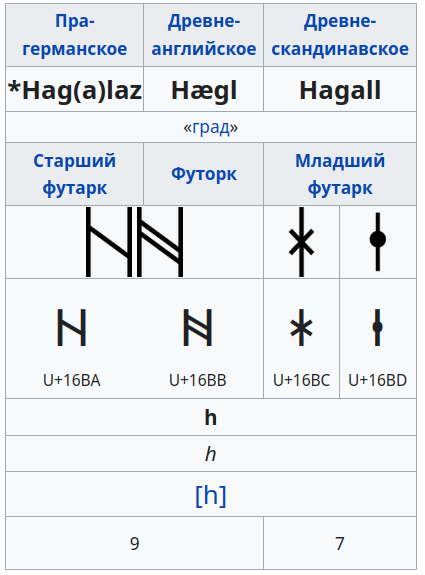
so that cross is the dot. And what they call older futhark is probably older to futhork and not what they call the youndger futhiork th futhark
are they two separate systems or denote the same concept on double staff instead of single one.
But because I used ᚾ instead of ᛂ (the E!) a dotted form of ᛁ (e is dotted i? ї (like e & ё?))
I don't mock, I talk.
are you is я тебя in some languagwew with russian ap and english you.
The wiki upstairs tells that older futhark is proto-0germanic and younger futhark is skandinavian, thus telling that germans and skandinavians are two distinct groups and that englishmen got their futhork from germans. Or did germans got that from englishmen? Is linguistics infested not only with eternal jew, but also with eternal anglo. Tolkien is an example of such corruptive action
-ive = if?
corporative relationships ~ corporate if relationships?
deep ~ down ~ from the hill the city is built on. Why would you build your city on a mountain? A water source. ключ is both key and spring of water. As if metal springs are called after their water predecesor.
swedish en saft (a juice) freaked me to search for that en:
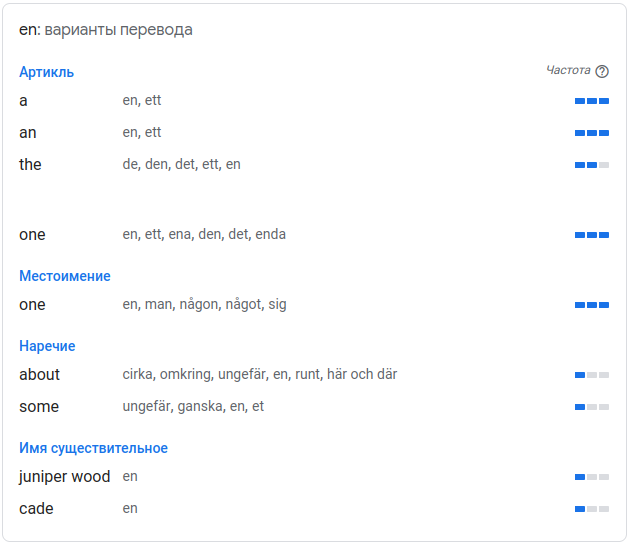
And that juniper wood and cade made me dig into it. And how could I not have known about it yet?
.
upstairs? do I go down? to the roots of it? as a shaft digger.
вперёд внгиз впердь
вгниз? гниол гниль глина
гнись к низу. гниющее растение так может делает, гинет
'
D is L with swash.
and so is d of λ
брат ~ blood
(sent to cognates)
r is how the tongue is touching the l-spot yet sounding by the back of the tongue more.
bud a
bad э
bed e (do englishmen distinguish between э & е too? do they have alll other vowels? and some more)
beat
boot
bead
beat ~ bead? бусина букова? бит ритм? бит = бит (beat = biot bit, as in telegraphy, as in computerS)
bear beard bveared
bear ~ beaver?
bear-vepr?
ᚩ is as (god)
B is beta~better~good~god
and this line of thought brotught me this:
NAME: Cotton MS Vitellius A XII
RUNES: ᚪ ᛒ ᚳ ᛞ ᛖ ᚠ ᛡ ᚻ ᛁ ᛉ ᛚ ᛞ ᚾ ᚩ ᛈ ᛟ ᚱ ᛋ ᛏ ᚢ ᚳ ᛉ ᚣ ᛝ ᚦ ᚫ ᚪ ᛒ ᚳ ᛞ ᛖ ᚠ ᛡ ᚻ ᛁ ᛉ ᛚ ᛞ ᚾ ᚩ ᛈ ᛟ ᚱ ᛋ ᛏ ᚢ ᚳ ᛉ ᚣ ᛝ ᚦ ᚫ ᚪ ᛒ ᚳ ᚦ ᛖ ᚠ ᛡ ᚻ ᛁ ᚸ ᛚ ᛞ ᛟ ᛈ ᛣ ᚱ ᛋ ᛏ ᚢ ᛡ ᛉ ᛈ ᚪ ᛉ ᚳ ᚩ ᛒ ᛁ ᛋ ᚳ ᚢ ᛞ ᛖ ᛏ ᛋ ᚪ ᛚ ᚢ ᛋ ᛈ ᚪ ᛉ
bro brings?
tho things? though, brough, bough..
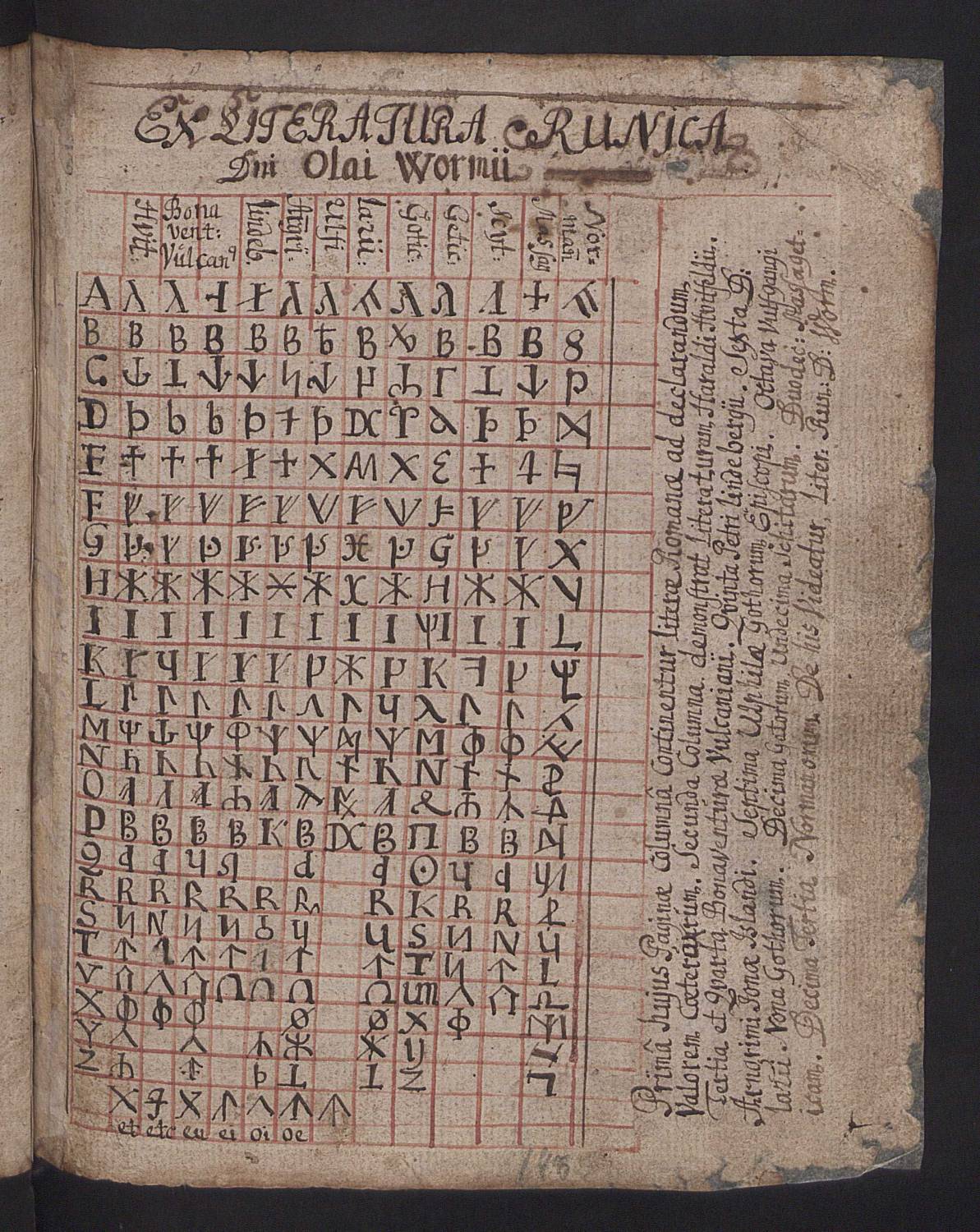
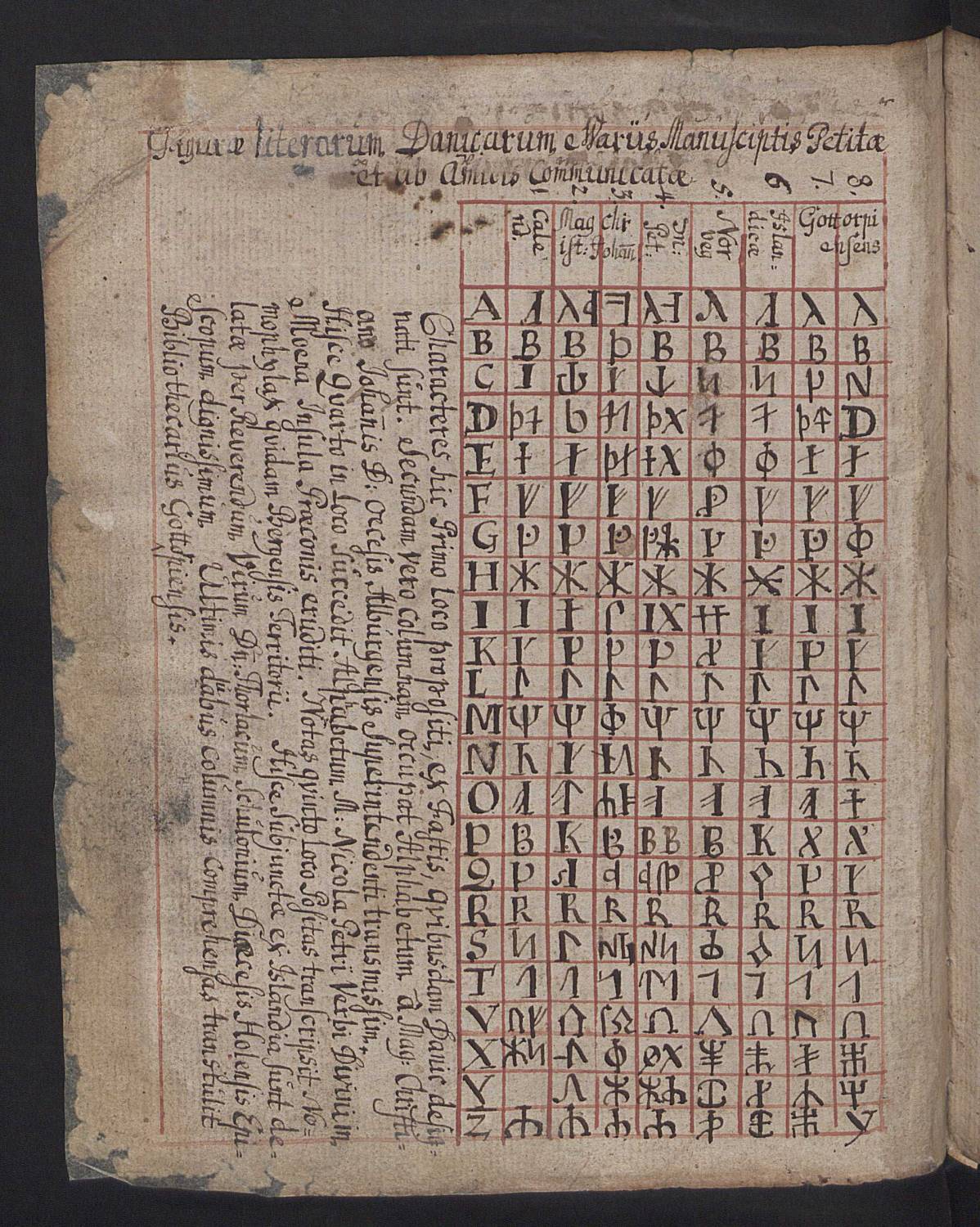
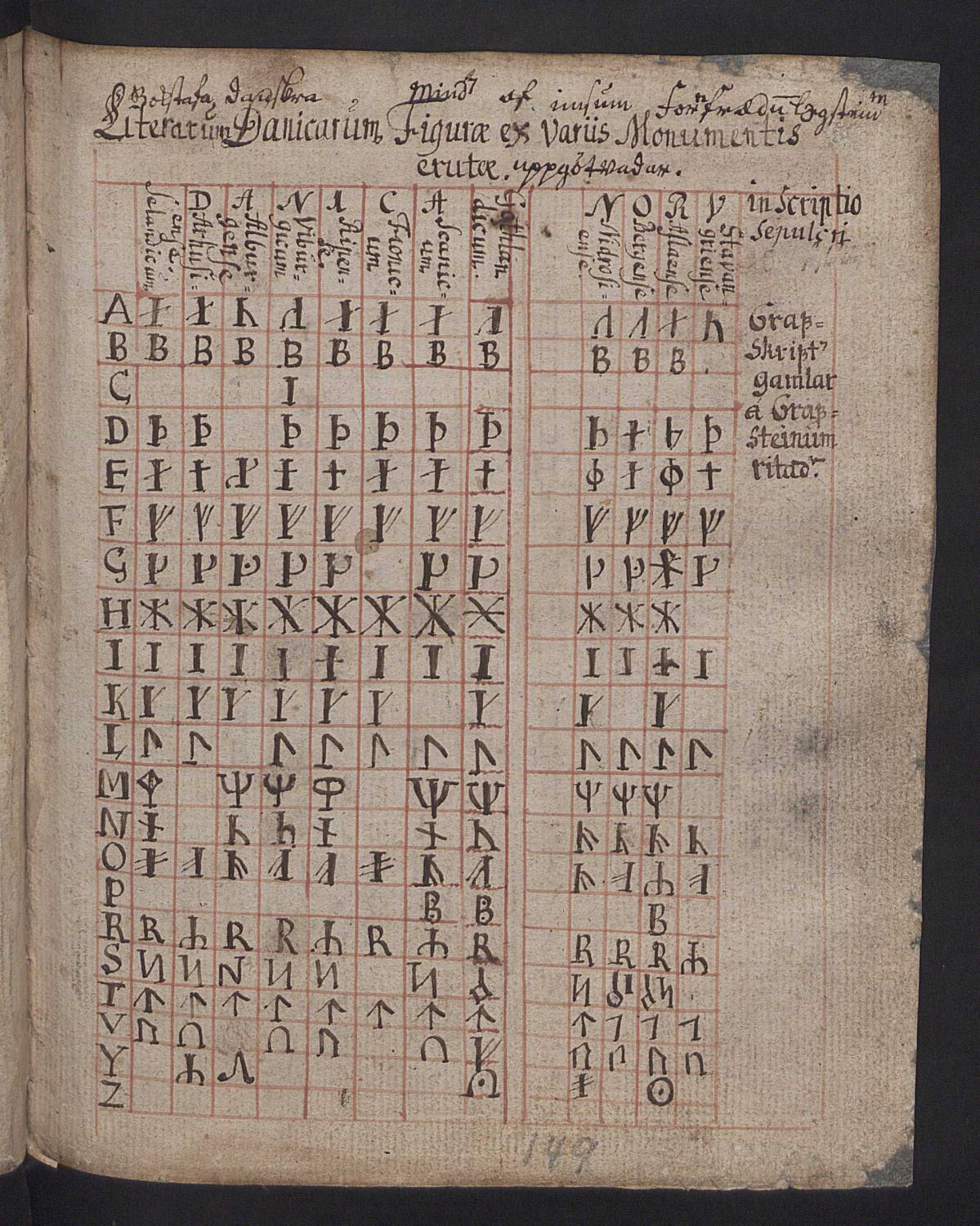

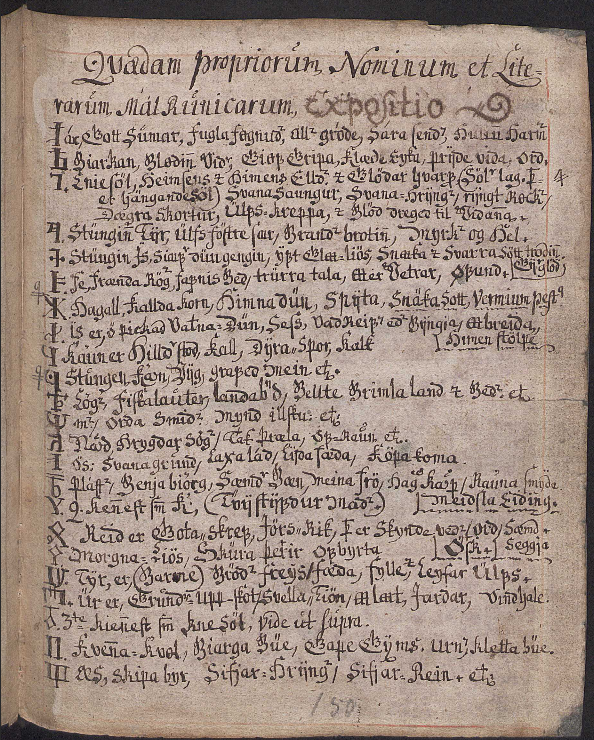


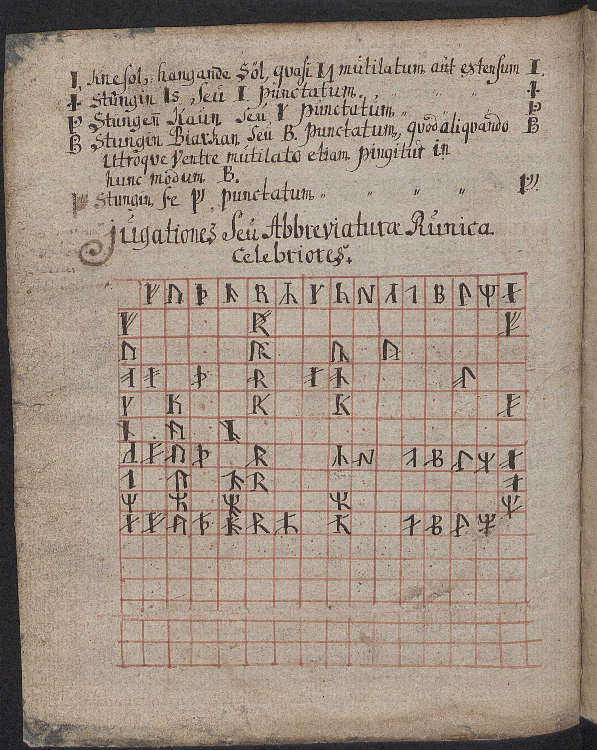
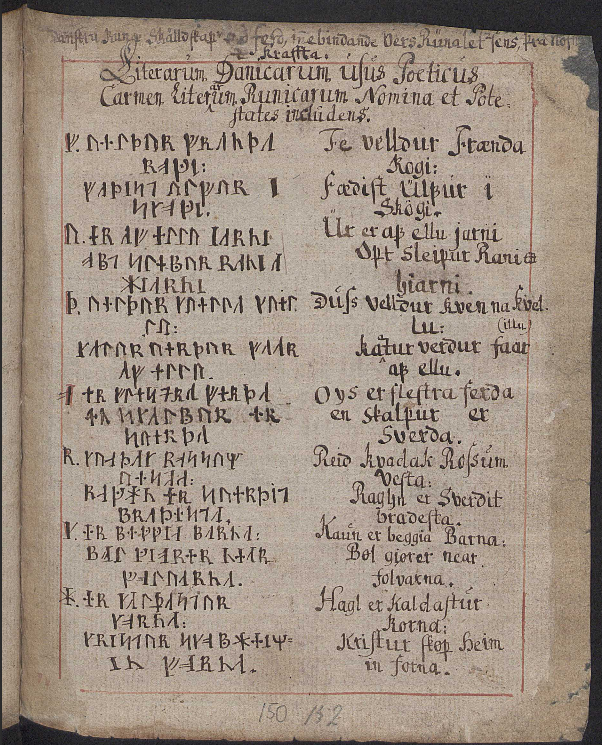
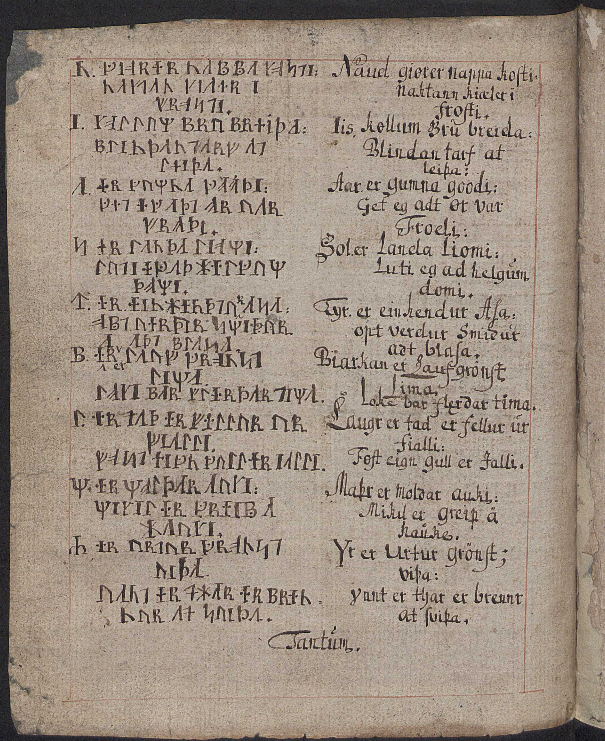
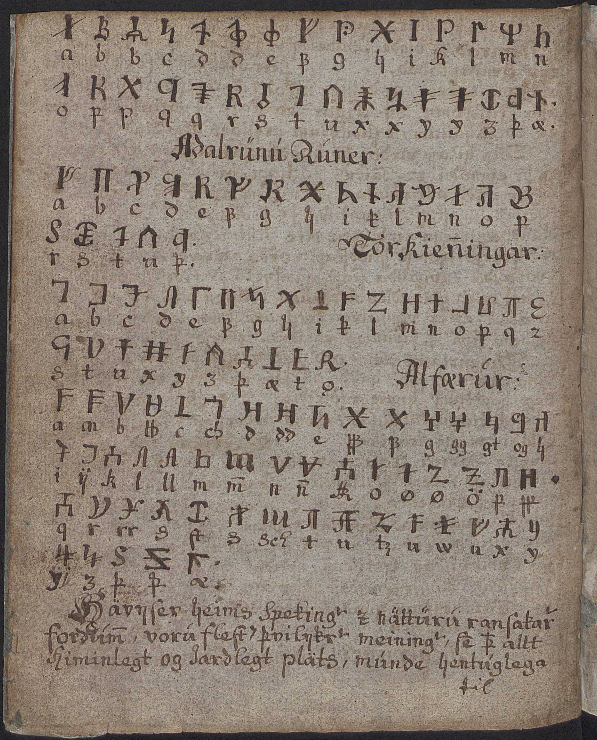


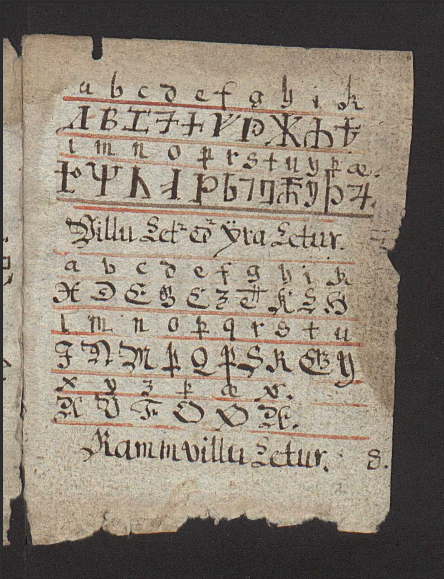



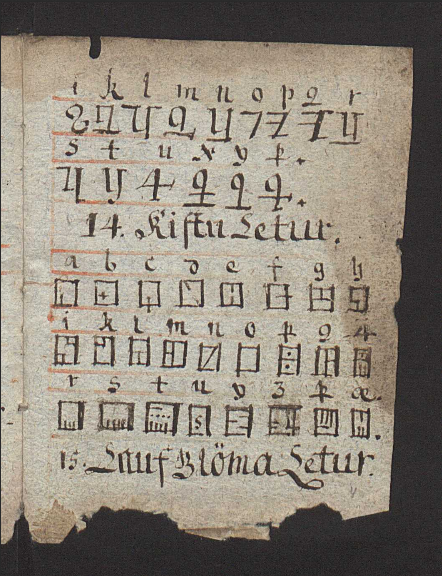
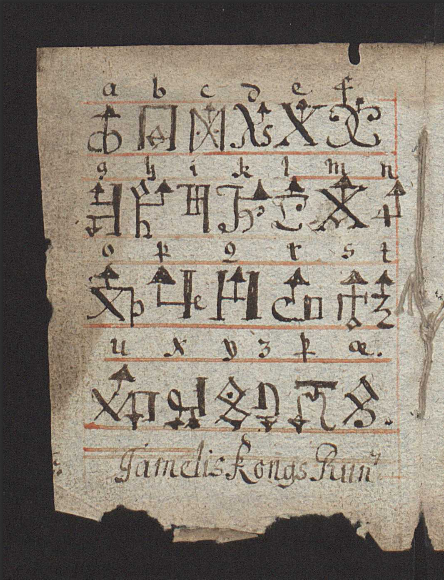

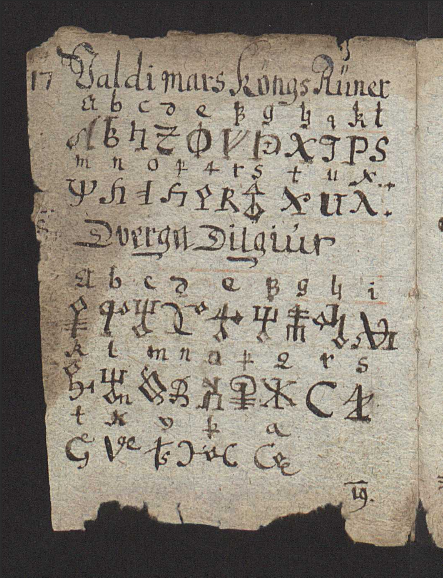


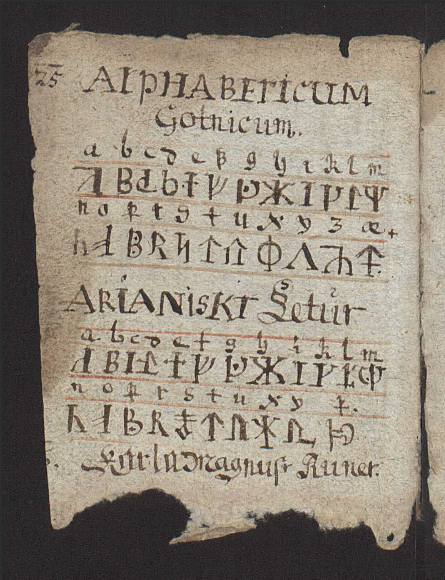
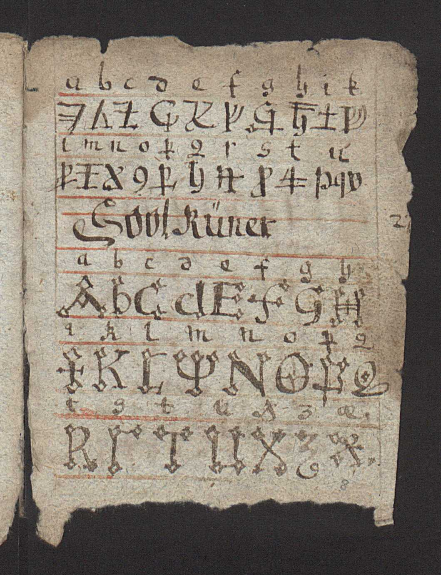
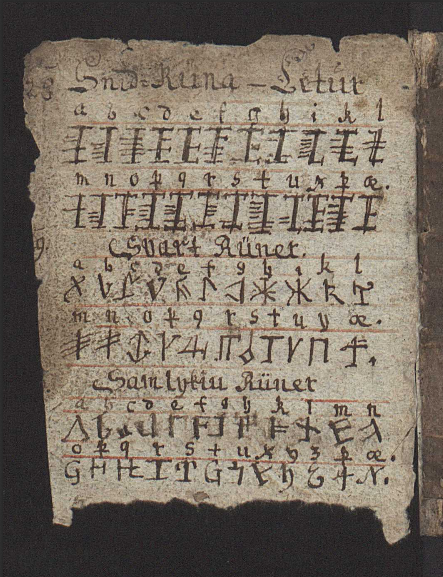
some random page, in here because could speak of the order of those signs, what else could that sequence be:

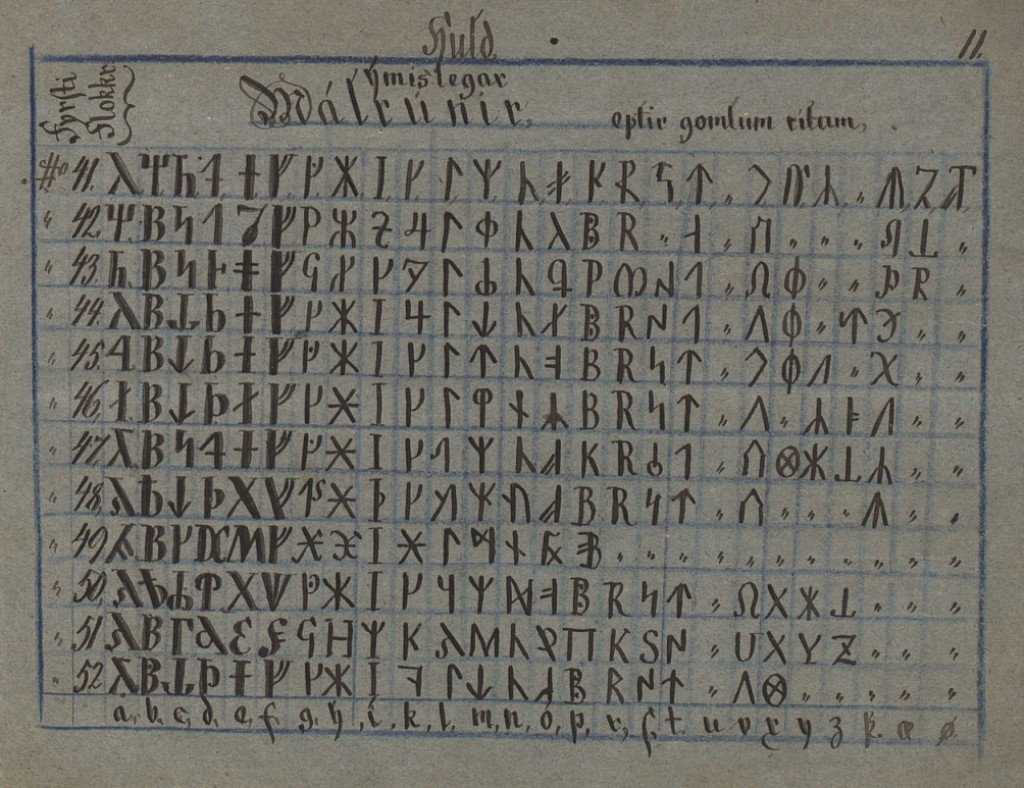
I couldn't find lines one to forty, but this si here, because it is witness of ᚢ being of V, just as axial structure dictated it to be. But then I found other pages, and many of them tell the otherwise:

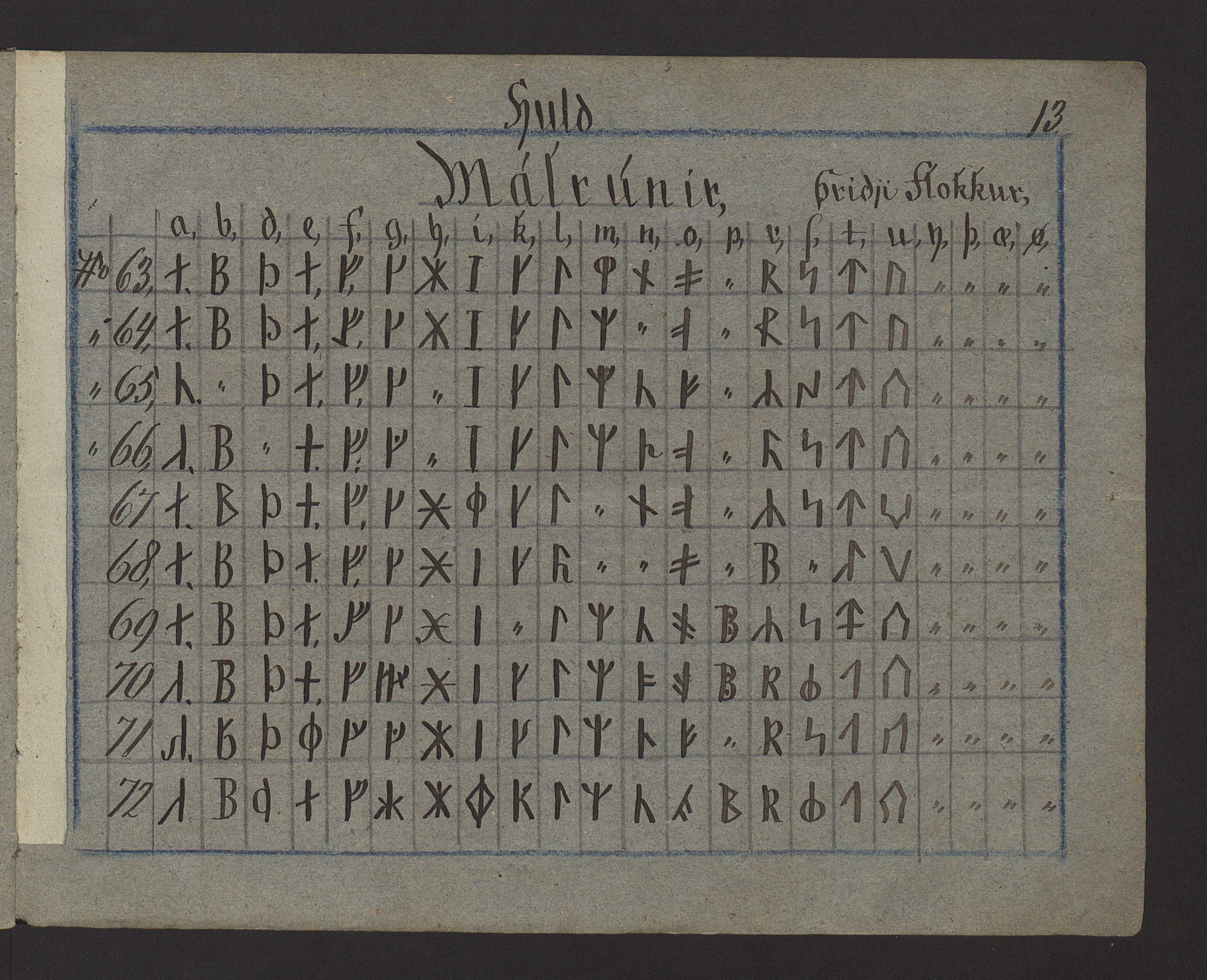

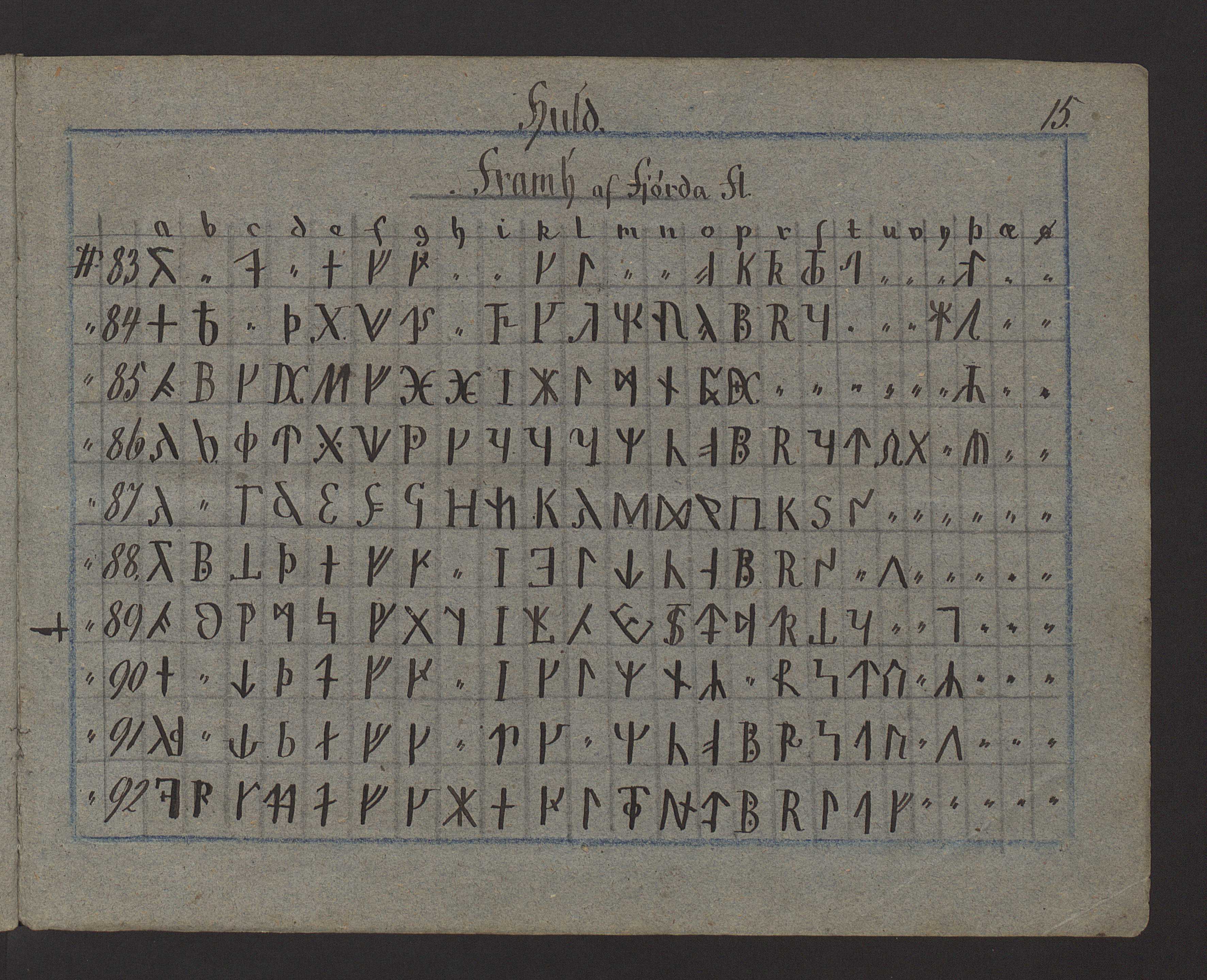

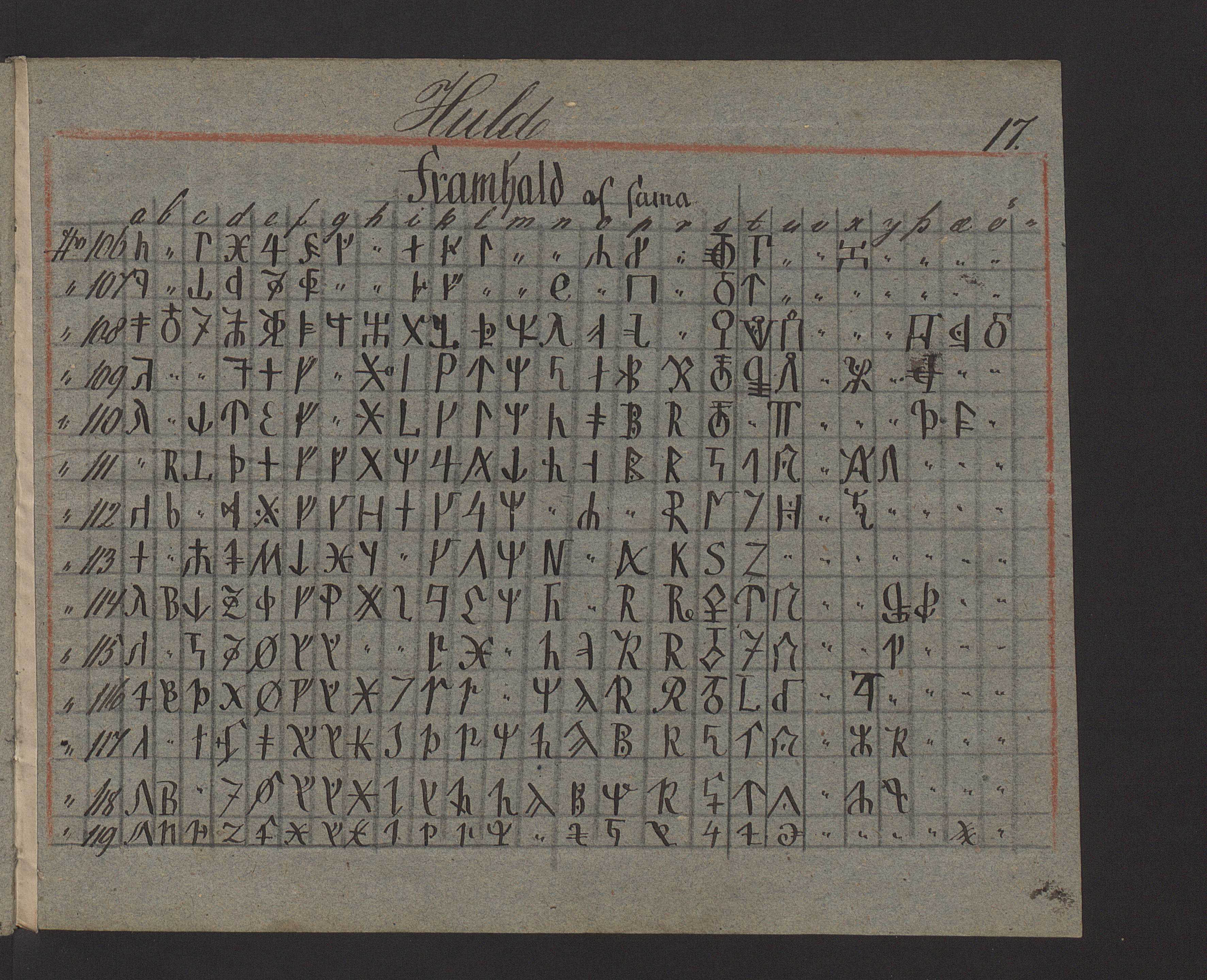
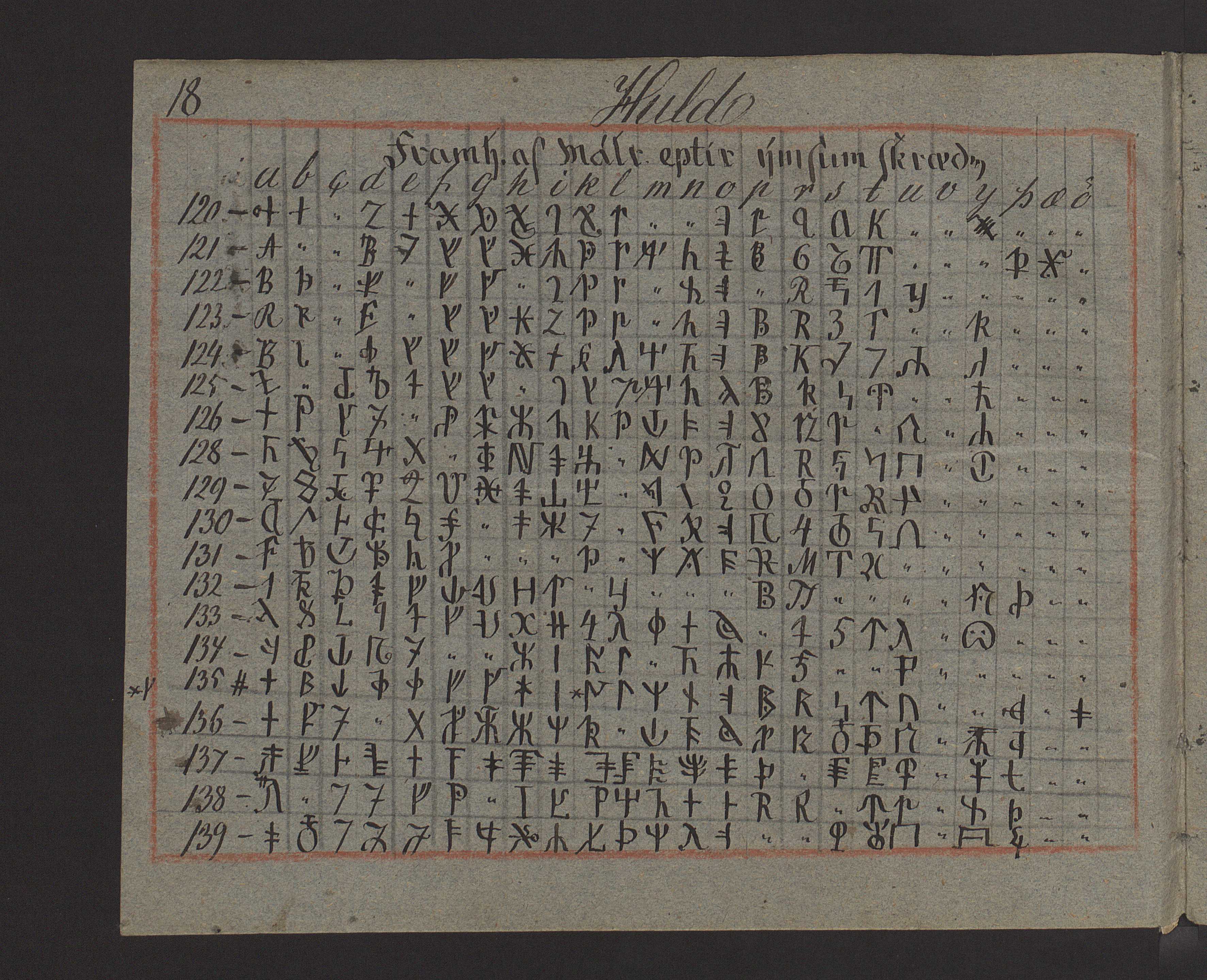
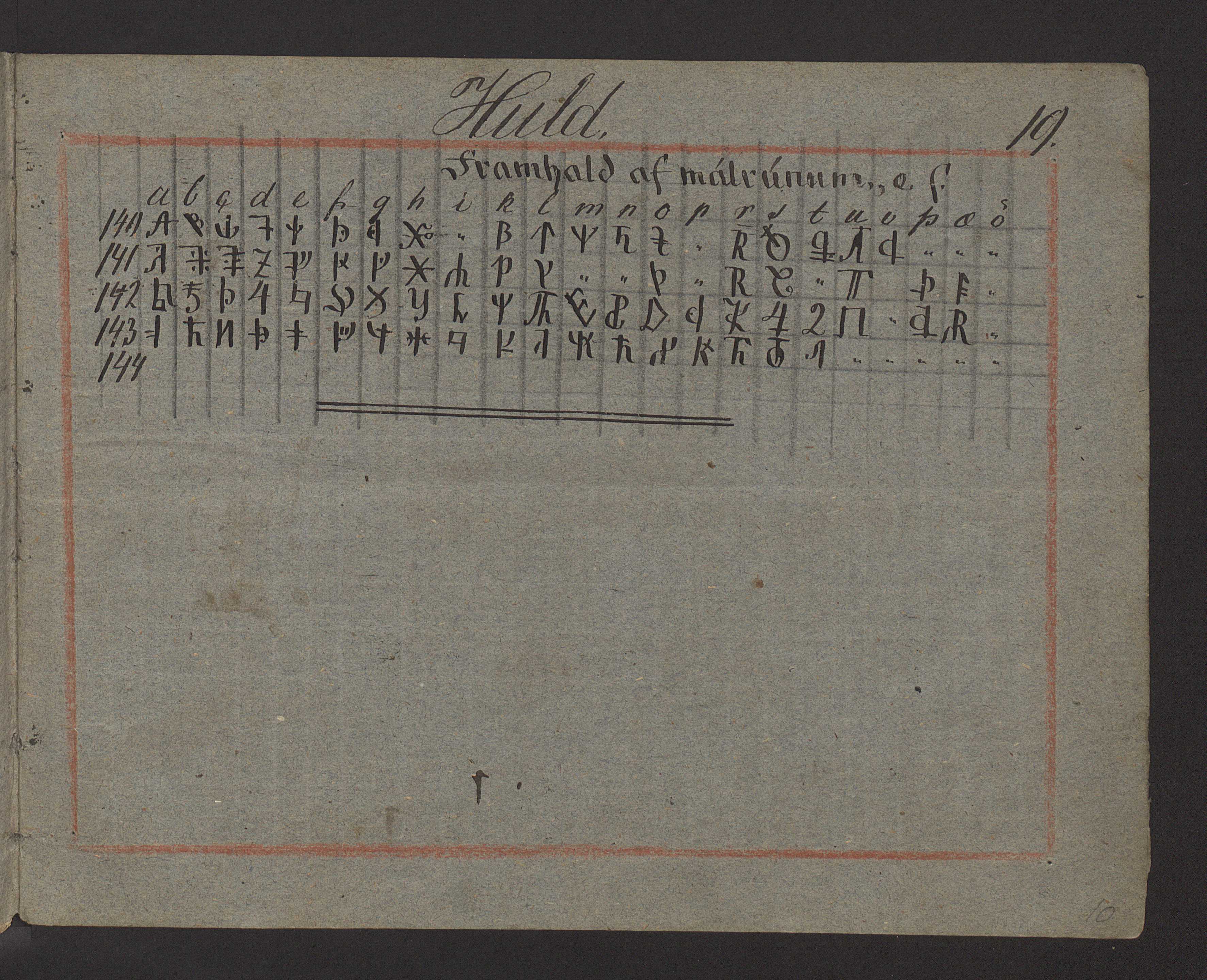
and there are much more, but most of them make me ask if it is not all bs
demon ~ demand?
My demands are philosopher's stone, which I push, And if it is that archetype, I should push it in a hole.
home = холм
And the same
бета
better
лучший
лучший зверь
лучик Тверь
Лучшее враг Хорошего (Христа, God~~Good)
I understood it when I saw myself as a demon (Devil) and my brother as Good.
it's that брат~враг thing.
сатира задира
Looking for adequate synonyms to бухать, because it bothers me
Я тоже программист, но я в языке живом программирую, нахожу баги. Пить в значении бухать -- не только русского языка проблема. Не пригуби от слов губы и губить. губы чётные, женские, иньские.. инь июнь? ян январь?
jule & july?
yule / july - как две точки на симметричных понятиях, звуко-смысловую карту языков, где языки многожильными кабелями представлены, жилы которых перетекают то в один кабель то в другой
(жилы тех кабелей - слова, по звучанию определяемых, разветвляющихся дальше, будучи тоже многожильными быть может)
Хочешь ли ~ Хочешь ни
л ~ н
l ~ n
l ~ n, n ~ m, lmn are all of something similar? ΛΜΝ? horizontal pulse? SΣZ are vertical.
Mother lays. Father stands? 𓈖 is something liquid? some 𓃂 could stand for something firm. The first thing I saw: mountain giving birth to river. let;'s hunt for other candidates: 𓃀 𓄙 𓆄𓆅 𓆗𓆘 (compare cobras to 𓆙𓆚)
Those
CУмАсшеДшИЙ
CуМасшЕДшИЙ
CУмасшЕДшИЙ
блаженный~святой
(дабы не порочить царский род? даже дурачков нарекали блаженными?)
LiFT ~ eLeVaTor
LiFT ~ eLeVaTe
lovely love (любовны? любимы? милы)
heavily heavy (едва ли. ЛИ! heavy~едва? е2? as in e2e4?)
steadily steady (steady spoloiny, steadily spokoino. ли~не~но?)
widely wide (широко широка)
ly is "some suffix? ^ tje Λ the Λ
tje is dutch way to palatalize, it's my subconsciousness tells me that it's чьё, чё, что, that, the~whe? t~v? again? or is it the same)
real really (истина, истинно) (истинна истинно)
правда правота
right truth
право правда
(да is the? this? he?
הוא (ху, он)
היא (хи, она)
tell me that hebrew recognizes י as yin and ו as yang.
english sees h as yang and sh as yin
human and ʃuman of human behaviour
Id d Is staved form supposed to be male? The difference between boy an girl is that boy has that stick ...and girl has that seam.
Synecdoche CLB
CLB as Celabinsk for it's a celebrities and clubs.
soviet, or even presoviet tomonymous suffixces are -na (Lenina st is of lazyness na (where nah stands for nahuy) Gorky park is gorey, горе[gore] is sorrow, g~s!)
sad гадко
sell сливает?
buy покуПАЙ, пай-пай (покупай (п-ай) и продавай (п-ай))
bye bye (both say bye to their money or product, both say bye to the man behind that deal)
by moneyh by product we both keep on rolling taking products or funds.
shit говно (гов~cow, so they say, is shi~she~~му?
meditating to ᛂ and ᚼ(or ᛡ)
I thought of ᛁ and how ᛡ is sometimes ᛆ which makes this set of vowels very symmetric, but there is still ᚮ but who knows what it could be, if it's double ᛆ. Or is it all apophenia?

I think the ᛄ (not ᛰ, this is belgthor, ) or maybe also ᛳ or ᛜ or ᛝ or ᛟ is o.
ᛮ
Arlaug, probably tells the actual names of ᛆ and ᛚ, abinderune of which it probably is.
ᛯ
tvimadur or tvímaður (may tell that ᛘ is maður (man) and ᛦ is tvi)
Wendehorn is a pseudo-runic symbol resembling the Tvimadur symbol. It is allegedly a bindrune of the Man and Yr runes, symbolizing 'life' and 'death' respectively. The term is due to Guido von List's Das Geheimnis der Runen, where it does not figure as a full member of the Armanen runes, but is mentioned in the context of the crescent moon being "the rune of Freya, who promotes childbirth."
(it's funny how they speak of what thety consider pseudoscience (which it is probably not) more than what they say of the actual signs of runic calendar, they speak about them all three when they speak of runic calendar.
TviMathur is second mother?
ᛰ
belgthor (ᚦ is thor, and some opposite of it is belg? is it ᛒ the B, the b opposing the d of ᚦ the D?)
Then this is ver+dandi
And here I notice that ᛮᛰᛯ is abt
But then I think the order is ᛮᛯᛰ, atb, but it is great, because we have ᛘ in ᛯ. But ᛰ looks like Ф
ᛘ is ᛙ, but it could be nothing. or rather al mt db
or rather al tm db,
or rather la mt bd (lmn?)
This paragraph is rather useless, because it is raw, I think I think about it for the first time.
better лучше (люцифер (лучший зверь (я значю что свето нос, но best~beast)))
лучшее враг хорошего, и это прикольно, что мы выбираем между лучшим и хорошим, что идём от хорошего к лучшему и к ещё более хорошему (ещё боли и хорошемиу. after laughter come tears?)
prive pride comes before the fall.
if heart is of heard
and сердце is of серёдка
then heart~hertz~сердце is not likely
(h~s would be nice within this story, but some of those line is wrong, so it seems, unless they're one sequence and for example середина could derive from сердце, which came from some seritsa~slyshitsa, but it is a big question yet to be understood)
(here used to be a very fucked up story, I decided to cut it out, because it was way too fucked up even for this thing, and it was rather off-topic, so now it's in taboo folder where it belongs)
И на этой весёлой ноте, vol.21
...
